Don't wanna be here? Send us removal request.
Text
Every Game I Played in 2024, Ranked
Another year, another ordered list of video games. I've decided to abandon the major distinctions on release year because who cares.
Continuing honorable mention: I played a fuckton of Dwarf Fortress this year, as in previous years. Dwarf Fortress: still rules.
2015 | 2016 | 2017 | 2018 | 2019 | 2020 | 2021 | 2022 | 2023

14. Final Fantasy IV Pixel Remaster - 1991 / 2021 - Steam - ★★★
Look: I get it, FFIV is an Important game as far as RPGs go. It has a lot of cute moments and characters and that classic Final Fantasy charm. But as someone whose Final Fantasy gameplay experiences start with 5 and end at 12: Boy, this game lacks a lot of gameplay depth huh.
It still has all the typical-yet-interesting Final Fantasy boss weakness gimmicks, but there's an odd lack of the "building" aspect of RPGs. Characters gain levels and stats, and you can gear them up... but there's no actual decision making. Any unique aspects of equipment ("hey this one resists XYZ element!") do not matter when the base stat growths will fundamentally always matter more. It doesn't even take advantage of its large "playable" cast as you can't actually choose who is in your party at any given time. It is a very linear, hand-holdy experience that honestly feels incomplete when looked at with 2024-eyes.
I did enjoy my time by-and-large with FFIV, but particular towards the end I was forcing myself to finish it mostly out of a sense of sunk cost. I don’t think it has aged especially well.
That said: the Pixel Remaster aspect of it is a fine port. I do wish these pixel remasters included the stuff from the Advanced versions though. The Advanced version of IV even bothered to let you pick your party at the end!

13. Warhammer 40K: Mechanicus - 2018 - Steam - ★★★
I'm not sure whether Mechanicus is too long or just fundamentally missing some additional mechanic that makes it last into the double-digit-hours.
It's an enjoyable enough tactical game, with some really neat mechanics built around a dynamic action economy, but once you upgrade your Tech Priests and solve that action economy, everything goes off the rails. The difficulty curve is quite lop-sided; the first few missions were quite intense, but while the game keeps introducing more advanced Necron units to combat you, it's just not enough to keep up with what you're capable of. By the end it's trivial to twerk on even the final boss in a single turn.
Soundtrack is excellent, and I'm still quite interested in Mechanicus 2 so hey.

11. Warhammer 40K: Space Marine 2 - 2024 - Steam - ★★★★
The sequel to 2011's most surprisingly decent third-person shooter, Space Marine 2 is... largely ok! Ironically it's a bit buggy at times, and it's definitely better suited towards multiplayer than singleplayer as far as the campaign goes. Said campaign is... well, it's a Warhammer 40K campaign. You run around and shoot at bozos while yelling FOR THE EMPEROR a bunch. Last time had Titus fighting orks and general Chaos dipshits, now he's fighting Tyranids and *specialized* Chaos dipshits. Could use more enemy variety, perhaps with more... tactical relevance to the units? As-is you have a few must-kill annoying units but otherwise the combat can be pretty brainless.
It's not groundbreaking, but the Warhammer setting polish present here is pretty good. Servo skulls and cherubs galore. It's still funny that they *insist* on every one of these games starring an Ultramarine, when seldom do they bother playing into any of the stuff that makes Ultramarines interesting. If you're just running around shooting games and going GRRR, that could be literally anybody. Yeah, Ultramarines are the default these days, but you could just make a new Chapter with some interesting gimmick, or bring in one of the more thematically or mechanically unique chapters then. Honestly: Should have been Dark Angels.

12. Marvel vs Capcom Fighting Collection - 2024 - Steam - ★★★★
it's mahvel baby
Good collection, I enjoy dicking around in here with friends. Doesn't bring anything particularly stunning to the table beyond the included products, and I'm not exactly planning on grinding so I can get Wazzler'd into oblivion. Them going out of their way to fix certain glitches but then patching the game to add a toggle to enable the Juggernaut glitch is very funny, I approve.
Pricing is a lil whack for what it is, but hey that's modern video games. Where's a new Capcom Versus game?

10. Crusader Kings III 2024 DLC - 2024 - Steam - ★★★★
CK3's DLC for the year was "Legends of the Dead", "Roads to Power", and "Wandering Nobles."
Legends of the Dead added plague and legend mechanics. The plague stuff is good, though it's either devastating or easily defeatable with little in-between at the moment. There is some anachronistic aspects I wish they'd change (isolating one's self away from the plague is a modern idea that would be alien to the time), but I understand that it's hard to handle people trying to metagame the realism of isolation otherwise. The legend mechanics are straight up mediocre; the act of formally promulgating your legend and paying folks to share your legend is just odd, and said legend benefits mostly you in life rather than your descendants after your passing. It's also oddly different from the existing reputation mechanics while thematically overlapping a little to much. I get that information is itself basically a disease that spreads in similar ways mechanically (mgs2-memes.jpg) but I don't think they did a good job with it here.
Roads to Power revamped the Byzantine Empire to make it more historical and appropriately unusual, and also added mechanics for dethroned nobles to wander the world seeking fortune in various non-land-owning ways. This DLC absolutely whips, just so many cool mechanics to interact with. Is it still in need of polish and balancing? Yeah, Byzantium is perhaps too powerful if it doesn't get crusaded early, and landless nobility are often weirdly strong if played properly, but overall: cool. I've done multiple campaigns as a wandering noble, including one where I was a mercenary hired by a Byzantine duke to help them in their wars, got some land off of it, managed to take over their holdings, survived the fall of Byzantium to a crusade, lost it all in subsequent Byzantine civil war after the Empire was reformed, and then the family returned to mercenary work in Italy... which I managed to levy into getting a descendant to become King of Spain. Coooooooooool stuff.
Wandering Nobles is... weird? It specifically just adds some more events (always good) tied to travel, and added some new lifestyles tied into that. It's weird having lifestyles outside of the skill pentagram but hey, if Stellaris can get do it so can CK3.
My main hope for CK3 at this point is that they'll get a Custodian team like Stellaris that enables them to continue to polish and better integrate old content, since they seem to be doing a great job on Stellaris (which I've taken a break from this year.)
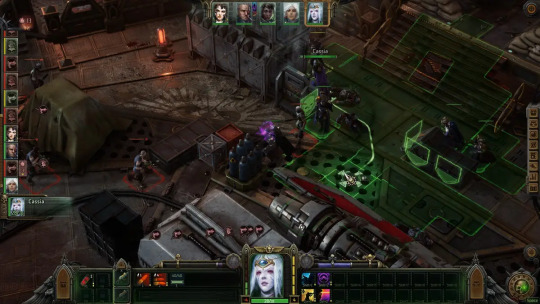
9. Warhammer 40K: Rogue Trader - 2023 - Steam - ★★★★
Yep, another Warhammer game. Been one of those years.
Rogue Trader could have been even higher up this list. There's a lot about this game that I really love. It's kind of the best example of the Warhammer setting in a video game, managing to capture the totality of how really shitty the setting. It gets across just how shitty life in the Imperium is, the casual cruelty of life. It gives you the option to try to be a Nice Guy, but also explicitly points out that this is not really looked upon well and can outright lead to your death depending on how things play out. The plot is kind of whatever, but it has some great set pieces and fun characters.
Gameplay-wise, it's a bit uneven in terms of difficulty- kind of easy in the back half even at the higher difficulties (like I said in the Mechanicus review: it turns out, knowing how to game an action economy helps a lot!) Some characters just are stupid busted throughout if you use them correctly (cough Cassia cough), and the way the RPG mechanics work you're almost never facing a non-100% skill check.
Owlcat isn't the biggest studio, and the game in general lacks a certain degree of polish that must to stem from their team-size and budget. The non-cutscenes where you essentially read a summary of what the cutscenes would have shown are... odd, if ultimately tolerable. But frankly, I'm still tempted to lower this in the overall ranking because the amount of weird gamebreaking bugs I encountered even playing it an entire year after initial release is absolutely infuriating. There's certain mechanics that have a tendency to just shit the bed, causing quests to just not trigger which can combine with points of no-return to lock you out of content. That kind of thing drives me absolutely nuts.
Also, because I want to complain about it and hey why not: the load times are maddening. Traveling between planets requires something around 5 different loads, more if you trigger one of the RNG events that require your intervention, and they're just too damn long. It adds unnecessary tedium to what is already a long game. And hey, guess what is the mechanic that tends to shit the bed? That's right: quest starts that trigger only when you travel between systems! Great!!!
It's only the core quality of the game as a 40K experience that keeps it where it is in-spite of all that. Congratulations?

8. Indiana Jones and the Great Circle - 2024 - Steam - ★★★★
Man, I am in two minds on this game. MachineGames is a fantastic studio and I really enjoy the tone of their writing. This is probably the best Indiana Jones has been in... 30 years? But something about this as a game just isn't fully clicking. The big selling point is that you are getting the experience of being Indiana Jones, which... sure?
The gameplay is serviceable; the first-person brawling is okay, if pretty bland. Since a lot of the game revolves around that: okay, not great. The exploration stuff is cool, and the puzzles are... well, they're video game puzzles. This is no Return of the Obra Dinn. But the experience of doing the puzzles is fun!
Honestly, the best part of the game may just be as a looking-around-and-looking-at-stuff simulator. You put loving crafted artifacts and news paper articles and books around and I'm going to stop and look at them and go "huh, neat!" Spent a not insubstantial part of the second-part of the prologue just looking at random museum pieces while ominous spooky man chanted in Latin a room away.
I guess to the answer the question of "Does this feel like Indiana Jones?" my answer would be "Perhaps too much." It does a great job of capturing the feel of the movies, the setting, and the feel of Indiana Jones action, but it doesn't bring much of anything new to the table. The game is best when its more evocative of the brilliance of MachineGames' Wolfensteins, with its amazing side characters, goofy cutscene shenanigans, and amazing setting-specific set pieces. I wish it'd lean harder into that instead of the films.
Unrelated to that point: It's very funny that Indiana Jones ancillary media has consumed most of the "interesting" historical artifact / archeology tropes, such that this one had to juice the story with five different gimmicks layered on top of each other. Not going to spoil any of it, but we're starting to approach the territory of "Indiana Jones and the Biggest Foot" which frankly I'm here for.
Anyways: Raiders > Last Crusade > Temple > This > Dial > Skull

7. Dragon's Dogma 2 - 2024 - Steam - ★★★★
Dragon's Dogma 2 is... more Dragon's Dogma? Honestly, this is my first time playing Dragon's Dogma myself rather than just watching others play it, and I enjoyed it a fair bit, but it is weird how little seems actually changed from the original?
It's a new world and a new engine, and certainly there's been changes to things like mechanics and quests and NPCs and adding new bosses etc... but so much of the game is the exact same, even retaining the old jank I've heard people complain about for a decade now. It's incredibly fun and even funny at times, but I think it could have used some more time in the oven, some more polish, maybe just more resources for the team to add to the experience. Also: could really do with a couple more enemy types. Things can get pretty repetitive after a point.
The decision to do essentially the same plot again when the "twist" of the original game was so well received is odd. The new elements they layered ontop of it to differentiate from the original only to make the core plot less interesting. The more I think about it, I think I'd prefer they have done something more unique in the vein of OG Dragon's Dogma rather than just completely carrying all the architectual details of the setting over to this release.
A shame that Dragon's Dogma 2 seems like it will never receive its own Dark Arisen.

6. Castlevania Dominus Collection - 2024 - Steam - ★★★★★
This collection bundles my favorite Castlevania games into a single package. Enuf said.
You should play Order of Ecclesia, it's a great game.
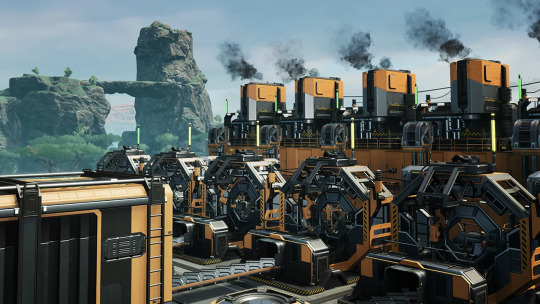
5. Satisfactory - 2024 - Steam - ★★★★★
I am very aware of my gaming habits: I'm a gorger. If I REALLY enjoy a thing, I shove it into my mouth until either it's gone, or I get sick of it and throw-up. This is why I avoid early access releases as a rule; I know I'll fill myself up on the appetizer and have no room for the meal. From afar, it was obvious that Satisfactory was something I was going to enjoy, and so I waited for the full release...
And hey yeah Satisfactory is an excellent addition to the "technology-tree time-hole" genre. Organizing infrastructure and automating a 3D factory layout that is constrained by geography and resource availability is awesome. There's some open-world exploration and mild combat aspects that are fine mostly as a way to add more technology-tree gating, but the focus really is on constantly tweaking or redesigning factory spaces to better use space and resources to produce widgets to advance progression or build *other* widgets that let you make other bigger things etc etc.
There was multiple times when hanging with friends on Discord where I made the offhand comment of "I should probably eat something..." several times over the course of an 8 hour period, as friends got increasingly exasperated at me time-holing myself ever deeper in factory optimization instead of making a sandwich or something. That's the kind of game Satisfactory is.
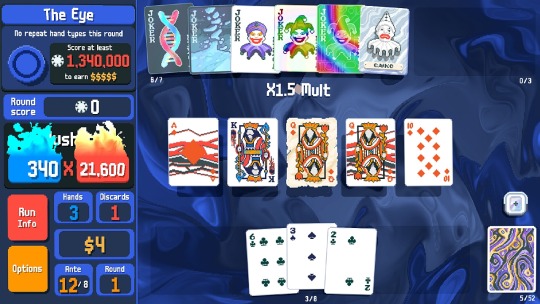
4. Balatro - 2024 - Steam - ★★★★★
Balatro is far better than it has any right to be. Why the hell is a run-based deck-building poker game so good? How does it manage to hold up after over 80 hours?
There's something Tetris-esque about how you engage with Balatro. It's a puzzle game that is zen-like it how it engrosses you. Failure is inevitable, you're just seeing how deep you can go with your luck and deck-building skill.
To voice a mild criticism: the nature of the RNG and the gameplay (cards) makes it hard to "outplay" certain bad rolls on Jokers, particularly early on. Truly good runs are very luck-dependent, and you often have to commit very early to a game plan (e.g., all-in on Flushes) before you know that you're going open the Jokers that make that game plan work. Nature of the beast, but it does lead to me leaning on the secret quick restart (hold R on keyboard) a bit too much as a result.

3. Elden Ring: Shadow of the Erdtree - 2024 - Steam - ★★★★★
Elden Ring was nearly my Game of the Year in 2022, and Shadow of the Erdtree is a fantastic addition to it. There's amazing new bosses, weapons, and areas. As a Lore Enjoyer, I appreciate the additions made to the overall narrative and setting of Elden Ring, and the music is pretty excellent, a criticism I had with the base game.
That said, it does suffers from similar flaws as well: exploration is kind of weak, with big empty areas dotted with little nuggets of content. There's some bosses that are real stinkers, with tons of health and tedious attack patterns. Frankly, they ramped up this aspect here; it feels like they took the wrong lessons from Malenia. Also, good lord do I hate the Furnace Golems, what an obnoxious enemy.
But the good bosses are some of the best From has ever done, and the little mini-dungeons are far more interesting than anything in the base game. Playing through the DLC was a real treat.
The fact that there's an Elden Ring multiplayer run-based spinoff coming next year is absolutely mental. While that's not necessarily what I'm usually looking for in FromSoft titles, I'm all-in at this point.
youtube
2. Caves of Qud - 2024 - Steam - ★★★★★
If you encounter a dreamcrungle in the depths of the Moon Stair, beware their crungling gaze. If you you are crungled, you’ll be subsumed into a dreamscape where you’ll awaken as some other entity, perhaps a bear, maybe even a robot. If you gain sufficient experience in your newfound form, you’ll awake pleasantly enlightened, the dreamcrungle sated. However, if your original body dies as you dream, your temporary oneiric will come to a final tragic end, your mind dissipating into nothingness. A tragic end, but that is itself all too common in salt-blasted land of Qud.
Caves of Qud is the ultimate roguelike, perhaps the ultimate RPG. It is alternatively weird, goofy, and funny. You will die in so many inexplicable ways. But the knowledge you gain from those deaths will make you ready for future adventures, with different characters and paths. My current adventurer is a mutant tinkerer with four arms, each wielding an axe. He’s specialized in the art of multi-weapon fighting, allowing him to use his many arms to slice foes to pieces in a blink of an eye. But I could also be a potent psychic that dominates people, a birdman gunslinger, a birdman swordman, a cyborg knight, and so many more things besides. I could use a spray-a-brain to give life to a chair, then transplant my mind into that chair as my original body dies, continuing my adventure as the chair.
There are thousands of ways to build your character and progress through the world. The dynamic worldgen and mechanics interact in ludicrous ways. Almost everything on Qud is sapient and a member of an overarching faction. Who you befriend— or kill— can have wide-ranging and sometimes absurd repercussions. For awhile there I was persona non-grata with turtles, which made traveling through desert canyons an interesting challenge. But I can always rest easy knowing I’m beloved by dogs, welcome in their holy places.
For all the “wacky” aspects of the generated world, the setting and non-generated writing of Caves of Qud itself is quite excellent. The nature of Qud, a place both seemingly post-apocalyptic and futuristic, is one I leave you to discover. Live and drink, friends.
Also, as a weird side note: I’ve been playing exclusively on controller and it works exceptionally well? That seems like it shouldn’t be the case given its general aesthetic, but here we are.
twitch_clip
1. Robot Alchemic Drive - 2002 - PlayStation 2 - ★★★★★
OK, look: I realize how fucking bonkers it is that Robot Alchemic Drive, a game from 2002 you have either never heard of or never thought about for longer than five seconds is my 2024 game of the year. Here’s the thing: RAD fucking rules.
RAD is best described as super robot QWOP. You control a giant super robot using an unusual set of controls where each joystick is mapped to the mecha’s arms, and the motion of the stick controls how the punches are thrown. The shoulder buttons give you manual control of each of the robot’s feet, stepping forward and backwards. Additional buttons and inputs enable special attacks like missiles, rocket punches, diving super kicks, etc. It’s a really bizarre system that makes up for half of the game’s difficulty.
The other half is because you’re not piloting the super robot. You instead control an additional character in the world who is operating it from afar, like Tetsujin 28 or Giant Robo. This puts the player character in the middle of the danger, forcing you to position yourself so you can actually see what you’re fighting while also keeping yourself as best you can out of danger. Sometimes the building you’re standing on gets knocked down under you. Sometimes you accidentally blast an alien robot so that it falls on top of you. You can sit on your robot’s (a “Meganoid”) shoulder, giving you the best possibly vantage of the robot you’re trying to control, but that also puts you at risk of getting punched off it and sent flying for three blocks.
So you’re awkwardly controlling a giant robot to fight other giant robots while you can barely see and the city is getting blown up around you, often by your own arsenal as you attempt to defend it. This is a problem, as you need to try to minimize damage to the city to ensure you get money to upgrade your Meganoid. Being careless also puts Nanao’s current place of work at risk, and nobody wants that.
Oh Nanao. A not-insubstantial amount of the game revolves around your childhood friend, Nanao, who is in the depths of poverty and working like 5 jobs. Her grandma, home, and workplaces keep getting destroyed, which doesn't help. Nanao, while nice, is the dumbest child alive who must be protected at all costs. A non-substantial part of the game is built around trying to protect Nanao’s workplaces, “accidentally” destroying businesses that threaten her livelihood, etc. On the flip side, if you are for some ungodly reason anti-Nanao (???), if you destroy Nanao’s workplaces consistently throughout the entire game Nanao will take her own life. This is an insane mechanic, but given the easy emotional attachment to Nanao: it certainly raises the stakes!
RAD’s writing is deliberately cheesy as hell, and it’s paired with a dub that is absolutely spectacular in how corny it is. They hired a company that exclusively made corporate instructional videos, zero audio direction was given, and boy does it show. It is one of the funniest games I’ve ever played, the writing and the voice acting together are just so unbelievably stupid. God I love it.
It is crazy that people don’t know or talk about RAD. The developer, Sandlot, exclusively makes Earth Defense Force titles now, with RAD all but forgotten. Part of the reason, I have to imagine, is that it didn’t run great on actual PS2 hardware— but emulated it runs like an absolute dream.
Is it a perfect game? Absolutely not. But it is by far the game that made me smile the most this year. An absolutely unique gaming experience unlike any other. Someone should port this to modern technology, put out PC or something, get it in front of more people because holy shit.
#nonfiction#think piece#game of the year#video games#robot alchemic drive#nanao#caves of qud#warhammer 40000#balatro#elden ring#casltevania#dragon's dogma 2#satisfactory
19 notes
·
View notes
Text
Every Game I Played in 2023, Ranked
I debated moving this list to Cohost (after all these years, the Tumblr text post interface still makes me want to punch a wall) but whatever, here we are! Keeping it relatively short this year.
A lot of the games I played aren't going to be on this list because I don't have much new to say about them (MTG, Dwarf Fortress, Strive, etc), but for those that I do, here's the games I played this year.
2015 | 2016 | 2017 | 2018 | 2019 | 2020 | 2021 | 2022
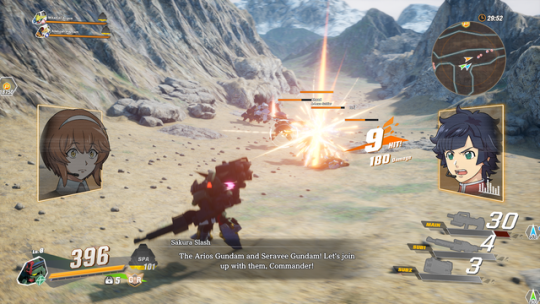
SD Gundam Battle Alliance - 2022 - Steam - ★★★
I really wanted to like this- you know I like me some Gundam- but the experience is simultaneously too thin, too grindy, and bereft of stakes. There's nothing like "oh no we have to preserve the Gundam metaverse from hackers ruining the archived story!" to make me go to sleep.
There's something about the progression system of every "hey, gotta catch 'em all!"-ish Gundam games that is designed exclusively for people who either played these games in the early 00s, or people with addictive personalities. There's been little in the way of evolution. Yeah, the gameplay here is different as a sort of Action RPG, but this is far more Dynasty Warriors than it is say Armored Core.
Just not for me!
... Where's my new Super Robot Wars at damn it?

9. Pokemon Scarlet/Violet DLC - 2023 - Switch - ★★★★
I talked last year about how I mostly liked this game in spite of its many, many issues. The DLC mostly plays to SV's strengths: fun plot and characters, improved open world catching system from Sword/Shield. They also run considerably better, due to a year of opportunity to make things more stable and address bugs.
That said: It doesn't address any of the other issues that have always been there. Open world exploration becomes kind of pointless when you have the ability to invalidate any level geometry. There is such a thing as too much mobility, believe it or not, when you can just jump over everything. At the same time, the ways cutscenes work is soooo slowwwww, to the point that getting through them to the "action" can be quite tedious.
This DLC also continues the unfortunate thing that drives me nuts about all these DLC, that the level scaling is just awful. It basically assumes you have done literally nothing since finishing Scarlet Violet, and not engaged at all with the post game. Which hey, works out for Lil Timmy who is experiencing this DLC in-line with the base game or only after beating it (since it does dynamically scale for earlier progression), but it makes the whole thing kind of a rote exercise for those who actually played the game more than that?
I realize this is multiple decades now of me barking that hey, it'd be nice if Pokemon didn't exclusively try to appeal to 5 year olds, which is definitely a lost cause at this point. We don't even get stuff like Battle Towers or Frontiers anymore really. Ah well!
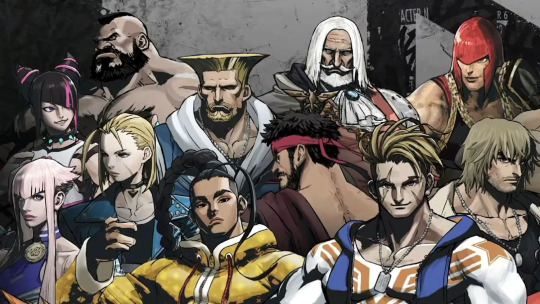
8. Street Fighter 6 - 2023 - Steam - ★★★★
Ok, here's the thing: Street Fighter 6 is overall a very good game, lots of care and polish, but I got a few bones to pick with it.
1. I kind of hate its input buffer. Just drives me nuts, particularly with how it handles supers and specials with overlapping inputs.
2. World Tour while is neat, the progression of it is so goddamn grindy and miserable. So much HP for enemies as you go on, and you don't have access to a fighter's full skill set even at the very end due to how special "slots" work.
3. The cast feels too safe. I like the new additions a lot, and in general the old chars have been rendered quite well, but there's just not a lot of innovation going on. The system mechanics are quite good, but it's the thing where no one on the cast really calls out to me. Personal taste thing.
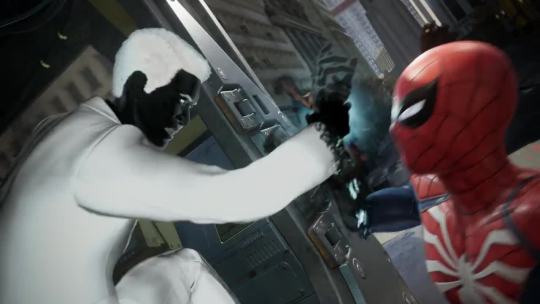
Marvel's Spider-Man - 2022 - Steam - ★★★★
I don't think I have anything particularly unique to say about The Spider-Man Experience beyond hey: that's a pretty good Spider-Man. I think the DLC was obnoxious as shit, and a number of the decisions tied to box-checking-completionist stuff were mean for someone like me who has the stupid brain that thinks it's important to do Everything no matter how tedious it is, but overall: a good Spider-Man. Some of the villain stuff felt pretty weak though.

7. Resident Evil 4 Remake - 2023 - Steam - ★★★★★
A great remake! They trimmed down some areas a fair but, but none of them particularly egregious (some of them, particularly a last act boss being removed, was quite appreciated), and the mechanical additions are fun.
Does it invalidate the old version? I dunno, maybe?
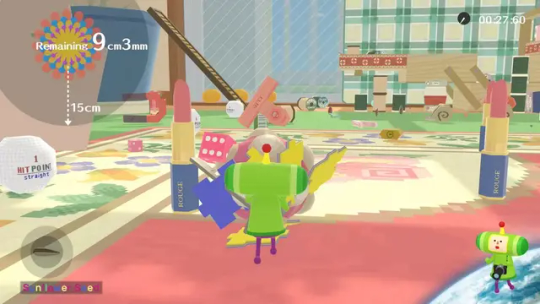
6. We Love Katamari Re:Roll - 2023 - Steam / Switch - ★★★★★
Hey, you know what's also a very good game? We Love Katamari. Not much new to say beyond hey: the name is accurate, and you should buy and play it. I liked it enough to buy it twice on two platforms, which is silly but it gave me the excuse to play more Katamari so quite understandable.
A thing that does annoy me about the game is them reusing certain models from the other Katamari Remake, even when they were deliberately replaced in We Love Katamari and are even called out as different in the item descriptions despite not being so. Arrgh. It doesn't really matter, but I got the dumb brain for that kind of thing.

5. Granblue Fantasy Versus: Rising - 2023 - Steam - ★★★★★
A fighting game that I enjoyed years past now has actually good netcode! The mechanical additions have been very nice, and I've been enjoying myself grinding away for my meager gains. It's also funny having skipped all the base game's DLC and coming in now, since it's like this release just added 20 more chars I'd otherwise not engaged with before.
A ton of polish has made this a fantastic package across the board, so many smart decisions and little details. I'm sure for GranBlue gacha fans it's probably incredible as something that pays tribute as well.
… but see, my main annoyance with the game mostly ties to being unable to stand the source material it pulls from. It's not enough to diminish my positive feelings for the game, but none the less: man, everything about the lore and characters themselves just does NOTHING for me. This is nothing particularly unique to GranBlue itself even, it's pretty in line with how I feel about every gacha title that exists to roll out chars and appeal to as many niches as possible without real forward movement or actual story, but hey here we are.
Looking forward to that 2B.

4. Baldur's Gate 3 - 2023 - Steam - ★★★★★
A game I admittedly haven't completed yet (I got up to a certain kidnapping in the last act and had to set it aside due to stuff repeatedly coming up for the past couple months) but still: this is a very good tactical RPG. I enjoy the writing, characters, and gameplay quite a lot. A ton of polish went into this.
I don't think I have much to say about it that hasn't been said by others, especially with all the Discourse that has circled it for months-to-years now across Early Access into release.
If there's one thing that does kind of annoy me about the game design, it's the way the player characters are handled. You have the option during character creator to create a character with a number of character-build-y backgrounds, or use their pre-built characters that have existing stories. This choice is lose-lose.
A fully custom character is blank, unimportant. There's nothing special about them beyond their affinity with a certain orb and being Protagonist Man. Their background doesn't really matter, even as you express your personality. You have nothing behind you that meaningfully comes up or affects the story (no Gorion, etc) beyond your role in the conflict. In other words, there's not a lot of reason for you to exist except as a cypher for the named characters.
Playing one of the named characters also sucks, because you lose those the writing for those characters. If I'm stuck aping Karlach, I have no Karlach in my party. You barely even get voice acting once you choose to play those characters either. You effectively end up with less writing and characterization, which kind of sucks! Yes, you do get your backgrounds being looped in and mattering more, which is indeed something, but not enough.
There is secretly a third option that, the more I think about it, is the correct one, they just don't tell you it. You can choose your character background to be tied to the Dark Urge, which results in a lot unique interactions, gives your character an actual background and comes up, etc. They don't outright make this the main option presumably because it comes with a lot of baggage (which, yeah, it does), but it seems completely worth it by comparison to just flitting through the story as either a ghost or the phantom of a real character.
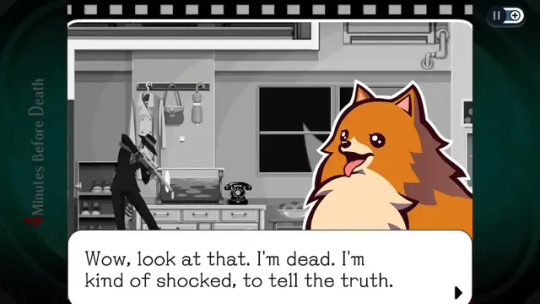
3. Ghost Trick: Phantom Detective Remastered - 2023 - Steam - ★★★★★
Play Ghost Trick.

2. Armored Core VI - 2023 - Steam - ★★★★★
From Software continues to not miss. Fantastic game, some of the most satisfying mecha combat I've played. Story is great; it's still your usual "oops we're not explaining much other than in medias res or by circumstantial details" that From Soft has continued to double down on, but I really enjoy that stuff so hey. I 100%'d this game, got all the endings etc. Great stuff.
Really want some proper DLC so I can do even more, though.

1. The Legend of Zelda: Tears of the Kingdom - 2023 - Steam - ★★★★★
Let's face it: this wasn't going to end any other way. Breath of the Wild is probably my favorite game of all time, and this is basically just more of that, remixed and remastered into a Second Quest that builds on the first one.
Something I kept thinking about while playing is that while there is volumetrically more to do, more things happening, more mechanics, etc etc, the different approach it takes in terms of focus and approach doesn't make it necessarily a "strictly better" version of Breath of the Wild.
Breath of the Wild was deliberately spare, quiet, and minimalist. Like the name says, its about the quiet wilderness, a poignant world that you explore. Tears of the Kingdom drops much of that, in many ways turning into a kooky madcap version of BOTW. You don't spent nearly as much time smelling the roses and taking in the scenery, as you're often too busy blasting by using any number of the new movement abilities or combat tools or literal flying machines you can now Nuts and Bolts together.
It's a deliberate escalation, one that in my opinion requires the preceding part to work. They add together into one complete singular experience, rather than pulling against each other. That's awesome, exactly what I wanted. Now I get to have two favorite games of all time that are secretly just one-and-the-same.
Some minor thoughts:
1. Lots of great writing and characterization, built up well on BOTW there.
2. It's kind of funny how much it goes out of the way to avoid talking much about BOTW in case someone plays this game first.
3. The last of a Master mode this time around is kind of a bummer but oh well!
4. The vehicle crafting system and everything about it, including the way it plays into the existing physics system is fucking insane. Absolutely incredible game design. Bonkers.
I'm really curious how the hell they're going to follow these games up. Going back to square-0 from this formula- one that is so built up and diverse, seems like it'd be impossible to me. What the hell could you do? Looking forward to finding out.
9 notes
·
View notes
Text

Tonight I was like "What if I draw a junkion" And then that turned into "What if I draw a gremlin junkion" and then that turned into "What if I draw a gremlin junkion with a sharkticon."
69 notes
·
View notes
Text
Every Game I Played in 2022, Ranked
I didn't actually play that many unique / new games in 2022, but hey let's rank them all the same. Let's keep this nearly decade long streak rolling!
2015 | 2016 | 2017 | 2018 | 2019 | 2020 | 2021

11. Tunic – 2022 – Steam – ★★★
I understand that my opinion is an outlier.
At the start I really enjoyed Tunic; I like Zeldas, I love me a good puzzle, and the overall mechanical design— built around learning things from finding pages of the game’s cryptic manual in-game to uncover secrets of the world— was fascinating. Those “Aha!” moments where you completely recontextualize something you had only a surface-level understanding previously? Very good. A game built around that? Sounds great!
Here's the thing: the combat in this game is atrocious. Like, yeah, I get it, that’s not really the focus, but boy y’all really decided to hang major portions of the game on this, huh? By time of the game’s “normal” ending I had completely soured on the whole thing. And while the secret “Golden Path” certainly isn’t combat heavy, and the puzzles within it are neat in principle, the actual experience of doing them was just one-note and tedious.
I had kind of expected given the open-ended nature of the exploration early-on that the experience was going to be more of a Metroidvania, where instead of necessarily discovering new traversal abilities you uncover contextual information that opens-up new rewards, opportunities, etc. While this is sort-of the case with manual pages, the game is mostly linear… and most of the unlocking of new sections is based on basic mobility abilities in any case.
Disappointing!

10. Capcom Fighting Collection – 2022 – Steam – ★★★★
Darkstalkers is a good series and Capcom should bring it back. This is a good collection that has Darkstalkers available for online play. I enjoyed my time playing Darkstalkers again. Darkstalkers.

9. Cuphead: The Delicious Last Course – 2022 – Steam – ★★★★
It’s more Cuphead! It’s not transformative, especially unique, or divergent from the original, base game. But… it’s more Cuphead! That’s pretty great. There's some truly astounding art in this DLC compared to the base game though, which deserves some serious props when Cuphead was already visually amazing.

8. Crusader Kings 3: Royal Court, Friends and Foes, The Fate of Iberia – 2022 – Steam – ★★★★
There have been quite a few pieces of major CK3 DLC this year— and they’ve all been pretty good. Royal Court was probably the most substantial and interesting, Friends and Foes added a lot of flavor, and the Fate of Iberia established a core system that’ll be very interesting as it’s applied more in the future.
In terms of the overall state of CK3 now as opposed to the start of 2022: it’s in a really good place. Which yeah, I’d hope so given the sheer number of major DLC that has hit within a 7-month span, but all these additions have, in one way or another, improved the overall mechanical underpinnings of CK3.
Do I wish there’d been more care taken to addressing under-loved regions on the map? Absolutely. The fact that the map is so big but the lack of definition to gameplay outside of Europe is still very disappointing. But hey, little steps, little steps.

7. Stellaris: Overlord, Toxoids – 2022 – Steam – ★★★★
Stellaris also had a major DLC this year in Overlord, but most of its best improvements have been courtesy of their new “Custodian” team. The Custodians go through the previous release content, and overhaul mechanical systems, and implement systematic, flavor, and ~lore~ refinements. The level of polish this has added has drastically improved Stellaris as a whole, making it both more balanced and more interesting. They even added more galaxy types! That's great!
On top of this, the Stellaris team has started doing more open beta testing of patches, which has resulted in greatly improved quality prior to major release. I’ve played a lot of Stellaris this year.

Hitman 3 – 2021 – Steam – ★★★★
The finale of the big ol’ Hitman Trilogy is, in all honesty, probably the worst of the trio on its own. Like, the levels are good, and the package as-a-whole is fantastic, but there’s just less new “Hitman 3” unique content in this boy compared to the previous titles, and two of the levels that are there are just pretty… whatever? Which is fine as a complete package but it does diminish the shine on one a little.
But man, as a whole? Good ass trilogy, good ass games. Looking forward to the new run-based Freelancer mode that’s coming out in ’23.

Inscryption – 2021 – Steam – ★★★★
Inscryption is one of those games where to explain it to someone who hasn’t played it would just diminish the experience for them if they were to then go and check it out. It’s also a game where to talk about it with those who have played it just results in an exchange of “wow this part sure was neat huh?”
For the former group, I guess all I can say is: it’s a very neat narrative card battling game with some interesting ideas and a very unique presentation.
For the latter group: wow it sure was neat huh! I think I preferred the opening section quite a bit more than what followed, but overall, it was damn good. Maybe I should check out the "endless" mode?

6. Pokémon Legends: Arceus – 2022 – Switch – ★★★★
This is really interesting. They went and did something truly different with the Pokémon formula, and it turned out quite well.
I think the game has a little too much in the way of busy work— I’m not especially interested in resetting maps to get the rare zones where certain specific Pokémon can only show up for capture— and the combat-and-capturing are a little on the basic side, but overall? This is neat.
I’, really interested to see if they evolve this formula moving forward. I like the classic Pokémon formula well enough, but it’s been the same for something like 25 years now. Varying things up more, evolving the formula here and there, would be appreciated at this point.
Though, like many of their recent titles, I think a problem all these games have is that they are just put together by a shoestring budget and a really small team. I realize this probably increases the profit margins for them, but the level of polish really isn’t enough for games of these “prestige” as it were. Imagine if they had combined the teams and levels-of-polish put into this and Scarlet/Violet this year.
Sneaking up on Pokémon and just slamming them in the back of the head with a Pokéball though: still very funny.

Disco Elysium: the Final Cut – 2019 – Steam – ★★★★
I’m not sure I have anything especially unique to say about Disco Elysium that hasn’t been said by a thousand people at this point: the writing is very good. The dialog system and the way it interacts with the RPG-system is great!
I don’t think I liked it quite as much as some— I think because I was sort of hoping for a more open-ended narrative given the flexibility in the dialog? But as far as linear adventure games go, it’s a very good one. Not necessarily my favorite (or even my favorite one this year, as it turns out) but still fantastic.

5. Neon White – 2022 – Steam – ★★★★
I am not the kind of person who particularly cares about speed running or any kind of record-based-gaming, frankly. That being said: I enjoyed my time getting the ace medal in each level of Neon White, a game explicitly about speed running. The gameplay loop and the overall flow of action is just fantastic. I even earned a few developer time medals, which hey that’s fun.
A lot of folks complain about the game’s writing, and I think they’re being melodramatic. It’s mostly fine-to-good; very 90s-Toonami-Anime-Vibes, to be sure, but that is an aesthetic they’re deliberately going for. I enjoyed the cast and the story, even as it did occasionally drift into “cringe” at times.
Also: game introduced me to Machine Girl, which is a fantastic band.

4. Pokémon Scarlet/ Violet – 2022 – Switch – ★★★★
For all my complaints in my Legends: Arceus blurb about how they’re not advancing things in the main-line titles, and for all the considerable— and very real— technical limitations of this game: Violet is one of the best core Pokémon titles in years. I don’t think it has the charm of Sun and Moon, and it has major problems with its progression, but as a game where you explore-an-open-world-and-catch-stuff? It’s damn fun.
The open nature of the game is both to its advantage and disadvantage. The actual catching parts of this game? Pretty good; not as viscerally enjoyable as Arceus, but good. The gym and trainer battling in game? Ehhhhhhhh. See, there’s no level scaling at all, so it is very easy to accidentally out-level everything depending on what you’re doing. The game eventually catches up if you’re not doing too many extra things by time you hit the Elite Four, but there’s whole swaths of the game that are kind of pointless to engage with with since you can just mash A and ignore it.
Graphically? It’s at best “compromised.” Patches have addressed the most embarrassing graphical bugs, but the game is still frame-y as all hell. But they actually managed to make the move to a true open world work quite well. Yeah, we lose a little from the traditional route-system— and I’d argue that maybe they gave us full mobility with the game’s legendary a bit too early relative to the game world we’re tasked with exploring— but as a space to explore it’s pretty fun, even more than Arceus was.
The story of Scarlet/Violet is pretty fun and pretty stupid, just like how I like a Pokémon. It’s not quite Sword and Shield or X and Y levels of stupid, but boy: it’s pretty dumb. Lots of fun characters. Wish there was more interaction with the Gym Leaders though.
The new Pokémon are as a whole fantastic. Great additions to the series. As far as temporary in-game gimmicks go, Terastylizing is interesting; the ability to shift a Pokemon’s type for either extra STAB or removing vulnerabilities is fascinating. Opens up some really unique space without being as obnoxious and back-breaking as Gigantamaxing or Megavolution.
Teraraids are better than Max Raids, but still extremely half-baked. Buggy, with a ton of issues— especially if you’re attempting to do them online. The experience is still enjoyable enough, but man I wish it was better.
There’s a ton of quality-of-life improvements to the act of raising Pokémon for battling. You can just buy bottlecaps now! Ability changing items are relatively easy to get! Teraraids get you easy access to hidden ability Pokemon, as well as high IV Pokemon! It’s not even that hard to get EV reduction berries! Shiny hunting is also probably the easiest it’s ever been, thanks to picnic resets and the way the save-and-clock systems work.
But maybe the best thing about this game— and the thing I see folks talking about the least— is that the online co-op actually is kind of great? Like, it’s literally “oops our two worlds are dropped ontop of each other and you can just play through your campaigns individually.” That’s awesome! Like, yeah this is something we should be expecting from games in this day and age, but from Nintendo? From Pokemon? Being able to just tool around with friends and catch shit was really fun, especially earlier in the game.
It's pretty pointless once you're done, to which: I really hope DLC adds more post-game content, since all there really is at this point is doing more Teraraids and battling people which, while fine, I’d love a Battle Tower or Frontier. Nemona would love a Battle Frontier! Let her have fun!!!
I think if this game had some of its issues ironed out, it’d be a 5-Star given my level of enjoyment for it overall. Hell, if you added the catching-Pokemon-from-the-field stuff Arceus has, combine their movement systems? That’d be a hell of a game!

3. Pentiment – 2022 – Steam – ★★★★★
I am a huge history nerd, and a huge sucker for evocative aesthetics, and let me tell you: Pentiment is laser targeted at me. An adventure game styled after illuminated manuscripts, set in an abbey in medieval Germany? Fantastic.
It is funny, in retrospect, how much it’s borderline a The Name of the Rose fangame. But given how narrow a subject-matter that is, and the fact that this is a title published by Microsoft of all studios? Once again: Fantastic.
Pentiment is just a monumental achievement in visual semiotics in video games. Unique fonts that are styled based on not just the speaker’s accent and background, but also the player character’s impressions of that character? The fact that the illuminated script styling of each character varying based similarly depending on their background? The sheer skill at which they managed to singularly render this game in this style, with a narrative about this without any compromises? Again: Fantastic.
Pentiment is truly Art, in a way few games are.

2. Elden Ring – 2022 – Steam – ★★★★★
I have a lot of issues with Elden Ring.
It’s immense in scope, but a lot of that is borderline padding with repeated content. It’d be much better with a more focused, tighter experience.
The music is incredibly weak for a From Software title (bar one major exception).
Most items you find are throwaway, and the sheer repetition of encounter design in the mini-dungeons you can explore make doing them kind of pointless.
Many boss encounters are frustratingly designed, as they either have mechanics that exist just to compensate for horse-riding or varied weapon types but make Normal-Ass Combat kind of worse, or are incapable of handling someone not using the most basic weapon styles, or are sometimes just a duplicate from elsewhere put into a room they sometimes barely function in. When compared to a more focused combat experience like Sekiro, this "squishiness" sticks out.
Miyazaki takes his obscure narrative obsession to a new level by making the entire setting of the game being hidden in a dialog chain you can completely miss if you explore this "open" world game in the wrong order.
…
Ok, that all being said: I desperately wish there was more Elden Ring. Elden Ring is fantastic. Monumental in both size and achievement. I’ve put nearly 200 hours into Elden Ring this year, and that’s absurd.
Elden Ring is definitely still just One-Of-Those, a Souls-like with not that much evolution in terms of gameplay— but what quality-of-life changes are there are great. The exploration is indeed kind of throwaway, but there are so many weird things that you can find and the combat feels so good that you can forgive the paltry rewards. There’s so much variety of ways you can approach the game; while this does weaken the overall design of many encounters, the fact that you can play it so many different ways is still an incredible achievement.
The funny thing about the narrative is that, while it is as ~mysterious and vague~ as ever, it’s still a fantastic one. I really enjoyed the weird goober characters you meet along the way. It is weird, but never too outlandish. I want to see more set in this world.
Announce some DLC Miyazaki. Please. Oh God. I’m begging you.

1. Dwarf Fortress – 2022 – Steam – ★★★★★
Dwarf Fortress is a game I have known about for years but never played. Certainly I’ve heard many sing its praise, and I understood that, yes, I would love this game. But I always put it off due to the challenges of the interface; I did not have it in me to learn the ASCII graphics, the keyboard-only interfaces, to wrestle with the labyrinthine systems and mechanics.
Then it came to Steam. With graphics. And a mouse interface. So I figured, hey, why not, let’s give it a shot. I’m on vacation, I have the time!
And, turns out, yes: Dwarf Fortress is very good. Amazing, even. It’s a monumental exercise in the kind of weird stories you get just by assembling a series of mechanical systems and then hitting play. Dwarves engaging in their dwarf-y lives, occasionally beholden to your whims, more frequently beholden to their own, and with the world actively conspiring against both you and them.
For those of you who may not know what Dwarf Fortress is— very possible, since it is probably the most obscure thing on this list— Dwarf Fortress is a colony simulation game where you take a bunch of dwarves into procedurally generated world and try to stand up a successful colony. The big thing here is that the entire world is procedurally generated, with its own history and actors, and your dwarves act largely on their own based on a complex network of interlinking systems. You can submit requests, and they’ll get to them, but dwarves are very needy and sensitive creatures. When those needs aren’t met, or when the world goes against them, things go very awry.
They are all high-functioning alcoholics, which probably doesn’t help.
Here's an example: In one of my earlier forts, the very unfortunately auto-generated “Twinklechains”, I had a fisherdwarf. Every so often, this dwarf would walk out of her mountain-side home, through a little forest, into a nearby creek to go fishing. She was very good at it; she frankly was the source of 95% of Twinklechains’ food supply. She kept at it so frequently that she actually wore a path through the grass through her constant marches to-and-fro.
Problem is: it occasionally rained. She hated the rain. She was getting very salty about it. To the point where, to improve her mood, I freed her from her fishing duties. We had a functioning farm and we didn’t need fish now. But because she had been rained on so much, she now had so many memories of being slightly soggy, and she became depressed over it. Not only that, she was unhappy that she couldn’t fish anymore, so she spent 95% of her time now sulking and crying on the mayor’s shoulder about how unhappy she was.
Then a giant, fire-breathing, beak-less lark emerged from the caves beneath the fort and burned her to death. A tragic end for some, but a welcome exit for her, I think.
In my most recent fort, the also very unfortunately auto-generated “Twinklebasement” (why is it always Twinkle-???) the capital of my civilization fell in a war, leaving us somehow the new capital. But because this occurred before any nobility could be invested on-site, we now are just a pure democracy with just a mayor. Said mayor is obsessed with mandating we make statues, and also to never export statues. The hallways are lined with statues. He just likes them. And he keeps getting reelected, so more and more statues and filling this fortress, commemorating this new, last bastion of the Dwarven civilization of The Born Figure.
My best wall-engraver lost the ability to walk in an incident, but gets around plenty fine on their new crutches. Unfortunately, they only want to engrave images of traction tables. My walls are covered in beautiful, immaculate images of That Time He Was In Traction After His Legs Were Shattered By Goblins. Dwarves are weird.
This fort is on the precipice of total collapse now. See, they encountered a monster that exuded a goo that causes flesh to rot. This killed a bunch of dwarves (which the survivors weren’t thrilled about), but it also got on a lot of the dogs they had brought to the fight. Those that survived long enough managed to get back into the fort proper before immediately dying. Unfortunately, this goo seems to have gotten itself into somewhere the dogs and cats keep interacting with (there must be a puddle of it somewhere), which is cause them to constantly melt from the paws first, slowly releasing a horrible cloud of rot before falling over dead. There are so many pet dogs in my fort that are all slowly-but-surely melting into the ground that the entire population of dwarves are getting very crabby indeed.
I expect the whole fort will soon fall prey to the dread Tantrum Spiral, where-in everyone eventually gets so mad that they start a massive brawl that will destroy the fort from within. Hooray!
See, Dwarf Fortress isn’t really about “winning” the game. It’s about experiencing the systems to the point at which you inevitably lose in a weird and wild fashion, and then you start over again. Losing is the fun. Yeah, you want your dwarves to be happy and succeed, but current success is just the root of future failure. Armok demands only conflict and slaughter!
Play Dwarf Fortress. Strike the Earth!
10 notes
·
View notes
Text

The Seventy-Eighth spirit is Dortax. He is a Lesser President in power and appeareth in the form of a flamingo wearing a ducal crown, standing atop a tortoise. His office is to grant men Wi-Fi. He governeth four Legions of Spirits, and his Seal is this, which he obeyeth when he seeth it.
148 notes
·
View notes
Text






A collection of Sasquatches from Zorak and I's Bigfoot of North America video.
24 notes
·
View notes
Text
Every Game I Played in 2021, Ranked
It’s time to say goodbye to 2021 in the only way I know how: ranking the games I played this year. Let’s hop to it.
2015 | 2016 | 2017 | 2018 | 2019 | 2020

14. Deedlit in Wonder Labyrinth – 2021 – Steam – ★★★
Deedlit in Wonder Labyrinth set in the Lodoss War franchise. The “story” as it stands is kind of just an excuse to recycle various dead Lodoss characters into a series of boss fights in what ends up being a pretty linear Metroidvania. The story is really not what you should be here for— if you’re not familiar with Lodoss it’s pretty much nonsense, and as someone who is: still not great.
What works really well here are the controls and element system. You have the ability to swap between two active elements: fire and wind. Whichever is active, you deal that kind of elemental damage, and are absorb that element to refill your mana. You also have various other abilities as a result: wind in particular allows Deedlit to float, which is very useful, and being able to stand in lava is, while not as helpful, definitely a thing.
Of course, enemies have their own weaknesses and resistances (even beyond these, which activated magic can play into), so you’re forced to be constantly swapping between elements (including back and forth during boss fights) to move through the world and attack. Which, all-in-all, feels pretty good. There’s also an interesting puzzle system built around bow-and-arrow hitting targets and cutting ropes.
Sprite work is good, animation is fantastic, music is a bit… basic. Environments look nice but are also devoid of any variety whatsoever.
Beyond the basic-ness of it, the main reason I have this relatively low rated here is that the combat is just suuuuper just “there”. There’s nothing really to it, and it’s pretty trivial. Bosses vary from being very easy to annoying, in part because they’re VERY BAD at telegraphing the moves you’re supposed to be dodging. And you really need to dodge: a core system of the game is building up damage with particular elements so you can refill life since you can’t take many hits, the game has a very harsh fighting-game style stun system, and the knockback is almost comically mean. It’s the kind of stuff that I’d expect they’d have polished with more time and playtesting but… so it goes.
It’s very short, and the variety isn’t huge, but it’s fun enough for a few hours. Honestly, it kind of feels almost like a first pass— I’d be interested in seeing the team behind this working on something with more budget (and with more people) to make a true Metroidvania out of it. Put these people with the Bloodstained team and you’d get a really interesting game out of it.

Ori and the Blind Forest – 2019 – Steam – ★★★★
Ori is a very pretty Metroidvania game with some glaring flaws that bring down the experience. The combat is brainless, you just press an auto-attack button that does all the work for you. There’s an obsession with long, very orchestrated chase sequences that are meant to be “cinematic” but are ultimately just frustrating when you don’t know what they are expecting you to do at a given moment.
But when the mobility abilities are firing, the interconnected flow of combat-and-movement is fantastic. And the game really is very pretty. The writing is decent, though its attempts at emotional moments feel a little forced and obvious. Still, it’s good. It doesn’t compare to its sequel, but…
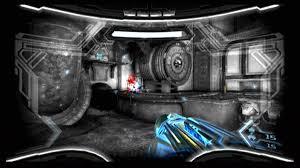
Metroid Prime 3: Corruption – 2007 – Wii – ★★★★
So, I’ve been slowly— very slowly, given I played through Metroid Prime 2 all the way back in 2015 — getting through the rest of the Prime series. I’ve played Prime 1 a bunch, but for whatever reason I just never got to the others. Well, here we are.
This is by far the weakest of the Metroid Prime series. They tried to make it more of a linear action game, which just… doesn’t work. There’s still exploration, but the kind of spatial reasoning and memorization of areas for backtracking just isn’t here. You barely even have reasons to go back to past areas, and when you do the giant space brain outright tells you what planets to go to instead. Weak.
The addition of the hypermode mechanic just… isn’t good. Like, the base idea of “spend life to increase damage” is perfectly fine, neat mechanical idea. Corruption letting you get more out of your hypermode for the health you spend is cute but poorly explained as well. The issue is that so many enemies require the use of hypermode against them that it kind of invalidates the other combat options?
I like the Prime series’ mobility. I like to charge a beam while dodging around fire to hit something. Shooting missiles that lock. Both of those are immeasurably worse options in this game, if they’re options at all.
Many bosses NEED you to be in hypermode to damage them, which can be tricky if you’re low on health (and thus require you to farm health off them v e r y s l o w l y). Actually, in general: the boss designs in this game are very weird in their difficulty. Things get much better in the latter half, but some fights are just absolutely miserable. Rundas and the first Leviathan Guardian in particular are just so tedious. Ridley, Ganaydra, and the final encounter were all genuinely fun, but man, some of the others.
Some quick thoughts:
The scans not containing much lore on monsters etc. sucks. I miss my science team scans.
Changing up the enemies for particular rooms at certain points in the story is cute, but replacing everything with Phazoids, the most annoying enemy, after you beat an area is miserable. What the fuck?
Playing this game now is hilarious, because there’s a lot of mechanical stuff built in tied to the Friend Voucher system. Backtracking to do a weird environmental puzzle where the only reward was a Friend Voucher… kind of broke me a bit.
The X-Ray visor + Nova Beam combat stuff is hilarious. Props to them on that. Sniping a Metroid Hatcher after the frustration of fighting it previously is very satisfying.
Speaking of funny: the admiral flying down like Patton to say GOOD JOB SAMUS, HERE’S SOME GUYS TO NOT GET KILLED and then fly back to his ship slayed me.
I think I hate motion controls now
Anyway, Prime 1 >>> Prime 2 >>>>> Prime 3

13. Super Mario 3D World + Bowser’s Fury – 2021 – Switch – ★★★★
Mario Odyssey was billed as kind of an “open world Mario 64”, but that really wasn’t the case. The game was inventive, and the way it built its levels was certainly different, but the sheer volume of collectables in Odyssey kind of weakened it overall; it was very much a quantity over quality.
Bowser’s Fury is really, really an “open world Mario 64”, in that you’re basically moving between Mario 64 levels in an open world, each with a set of self-contained goals. This is complicated by the presence of a kaiju Bowser occasionally wrecking shit, sometimes helping out on accident but often getting in the way.
The Bowser’s Fury aspect of Bowser’s Fury is, in my opinion, its weakest aspect. Yeah, there probably needed to be some environmental interactions to make the game work, but interrupting precision platforming with unavoidable horseshit is super not cool, and the number of shines that require his presence and the overall brevity of the game basically forced them to make him spawn really, really often towards the end, which is obnoxious.
But even so, I had a real blast with it. Bowser’s Fury is short, but it’s a good proof-of-concept of a direction they could go with Mario moving forward. I’d much prefer them built out a free-flowing open world Mario along these lines than sticking to the Odyssey model, but we’ll see.
Also, 3D World: that’s still a very good Mario game. Kind of wasn’t feeling it coming back to it, but then I ended up running through the whole thing again anyway. Good stuff.

Yakuza: Like a Dragon – 2020 – Steam – ★★★★
I’ve largely enjoyed the Yakuza franchise from afar. But the move to a dedicated goofy RPG system seemed weird enough that I had to check it out first hand.
The RPG system is a good first try. It functions, but it does not really shine. There’s just not a lot of systematic depth to the progression. See, it uses a job system with unlockable abilities, ala Final Fantasy 5, that progresses independent of your level. Different jobs have different skills and specializations, as well as different weapon specializations.
Problem is, there’s actually not much depth to job switching. Very few abilities are actually usable by other jobs once unlocked, and most abilities are very flat in both their usage and damage. While there are a few damage types, there’s typically only one unlockable attack type of a given elemental type available to a character, so you basically just grind to get those abilities so you have a full elemental coverage, before swapping them back to whatever class is the highest DPS for them / has the highest ability variation.
There’s just not much decision making in “do I attack with Big Punch A or Big Punch B”, really; you just mash whatever attack does the most damage and isn’t resisted by the target. The fact that stat modifiers for opponents are typically kind of useless given weaker enemies die too quickly for them to matter, and bosses almost always resist them anyways.
The way summons work is pretty interesting, in that they actually use money and are available based on environmental conditions, and time last used. Them also being connected to side story progression is very good; it allows them to really build dumb emotional connections as to why Kasuga is summoning a swarm of crawfish to fight someone etc.
Story wise… it’s a Yakuza game. It’s a well-executed one of those, but ultimately, it’s just one of those. If you like the crime melodrama of Yakuza, you’ll have it here. Kasuga as a protagonist is a good replacement to Kiryu in that he’s much more… emotive and involved, but it is very funny to me that the series is obsessed with putting washed up 40+ year olds in the protagonist seat, to the point where even their new junior protagonist has to be one too.

12. Subnautica: Below Zero – 2021 – Steam – ★★★★
The last time I played Subnautica was when the original back in 2018. I rather enjoyed it at the time, and I’ve grown fonder of it since. The core formula of Subnautica— a sort of underwater survival Metroidvania, where the progress “locks” are both a tech tree and spatial knowledge— just rang quite true for me, and the way it approached an open, unfolding narrative was great.
Subnautica: Below Zero is an expandalone sequel for the original Subnautica, and it’s… well, it’s not quite as good. But: it’s still Subnautica. I do not like it nearly as much as I did the original, but I still enjoyed my time with it. I do not think there is any reason to check it out if you haven’t already played and enjoyed the base game though.
Let’s touch on some positives first before I start getting into all my nits: It runs and looks considerably better. Them making the narrative much more personal— with you as an actual named, voice-acted character looking to see what happened to her sister— is a good turn. It’s an interesting expansion to the story of base Subnautica, though I’m not entirely sure if the story it’s telling is particularly revelatory in the same way. And, again: the core gameplay loop is still the same as Subnautica, which is a fun loop overall.
Alright, let’s pick those nits:
Below Zero takes a big focus on on-land (well, on ice a lot of the time) movement and exploration, and it just doesn’t work very well. The physics system can’t quite handle animal movement on land very well, particularly when it’s aggressive, and the movement is just slowww. Heat as the oxygen of the land— while being a funny statement— just isn’t that interesting. The loss of vertical movement there is really limiting, too.
My main issue with Below Zero is its layout and progression. The game is much smaller by landmass, and as a result it has compensated by reducing vehicle movement speed, made biomes much more labyrinthine and compressed, and just made the overall flow of the exploration not as good. OG Subnautica had a kind of natural sequence to the map and the technologies you followed— born both on how it slowly gave you waypoints, the way sight-line landmarks were used to lead you in particular directions, and the way it slowly gave you access to particular mobility / depth enhancement technologies and their required resources.
Below Zero being squished makes all this instead kind of weird: you’re less gated, but there’s so many areas that don’t actually matter, and you end up getting some technology / access to certain resources in what seems like a very odd order sometimes. Subnautica just felt more deliberate in how you tended to stumble your way through the game; not so here.
This lack of structural guidance also kind of bears out in the story, weirdly. There’s two major narrative threads, one of which kind of just ends fairly abruptly (and, on my part, kind of accidentally), and then the “main” plot also sort of wraps up melodramatically, in that it… wasn’t that hard to do? Compared to the main ending challenges of base Subnautica— including the extremely fraught but fun journey to the bottom of the map that really felt like an expedition— the jaunt to what ended up being the end of Below Zero was… pretty basic and easy?
Some of this admittedly could be born of not remembering annoyances with the base game which would elevate Beyond Zero by their correction, but… overall, I think this is fun enough, but not as fun.
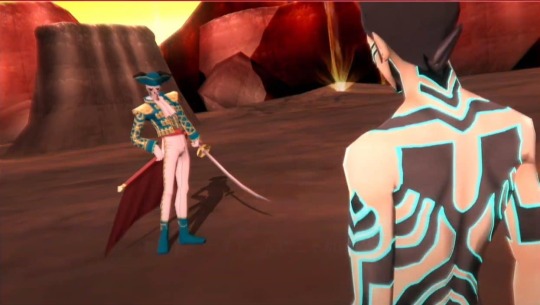
11. Shin Megami Tensei 3: Nocturne HD Remaster – 2021 – Steam – ★★★★
This was actually my first time playing through Nocturne, and boy: that sure is a 20-year-old game huh! Like, the core SMT systems are still good and enjoyable, and the tone is still great, but there’s just aspects of the experience that haven’t aged well. A lot of expectation for you to either just know stuff or have a guide, and not a lot of respect for your time.
That being said: The turn press combat introduced here is still great, and adds a lot of fun to the sort of push-and-pull of critical hits and weakness exploitation. It’s fun!
This Remaster adds voice acting— which I found pretty good— cleans up the graphics, removing randomization from skill inheritance (oh thank god), and pulls in all of the variants of the Maniax dungeon stuff. Annoyingly, I had multiple softlocks in the Labyrinth of Amala around the Maniax cutscenes, which ate hours of my time. Which: cool, great, thanks.
Still need to check out SMTV despite owning it. Just need to build up the headspace energy for it.

10. Castlevania: Advance Collection – 2021 – Steam – ★★★★
This collection is complicated. I am on the record as loving the portable Castlevanias— and I do— and I all onboard for them getting a new release so that I can play them on, say, the Switch or something. Of course, they’re all super emulatable, and have been for two decades now, but that’s kind of the nature of game rereleases I suppose. This package includes all three of the GBA Castlevanias, as well as the SNES release of Dracula X. It adds some minor additional art stuff, some audio with better compression (well, in a few cases), and also some actually pretty useful on-screen pop ups tied to bestiary item / soul collections.
As far as deals go, it’s a decent one, but again, kind of pointless. I’ve played all the games in this collection before, so let’s just briefly run them down:
1. Circle of the Moon
This game has aged terribly. It feels stiff, empty, and super basic. The whole card combination system for special moves is really neat actually, but the drop rates for cards is terrible, to the point that you can go a lot of the game not getting new ones. It’s a tolerable experience, but not an enjoyable one.
2. Harmony of Dissonance
This game is pretty good still! Like, the Castle design is kind of complex to the point of being genuinely confusing at times— I have gotten genuinely lost in this game before multiple times, kind of an uncommon experience really— but that’s part of the fun. This game truly captured the idea of “let’s do Symphony of the Night but on the GBA”, and did so pretty well. It’s not the best portable Castlevania by any means, but it’s pretty good.
3. Aria of Sorrow
Now we’re talking. Aria of Sorrow is very good. It’s easily the best GBA Castlevania, and in the running for one of the best Castlevanias period. I don’t know what to say about it at this point. The collection aspect is good, the abilities are fun, the game moves and just feels good in a way Circle and Harmony both kind of struggled with. It’s just a fun game to play. As a Metroidvania it’s not especially open or hard in the sense of getting lost in it (beyond chasing the abilities necessary for the “true ending”) but there’s certainly more narrow ones out there.
4. Dracula X
… Why are you here? You’re not a portable game. You’re not even the best version of the game that represent. Legitimately, why are you in this collection? Y’all couldn’t be bothered to just give us a good ass Rondo of Blood port instead? Whatever.
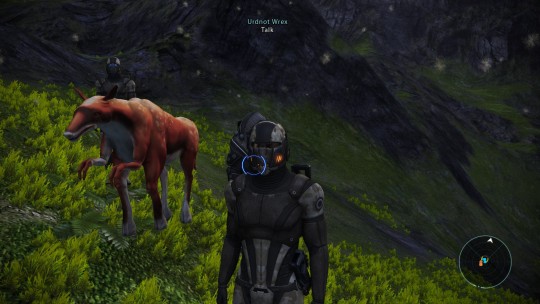
9. Mass Effect: Legendary Edition – 2021 – Steam – ★★★★
Hoo boy. So, Legendary Edition is a packaged rerelease / slight remastering of the Mass Effect trilogy. Way back when, I rather enjoyed the first two games, and avoided the third in-light of the drama around its original release. This rerelease was my excuse to revisit it all at once, and finally give that third game a try.
Mass Effect 1 definitely feels like an older game. There are aspects of its design that you can tell stem from it being a relatively smaller game made by a relatively smaller team— there’s a lot of asset reuse (particularly on side missions), and they hadn’t quite locked down what exactly people liked about the franchise (namely, the side characters and party members). But the world building and narrative design really did shine here. The way it presents a complete blank slate science fiction setting that’s both expansive and detailed is great. It’s a great start for the series and setting.
Mass Effect 2 is the jump into “triple A” polish and design. Combat feels better, there’s a lot more bespoke assets, and the team and your interaction with them is put at the forefront. It’s definitely the best game in the series, the most interesting and complex. Going back now, there’s still some aspects I found a bit annoying. The way it handles certain narrative points of return— basically punishing you for advancing the story in certain places not knowing that things can turn out badly for characters as a result— is stupid. Certain plot hooks are dropped outright in ME3.
My feelings about Mass Effect 3 are complicated. Obviously, I’m coming to this with all the various DLC and fixes layered on, though I was well aware of the various flaws and foibles of the game going in (spoilers aren’t the end of the world for me— I care a lot more about plot execution than plot surprises). Mass Effect 3 almost feels like it was made by two different writing staffs. The character writing is still good. The way they gave the party a real send-off with the Citadel DLC was great, and the way the general game pushed more party-member-to-party-member interaction was good. But boy, the central plot just doesn’t work well, and the resolution is tepid– even after them going back to clean it up. You can tell they put it together under a schedule gun.
I get what they’re going for with the big focus on the war in ME3, and a lot of that works well enough. The whole gathering of disparate assets and factions is neat, and the general plot being about gathering allies on the national scale etc is fine. But the actual missions, and what you’re up against is very flat, straight forward, without nuance. For a series that often had very complex narratives with interesting choices— if not necessarily that consequential when tied to those choices— everything here is hyper-focused to basically how much do you oppose genocide really. A lot of the “gray areas” from previous games are hyperfocused into black-and-white, and indoctrination becomes a catchall solution to the plot’s woes.
I wonder what the hell they’re going to do with the ostensible Mass Effect sequel we have coming. Dragon Age: Inquisition showed that BioWare can in fact make a game like this still, even if Andromeda was a big ol’ flop, but I’m not sure how one does a direct sequel now. I guess you could pull a Deus Ex and do the “combine all three endings” thing, which… would be fine, I guess.

8. Halo: Infinite – 2021 – Steam – ★★★★
It has been ages since I last played a Halo. I only play first-person shooters on PC generally, and I do so only very sporadic at that (see: the past few years rankings). But, with Halo: Infinite being F2P, I figured hey, why not dip my way back in? I had a fun time with Halo 1 on PC back in the day.
And turns out, Halo: Infinite is a good time. There’s a lot of good mechanical evolutions, fun match styles, and good weapons. The flow of kills feels pretty good. Folks complain a bunch about the “progression”, and I acknowledge that their complaints are justified, but as someone who is here to just have a good time and not necessarily chase the number dragon… ehhhh it’s fine. It doesn’t impact me really.
I ended up shelling out for the campaign, and it is pretty neat. The gameplay loop is fun, particularly with the mobility added by the grapplehook. But boy that narrative is weird as shit. I’d love to hear what the hell happened production wise that led them here, because it is genuinely bizarre structurally. How late did they pivot to… this?

7. Stellaris: Nemesis – 2021 – Steam – ★★★★
It’s been a hot minute since I touched Stellaris; last time I reviewed some expansions on here, I dwelled a lot on the issues Stellaris has; a lot of those still are here. AI is dumb as shit and doesn’t play by the same rules, there’s occasionally back-breaking bugs, and the level of micro becomes absurd at times, especially in certain “builds”. War is such a goddamn hassle.
On the plus side: there’s actually been a ton of improvements since I last dipped in. The AI is genuinely better; it’s not exactly good, but it is much less pants-on-head frustrating. The additions to Stellaris via Nemesis are also neat; the whole becoming-the-Crisis gives another option for end-game for people getting bored with the game state, as-is forming the galactic imperium. The changes made to first contact and the addition of intel is good, if a bit micro heavy and inconsequential a lot of the time.
They’ve also generally just added a ton of new small events across the game. Their addition of a team whose entire job is to polish up old expansions and add small content like this is a godsend for improving the experience. I hope they continue to add more weird Origins; the divergence of experience tied to them is really good.

6. Animal Crossing: Happy Home Paradise – 2021 – Switch – ★★★★
This is quite an improvement on base Animal Crossing! It doesn’t exactly reduce the long-term tedium or anything, but it certainly gives more incentive to consistently come back. I guess this is technically a review of both the 2.0 update and that DLC.
The addition of Gyroids, out-of-season islands, the ability to visit Harv’s Island to deal with roaming stores consistently (particularly Redd, who will rotate art in as you buy), various item additions, and of course Brewster is all pretty great. Lot of fun details (as one would expect). The game as a whole feels a lot more rounded with it.
Happy Home Paradise is just a fun little excuse to make cute houses. If you aren’t “playing along” you could easily metagame it to try to speed run your way through, which… that doesn’t seem especially fun. But if you’re just having a good time customizing and taking your time, it’s a real hoot.
It is kind of weird to me that they’ve gone out of their way to say that this is the last major (free?) update to the game, given how huge AC is. AC seems ripe for them providing ongoing, almost Sims-esc support. People are very hot on AC, it’d be a waste to not, y’know, capitalize on it. Ah well.

Ori and the Will of the Wisps – 2020 – Steam – ★★★★★
OK, now we’re talking. Ori and the Will of the Wisps pretty much addresses every single issue I had with Ori and the Blind Forest.
The combat is much improved, since now it’s an actual honest-to-god combat system with manual attacking. It’s very satisfying; as someone who disliked how flat Hollow Knight’s combat system was, this is a good example of a very similar game with a similar combat still that built the system out for strong in-combat feedback.
They also doubled down on the combat-mobility mechanics, encouraging more active use of the various movement abilities that can be interlinked with combat. Them having many of the unlockable ability-modifiers be based on a limited slot system further encourages you to specialize, though some are too essential to not be “mandatory”.
Story is much better this time. It still has a lot of the similar narrative “tricks”, but they’re performed much more elegantly here. It’s also enhanced by having a lot of smaller sub-narratives and stories.
I suppose I’d be remiss not to mention how gorgeous this game is. It’s legitimately one of the prettiest damn games to date; the amount of environmental and background animation is at work is incredible. You’d think a move from 2D to 3D models would reduce the hand-crafted artistic quality, but it’s very much enhanced the experience instead.
They still kept in the obnoxious chase sequences for some reason, but they at least made them less fail-state-y and more forgiving.
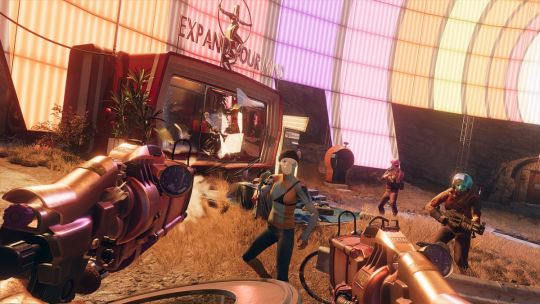
5. Deathloop – 2021 – Steam – ★★★★★
Y’know, it’s weird; the interactive sim genre— as it were— hasn’t changed much in the last, what, twenty plus years? Sure, different games grant you different ability sets and what not, and the set dressing varies, but the core experiences are pretty similar. “Use ability to navigate environment in a first-person shooter, depending how you specialize you can approach this from different angles.” Different titles approach their RPG-itude differently, but overall, the general intent is that two different people’s “runs” of the same game would result in them picking different approaches through the environment based on their specialization.
Deathloop is a neat attempt at innovating on that, in that in that it is deliberately focused on the replay aspect— specialization occurs on a fairly limited level, and “runs” are more often about applying learned information and knowledge of an environment over and over again. I don’t think it does a perfect job— there’s not a lot of reason to swap “builds” between going loud or quiet, and the lack of specialization typically means you just take the optimal path each time— but it’s at least doing something different. It does encourage you to learn the environments and incorporate that into your memory between each loop, even if it doesn’t give you a ton of incentives to vary things up beyond “hey why not.”
The big complicating factor is the introduction of a Dark Souls-style PVP invader, which is quite fun from both sides of the equation. I’ve had a blast invading folks as Juliana and blasting away, and her being in a level does encourage you to take different approaches, but… not necessarily that different. A lot of folks seem to just camp out until she leaves, which is boring.
Weirdly, I’d say that this game’s strongest point is actually its writing? The targets you are killing aren’t necessarily that well-developed, but Colt, the player character, is fantastic. Incredibly funny and well-acted. The ending is kind of ehhhh fine, but Colt himself and the narrative largely around him is great.
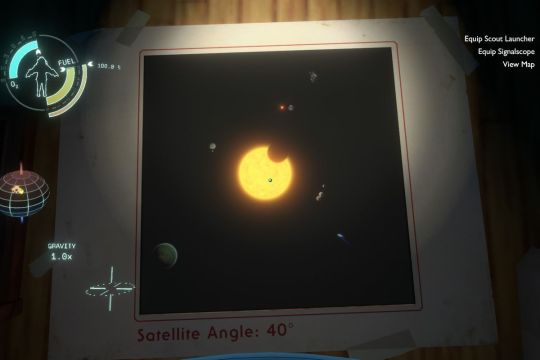
4. The Outer Wilds: Echoes of the Eye – 2021 – Steam – ★★★★★
I was of mixed emotions about Outer Wilds getting DLC. I am on the record as having really, really liked that game. But it was so self-contained and well-made that, well, what could a DLC really add to the game? Wouldn’t it just bloat it, or just be the game in miniature?
Echoes of the Eye is kind of just that, yea. It’s a self-contained little journey that is wrapped in the burrito that is the rest of Outer Wilds. But it is also, like Outer Wilds, pretty dang good, so hey.
I’m not sure there’s much to say about this that isn’t a ditto from the Outer Wilds in terms of what I liked about it. There are aspects of it that I don’t care much for in terms of the overall flow, and how little it takes advantage of mechanics established elsewhere in the game (it is, again, pretty much self-contained, and that includes mechanically), but that honestly borders on quibbles compared to the enjoyment I got out of it.
It’s a nice little addition to Outer Wilds that, overall, does add some more context to the events you are uncovering elsewhere in the base game. It also adds a nice little to bonus to the ending of the base game, so hey.

3. Super Robot Wars 30 – 2021 – Steam – ★★★★★
It’s unbelievable that this happened. An official release of a main-line, non-OG SRW title in the West, on Steam. Absolutely unbelievable. And yet, here it is.
After a few years away— presumably from a mix of pandemic and just a general need to rework the systems after years of pretty same-y titles— SRW30 is actually fairly different mechanically. It removes the route system in favor of dynamic mission selection, allowing for more dynamic plot events where dialog shifts based on who you’ve recruited and the order of missions. The changes aren’t large, but they are interesting, and it does let them just pack tons of missions into the game. The game is big, even as Super Robot Wars titles go.
The cast list is also pretty different, if weird. I’m glad SSSS.Gridman has made an appearance, and the way it brings CCA/Zeta Gundam in this time around is certainly different. No real objections there, even if the Victory Gundam inclusion seems kind of funny overall.
I do have considerable issues with SRW30. The big one is the same issue I’ve brought up every time I talk about a SRW in these write-ups: the game is too goddamn easy. Like, yes, a lot of that is born from being familiar with the mechanics, and thus being able to take advantage of them. But the game also loves going out of its way making it very unchallenging to just absolutely break the systems. It’s not that there aren’t any stakes or challenge at all during missions, it’s just that any amount of understanding of the systems makes it not a challenge.
These games keep adding more and more ways for you to put yourself ahead of the curve. Upgrade your units? Upgrade their skills? Use spirits? Use power parts? Upgrade the AOS system? Use attacks in an optimal fashion? Use a small team? Perform any one of these, and even at the highest difficulty the game won’t be hard. Engage with multiple of them— or, God forbid, optimize based on your understanding of those systems— and the game become INCREDIBLY easy. It’s the thing where there’s whole systems that just don’t really come up because you never have to engage with them anymore. Enemies basically never use spirits except when triggered by cutscenes, tile-effects almost never come up— many stages don’t even use them— and the fact that the morale system can be broken in like 20 different ways makes the idea of Morale Downs completely pointless.
Some of this also comes down to mission structure; there’s not many missions that are just “ok, we’re forcing you to use some odd ball units, good luck”, or “we’re constraining how many units you have; you’ll have to play it smart”. You almost always just have to outlast the timer for 2 turns before reinforcements arrive, and the loss of a dedicated route system has introduced the unfortunate effect that you are never forced to “scrounge” lesser-played units. Who the hell is going to be sticking Tomache on the field when you have 80 more interesting protagonists that you can field at a given time?
That all being said: this is still a good time, just not necessarily the most intellectually stimulating time. Seeing the weird mash-ups and plays on lore is fun, and the systems are, at their heart, pretty relaxing. I want it to be better because I enjoy it. SRW30 came out at the right time, and it’s a deeply satisfying experience to me— I just wish it was more stimulating.
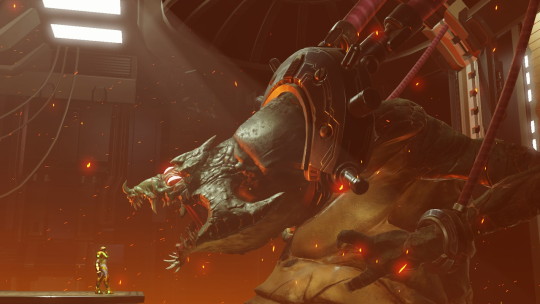
2. Metroid Dread – 2021 – Switch – ★★★★★
After nearly two decades of waiting, we’ve finally gotten a proper new 2D Metroid. And even better… it’s good.
There was a lot of reason to be skeptical, honestly. Other M was Metroid at its lowest, with Sakamoto going as far away as possible from what people like about Metroid in terms of both mechanics and narrative. None of the good Metroidvania exploration, and the plot was just awful.
I understand that most people don’t come to Metroid for ““the lore”” but it is something I genuinely enjoy and am somewhat invested in. In part because it’s so vague and weird and stupid (SCIENCE TEAM RULES), but also because Samus is genuinely cool. She’s a bounty hunter who was injected with birdman DNA by her bird dads after a space dragon ate her parents, and she proceeds to repeatedly cause planets to explode over the course of her job. She later gets Metroid DNA injected in her body, making her a bird-human-metroid hybrid. She twice got evil space gooed but she got better.
Starting with Fusion, Sakamoto started losing the thread of what people liked about Samus— the idea of this stoic space amazon, facing down monsters and repeatedly manifesting as different civilizations’ prophesized space messiah as part of just doing The Mission. Instead, she got internal monologues, she got bossed around. It sucked. But the criticism of all this seems to have finally got through— a lesson that carried through Samus Returns, and culminated finally in this.
Samus is so fucking cool in this game. She speaks exactly one line of dialog in the entire game, and it fucking rules. The silent characterization conveyed through the muted language of “eyes seen through power armor, and also a gun” works so much better than a constant monologue about ~THE BABY~.
The plot is also good. It’s a good follow up to story set up in previous titles (hey, maybe the Chozo weren’t all that great!!), and it really does put a bow on several plotlines while setting some stuff up for the future. The environmental storytelling could be somewhat better— I’d love a slightly more Prime-like touch— but overall, it works.
Speaking of environments: damn this game is pretty. Just really good animations and background, looks nice even on the Switch. The music works for it but is unremarkable. The gameplay feel is super smooth and good. Samus controls like a dream.
I’m somewhat torn about certain aspects of the gameplay, though. It’s a great game even with these qualms, but still: boy huh they really encourage linearity and discourage some kinds of backtracking. Like, the game isn’t quite Fusion level where you have Adam saying GO HERE TO GET THIS SAMUS HOW DARE YOU DIVERGE, but that’s mostly because it’s trying to be subtle about it instead. “Ooops you got this ability and we one-way doored you into this area so you can’t go back yet weird huh” “Huh you got this ability and there’s a teleporter nearby that immediately pops you to where we’d want you to backtrack to get your next ability weird huh.” “Oh, you got the thing over there now? Cool, we’re going to block off exploring around this area also and force you to go along this arbitrary path.”
None of this is bad perse, but it isn’t exactly as free form as some Metroids have been in the past. There are certainly some opportunities for sequence breaking in the game (much of it intended by the staff), but I think it could have done with a freer hand. The item collection aspects were fun, and they do tone it down as you get deeper, but still.
The boss designs are… fine. I think some of them hit too hard, or are somewhat overdesigned in that they do too many damn unique things. Whereas in the past you usually had enough life to tank a boss long enough for you to figure out what to do, bosses will kill you here in like 4 hits, pretty much no matter what, forcing you to learn patterns for dodging much more like a Souls-like. Which is fine I guess, particularly given the checkpointing before boss doors, but I found some fights generally just kind of long and annoying. I’m sure mileage will vary there, as both me and Red had pretty different picks of what bosses we liked and hated.
The EMMI encounters seem controversial but overall, I really liked them as a change of pace. You generally have enough mobility to get around them and avoid needing to “stealth”, and the checkpoints before reach EMMI area makes failure not too bad. They did become a little rote after a while, but so it goes.
But yeah, overall: pretty happy with the game. It’s probably my 4th or 5th favorite Metroid? Which, pretty good place to be.

1. Guilty Gear Strive – 2021 – Steam – ★★★★★
Totsugeki.
#metroid#metroid dread#guilty gear strive#super robot wars 30#outer wilds#ori#animal crossing#halo infinite
7 notes
·
View notes
Text
Player Psychographics and Fighting Games
Or, Why Not Explaining Things Is Sometimes Good, Actually
A couple weeks back, Arc System Works put out a Developer Backyard talking about the feedback they received on the previous Guilty Gear Strive beta. They talked openly on a number of topics, including planned improvements, their general philosophy for the game, and how thirsty the audience was for particular characters. But one area in particular has received umbrage from enfranchised fighting games players: ArcSys' philosophy towards tutorials.

Guilty Gear Strive's tutorial is pretty basic. It introduces the fundamental mechanics of the game at their simplest, has you execute them a few times, and then tells you to just start playing and go figure out the rest on your own. There will evidently be a more detailed mission system to help learn and practice more fiddly and higher-complexity mechanics, but on its face the Strive tutorial is bare bones. And Arc Systems Works says this is exactly what they're aiming for.
… which, as it turns out, many think is a comically terrible idea.
youtube
I get where this negative reaction is coming from, but I think it is misguided. It's a question of what you think a tutorial is supposed to accomplish. It should, of course, teach you how to play the game. But... does it need to each you EVERYTHING about the game? Does it need to teach you how to be *good* at the game? Does being *good* at the game even matter? Stick with me for a moment, I promise you I'm going somewhere with this.
Being good at a game is not necessarily a prerequisite to having fun with a game. In fact, maximizing the path to getting good at the game might make many people ultimately have *less* fun with the game.
Mark Rosewater, the lead designer for Magic the Gathering, came up with a concept called player psychographics: a set of very broad player archetypes that are meant to encapsulate the types of people drawn to Magic, and what motivates them to play the game.

Timmy is the player who fundamentally wants to have *fun*. They want crazy, huge effects, and the social interactions that stem from playing a game with other people. They're not necessarily after *mastery*. If the way to win is not fun, Timmy may just not show up.

Johnny is the player who enjoys exploring the systems themselves, looking for niche interactions or weird combos. For them, the gameplay is a form of self-expression, of creativity: they want to win on their own terms, suboptimally if its interesting.

Spike is the competitive player who plays to win. Every player enjoys winning, but Spike is focused on it: they want to optimize, to compete, to improve. The thrill of outplaying the opponent and the glory of victory is what motivates them.
The intent of these psychographics is not to pigeonhole people: in reality, everyone has aspects of all three. But generally in Magic, there are cards, systems, and mechanics that appeal to different players, or in some cases, push players away. Timmy might enjoy crazy roulette-style random effects, but if the best way to win a game is to just flip a coin, Spike will have a miserable time. A Johnny might like a super fiddly set of mechanics with a lot of interactions and weird things you can do, but this could overwhelm Timmy- particularly since they often skew towards newer or younger players. And Spike might find that all a distraction or a waste of time: they're focused on mastering the meta.
These psychographics can all be applied to other games, including fighting games, at which point you start having some interesting takeaways.
Take, for example, Super Smash Bros.

Smash with its crazy effects, random items, wild crossovers, and general multiplayer focus makes it immediately obvious as a very Timmy-centered game. This is the direction Masahiro Sakurai has explicitly pushed the series over the years. But the expansive cast of characters with varied power levels, mechanics, and applicability has appeal to Johnnies too (he's out there making Ganondorf Combo videos). And, of course, there are competitive Smash players, the "Spike" element. The rules Spikes have self-imposed on Smash over the years are, fundamentally, there to minimize the impact of intentionally-Timmy-appealing variance that would otherwise detract from the core competitive gameplay that *they* enjoy.
This push-and-pull of audience appeal is a big challenge in creating competitive-focused games. Those making games want it to appeal to as large an audience as possible. You could do this by appealing very strongly to one particular psychographic over another, but that ultimately is going to some prospective fans very unhappy, if they even show up at all. You could attempt to straddle the lines between all three, but then you run the risk of creating something that appeals to no one.
In fighting games, the choice has generally been to appeal to Spikes and Johnnies first. Focus on more complex mechanics, more systems by which to have expressive gameplay and interesting competitive decisions. Characters with bespoke mechanics. Different meter effects. Bespoke-one-off mechanics assigned to unique button presses. Hard-to-execute-but-very-lengthy-combos. You know... like Guilty Gear! That's not to say Guilty Gear historically has had zero Timmy appeal. Its general aesthetic, amazing graphics, weird characters, story, instakills, and huge crazy effects all have broad appeal. But the reality of playing against other players, particularly when the majority of other players *are* Spikes, means any Timmy Guilty-Gear player has to pick up all those mechanics fast if they want to have a good time playing against others.
While most players certainly want their favorite games to be popular, they do not want it to be, as they put it, "dumbed down." But from the developer’s standpoint the incentives of broadening appeal are *massive*. And they know it can be pulled off. Street Fighter IV's back-to-basics approach arguably revitalized the entire genre after a decade-long lull. Today's Timmy could be tomorrow's Spike, and both group's money is just as good. But it's tricky; you don't want to push away invested players just to bring new people in, because the invested players are those guaranteed to stick around with it long term. They're the ambassadors for its long-term appeal, for better or worse.
Magic lead designer Mark Rosewater came up with another tool to try to make this push-and-pull a bit easier: Lenticular design. Lenticular design is game design where the complexity of a mechanic is hidden-in-plain-sight to the less-experienced player, but becomes apparent as they learn more about the game. It's a way of adding mechanical depth without overwhelming players who aren't ready for it, as well as not punishing them for not grasping it yet. It's not outright hidden mechanics, but mechanics which gain *implicit* depth as you understand more about systematic interactions. Of course, you don't want lenticular mechanics to have depth that fights *against* their stated purpose (making the "correct" gameplay choice be the complete *opposite* of what the surface-level reading would suggest), because that makes the act of acquiring this depth frustrating.
A good example of a lenticular mechanic in fighting games would be Guilty Gear's Burst System. The advantage of a button press to save yourself from getting beat-up is plainly obvious. But as more enfranchised Guilty Gear players would certainly argue, there is a *lot* going on in how the burst mechanically behaves, how you can use it in scenarios, and how players can counter-play against it. You don't need to explain all this to new players; you don't *want* to explain this to new players. Of course, the best lenticular mechanics are those that whose depth reveals itself on its own as you become more experienced. The nuances of charge moves, such as charge buffering and how it can be incorporated into moves, is a good example.
youtube
With Guilty Gear Strive, Arc Systems Works seems to be attempting to broaden the audience of their previously fairly niche series: they want it to be easier for the Timmies of the world, or the inexperienced Johnnies and Spikes, to see just why people love Guilty Gear. They are approaching this in several ways: streamlining mechanics to enable even those less-enfranchised Timmies to get a feel of what it's like to play "real" Guilty Gear. With the consolidations of the Roman Cancel system, they are lenticularizing what was arguably a fairly hard-to-understand mechanic with different "colors" of RC. Improved netcode encourages more online play by removing the inherent feelbads of terrible connections, while also matching people up against players with similar skill-levels. And the game just looks absolutely incredible. They're really going for it.
And this seems to be what they're trying to do with the tutorial, particularly given their comments on the achieved level of mechanical understanding of players at the bottom of the beta's competitive ranking. They were just going out there and playing, even though they didn't know what they were doing. Presumably, they were having fun doing so.
ArcSys is, in essence, arguing that people can and should be able to have a fun Guilty Gear experience, even if they don't wholly grasp the entirety of the mechanics at its start. By not blasting people upfront with the sheer mechanical depth of the game, they avoid overwhelming them as they're just trying to get a feel of basic button inputs and the flow of combat. Putting them up against the AI or similarly-unskilled players will hopefully give them enough of a good time that, hey, if they want to dive deeper on the harder-to-execute mechanics, there's a mission mode there all set up to help them. Plus, by performing that mechanical consolidation, the idea of *becoming* more enfranchised should hopefully not be too intimidating once they've already had some time familiarizing themselves with the absolute basics.
Now, I'm not making any claim as to whether or not any this works- I have no idea. But, personally, I find it admirable.
I am not especially good at fighting games. I have bounced off many a game over the years. “Just lab until you are good” kind of drives me nuts when I’m still struggling to get the hamhocks I call hands to consistently do a flash-kick, and the fact that fighting games’ audiences quickly crystallize into a bunch of veteran grinders (playing over terrible netcode, naturally) typically does not encourage me to stick around to grind myself.
But if Strive can manage to draw in other people of similar skill-levels just for me to bloody my nose on, hey, all the better. I had a good time in that beta. I suspect I understand more than those being consigned to the bottom of the ranked ladder following that tutorial, but who knows.
Perhaps there too, ignorance is bliss.
https://www.twitter.com/Sazorak
https://www.youtube.com/channel/UCFdp1ZSWHx7qcL-vh-scomg
19 notes
·
View notes
Text
Every Game I Played in 2020, Ranked
2020. Boy, what a garbo year huh? Didn't actually play that many games this year all-in-all. Happens! My backlog is getting pretty big, but I just find it hard to focus on games when I could be working on something. Or put off working on something, as it may happen to be at times.
My arbitrary decision from years ago to only attach a numbered ranking to same-year releases is getting increasingly silly, especially given my propensity to wait on playing games until I’m in the right mood, but whatever. That order matters than the dumb numerical numbering anyway.
2015 | 2016 | 2017 | 2018 | 2019

Later Alligator – 2019 – Steam – ★★
The style of this game is very cute, and the jokes are funny enough. But… ok, look, I’m not one to be precious about what is or isn’t a game. But this really isn’t a game. It’s a series of disconnected, unrelated challenges clipped from Atari Free Mini Game Collection 100, wrapped in a very non-interactive adventure-game. It’s cute, it’s kind of sweet, but it’s dull. Dull dull dull. There’s a pointless, mandatory sliding block puzzle early on that infuriated me by its mere existence. Them giving the ability to skip it because “wow you’re bad at this huh”, which, while accurate, also just sold the whole point meaningless of the “““interactive experience”””.
Also: when a huge part of your game is WOW WE ANIMATED EVERYONE REALLY GOOD, text boxes that reveal word-by-word, far away from the animations that occur when said characters talk? Kind of stinks!

8. Carrion – 2020 – Steam – ★★
What Carrion does well— the whole “You’re controlling The Thing and just rippin’ people apart!” shtick— is really neat. They made that bootleg The Thing animate real-ass good.
The actual game as a whole though? Kind of garbage. Imagine a Metroidvania with zero actual exploration, where every opportunity you have to venture off the path instead results in immediate railroading with constant, utterly inexplicable one-way pipes. It’s not that it’s linear, it’s that it actively slaps you when you attempt to explore. It’s very frustrating! Add the fact that the tentacle-monster-shtick makes challenging to actually, y’know, move around and control all your bits… the only reason I finished the game was due to foreknowledge of its extreme brevity.
I think if the game were more open and less obsessed with constantly handing out upgrades, as well as having less of a focus on pure combat, I think I’d have enjoyed it more.
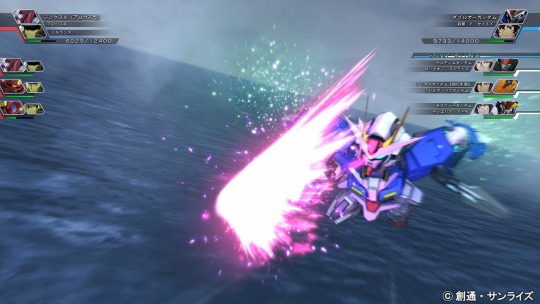
SD Gundam G Generation Cross Rays – 2019 – Steam – ★★
It is well documented at this point that I am both an active Gundam fan, and as well as an on-again-off-again tactical RPG aficionado. A SD Gundam game appearing on Steam with a good English translation and localization is… exciting, to say the least. That said, I have never had much context for this game series beyond the basic facts that the combat tended to be pretty well animated CG, and that it’s vaguely similar to Super Robot Wars. Turns out… it’s really different from SRW? I dunno how the rest of the series fairs, but Cross Rays is weird as hell.
For one, there’s zero tutorialization at all. None. Almost all of what I’m going to explain here is me figuring stuff out by trial and error, or by reading junk online. Gundam is insanely popular, you’d think they’d be interested in explaining how it all works, but… nope. Even Super Robot Wars has multi-level introductory bits for new folks to show them the rope these days.
So: Cross Rays is a tactical RPG where you can playthrough the storyline of various Gundam AUs. You can play through them in any order. These playthroughs are fairly literal translations of the stories. You take control of the lead mecha from those series, fight enemy mobile suits that show up in SRW-like tactical RPG combat, until all reinforcements cease. Pretty straight forward. There are occasionally mission variants like “prevent enemies from reaching X” or “prevent enemies from destroying Y”, but even those can be just reduced to “kill everything very quickly please.”
But here’s the thing: while there is a story progression, the characters in the story itself actually have no character progression. These characters and mecha are actually considered guests, despite it being ostensibly their story. Instead, you are able to field “permanent” mecha and pilots of your own choosing, which do have progressions. There is no plot justification for this or anything like it. The game does not recognize that it’s weird that during Iron-Blooded Orphans intro where nobody knows what a Gundam even is, you can have 25 Gundams show up at once and just fire lasers at everything. That’s because this game is actually about repeatedly grinding the same set of missions over and over.
Pilots are recruited by completing certain in-mission requirements. Mecha are acquired by either by getting enough kills with the progression-less “guest” mecha, combining mecha you already have gashopon-style, completing certain quests, or by leveling up mecha and then “evolving them”. This is the actual core of the game.
SD Gundam G Generation Cross Rays is basically Disgaea, it turns out? You’re grinding story missions at various difficulty levels in order to complete missions, try to recruit specific pilots, equip them with stats and levels to make them stronger, and then hitting mecha together in a sort of quasi-SMT fusion system until you get all the powerful mobile suits you desire.
The combat itself is kind of… bland? There’s a lot of systems, but they mostly seem in service of making an already easy game easier, or burning through tedium. There are four different difficulty modes, because there’s not actually that many different missions you can play through. The expectation is you’ll just work your way through every story beat while ramping the difficulty up over time to where the “guest” mecha would not be able to handle on their own. In fact, letting the story mecha act out the story beats is actually bad after a point, unless you’re still trying to get those lead mobile suits, or if you’re trying to complete some mission requirement in order to recruit Named Wing Grunt Pilot #246.
There is something to the notion of “I want to get N and N and N and N on a team, piloting weird but powerful mobile suits, and just solo every Gundam AU in a row,” but the whole premise seems kind of against purpose. Why bother recreating story beats at all, then? It’s not like the game even acknowledges any of that going on.
If the point is that I’m supposed to be, like in other grind-heavy tactical RPGs, breaking the systems to my own end in order to proceed… why not make the missions you play challenges focused towards that? The story progression literally only exists to facilitate the mission-based unlock conditions, which makes all the energy put into making them JUST LIKE THE ANIME really damn pointless.
I like tactical RPGs, I like breaking RPG systems so as to beat hard challenges (I beat all the insanely hard extra bosses in FFXII for crying out loud), I looooove Gundam. I should like this. But I don’t really have the “god, I NEED TO FILL THIS LIST” gene that some folks have… except as an excuse to continue to engage in gameplay I enjoy. The gameplay here seems in service of the collection, rather than the way around.
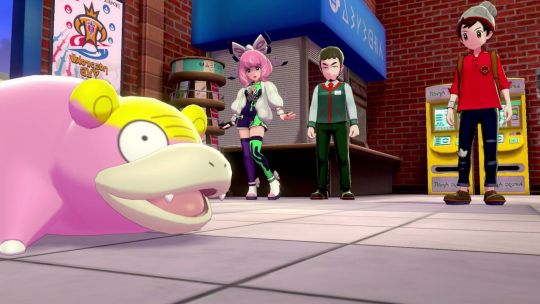
7. Pokemon Sword: The Isle of Armor – 2020 – ★★★
Pokemon’s first foray into actually doing DLC is… a mixed bag. As a positive, they’ve improved the Wild Area concept I liked from the main game, and even brought back buddy Pokemon walking behind you. That’s neat. On the other hand: the actual progression in it is completable in like an hour, it doesn’t scale with you, so you’re bound to be over leveled for it, and all the raid stuff, while still conceptually neat, is just as flawed as in the base game. And so, you’re just left with even more new Pokemon to RNG grind on to continue to catch-them-all. Nah, I’m good.
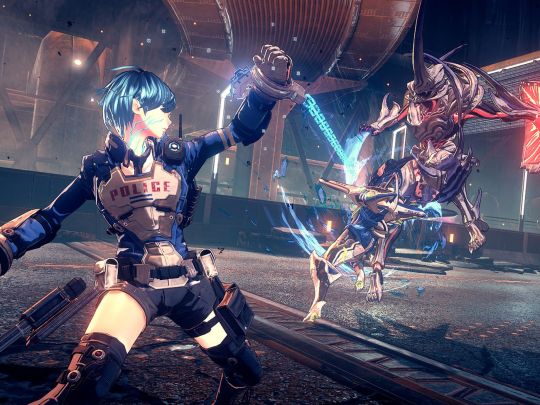
Astral Chain – 2019 – Switch – ★★★
Platinum knows how to make good character action games. They’ve made a bunch of them. Bayonetta, Nier: Automata, Metal Gear Rising: Revengeance. They also know how to make some kind of mediocre character action games. Transformers: Devastation, Wonderful 101, their various shovelware character action games like Korra. Astral Chain falls somewhere in the middle, I guess?
Astral Chain has all the production of their good games. It has some stylish, cool action. It has a neat core mechanical idea, in that it’s essentially a two-character action game where you control both characters at once. It has a lot of the old mechanics from some of their best games brought in; witch-time last second dodging from Bayonetta, Nier’s shooting-and-slashing combination, the Zandatsu mechanic from Metal Gear Rising, even Wonderful 101’s multi-unit shenanigans. The setting is different, and there’s some neat world flavor all in all.
But, of all games I’ve played over the past few years, Astral Chain made me more vividly angry than any other. It’s not that it’s too hard— far from it, really, I found its combat incredibly mashy. No, the problem is that it has so many shitty mechanics slathered on that it become a chore to get to the “good bits”.
Why would you put forced stealth sequences in your character action game, especially when your movement controls are not suited for it?
Why the HELL would you put platforming sections in your character action game, constantly, especially when your stupid ghost buddy can accidentally yank you off the edge, your auto-combos can just throw you off the edge, or literally anything can knock you off the edge and make you lose life?
Why would you put so many constant excuses into the world to force me use the digital sensor in the game, that also makes it miserable to walk around while using it?
WHO THE LIVING FUCK THINKS THESE SHITTY BOX BALANCING MINI-GAMES ARE FUN???
These games are supposed to encourage me to perfect everything, right? Why keep putting fucking fights you need to complete in order to get an S rank behind backtracking, or Legions I don’t have yet? That isn’t adding replayability, that’s just wasting my time. There are even in-level missions that have fail conditions that you never even know about. Surprise!!! A lot of them involve chasing after guys and catching them with your chain, which is really obnoxious to do!!!! SURPRISE!!!!!!!!!!!!!!
The story is just Bad Evangelion, straight up. Every story beat from Evangelion is here, executed worse. They also make your character have a twin just so they can have a character who can talk and feel emotions, because your boring-ass protagonist is stuck being an emotionless audience cipher. Cool!!!
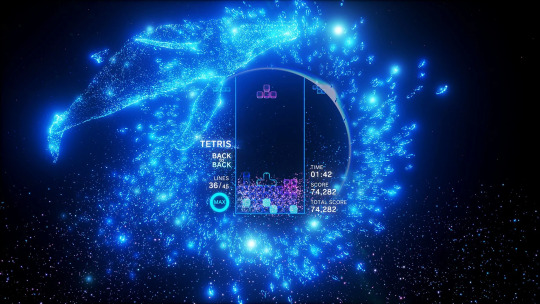
Tetris Effect – 2018 – Origin – ★★★
It’s drugs Tetris. I personally don’t use, or have synesthesia for that matter. I imagine this game is better if you do. It’s an enjoyable enough experience but it feels incredibly slight for what I was expecting from it, or even compared to something like Lumines, which has tons of replayability by way of its difficulty. Tetris just isn’t that hard, unless you’re forcing yourself to do weird shit to get points. I WILL NEVER LEARN HOW TO T-SPIN. Never.
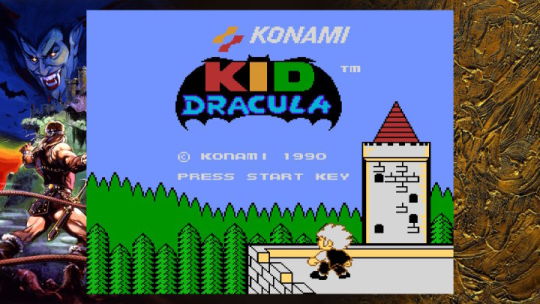
Castlevania Anniversary Collection – 2019 – Steam – ★★★
Kind of an unremarkable Castlevania collection. Neat that it has an official translation of Kid Dracula in there, but also… look, I prefer Metroidvania Castlevanias, OK?
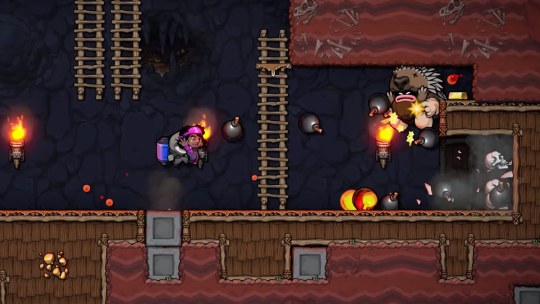
6. Spelunky 2 – 2020 – Steam – ★★★
I’m not entirely sure why this doesn’t click for me where Spelunky 1 did. More annoying intro levels? Too many fiddly requirements for different ending-progression? Gameplay additions that just make things more annoying? Spelunky 1 was hard, but there was a kind straight-forwardness to it, even with its weird secrets, that made it much easier to grok and continue banging your head against. I’m just not having as much fun with this. Difficulty should be challenging, not a hassle.
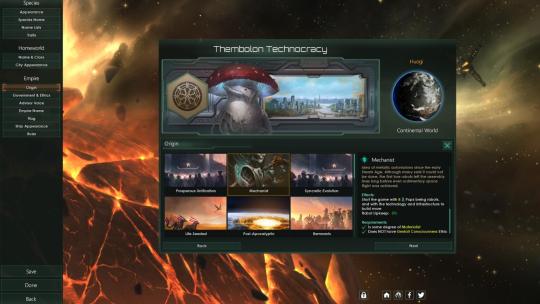
5. Stellaris: Federations – 2020 – Steam – ★★★
This is the year that Stellaris just broke for me.
Federations itself is a good DLC; it adds some really interesting mechanics tied to various types of multi-national unions (the titular federations, as well as the Space UN), as well as the addition of unique “origins” that allow you to further specialize your gameplay. The origins in particular are a great addition that allows more specialization and roleplay.
I’m just tired of the sheer amount of busywork Stellaris forces you to do. Every DLC adds more junk you need to keep an eye on, and the fact that the AI doesn’t even bother with it (compensating with copious economy boosts in order to keep up) makes the whole thing frustrating. It’s like playing fetch with yourself; you just get tired of chasing after your own ball after a point.
I have to wonder if they’re pivoting towards a notional Stellaris 2 at this point? Might not be a bad idea for them, though it is weird with all they talked up adding more origins when Federations came out.
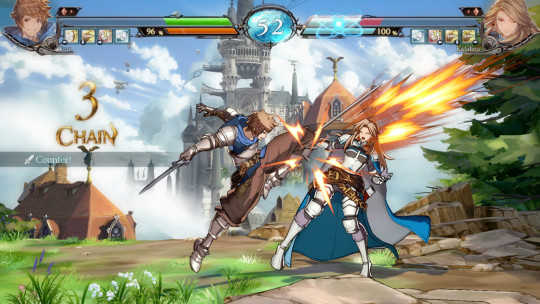
4. GranBlue Fantasy Versus – 2020 – Steam – ★★★★
This is probably the fighting game I got most into over the past few years. There’s just this nice, almost Street Fighter-esque ease of execution to the controls, and that Arc Systems Works 3D-as-2D style continues to just do work. I don’t give a single shit about GranBlue Fantasy (frankly, I think I’d enjoy this game more if it wasn’t attached to a property) but the characters are fun enough to play and look at.
The big problem here is two things: no crossplay, and no rollback netcode. In the span of a month, this game became a total ghost town on PC, and it doesn’t sound like PS4 faired that much better.

Ring Fit Adventure – 2019 – Switch – ★★★★
I’ve fallen on-and-off this game all year. At its heart: it works, it’s a fun exercise game. I don’t think it really feels like a “game” (in the sense that I’m not really coming to it for riveting gameplay or anything) as much as just a guided exercise experience, but… that’s fine? The in-game story is kind of flat, but funny in the fact of it existing at all. Buff Nicol Bolas and all.
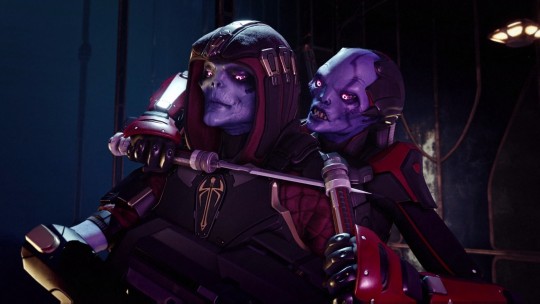
XCOM 2: War of the Chosen – 2017 – Steam – ★★★★
XCOM2: War of the Chosen is a great answer to what XCOM2 struggled with. As I discussed back in 2016 (Jesus Christ), XCOM2 tried to push against player’s worst instincts by incentivizing them to keep being aggressive through a whole bunch of timers— which, kind of just weren’t fun given how much accidentally walking into an ambush could “ruin” dozens of hours of play. War of the Chosen dials that back in some intelligent ways, by instead making the encounter designs themselves, as well as much more grab-and-bail mission types, encourage players to push ahead instead. Smart!
The addition of the Chosen makes the game feel more alive, and they really do make missions harder— particularly early on. But they’ve somehow accidentally fell into the hole, where XCOM just… isn’t that hard? Early on it’s challenging, particularly with the resource restrictions and all. But they keep giving you more and more options (that aren’t especially meaningful choices) that make your team more and more powerful, without increasing the strength of the enemy as time goes on. By the five-hour mark, you basically know if you’re going to steam roll the game or not.
The amount of additional character and variety in the gameplay is great, I just wish it had a more challenging difficulty curve. Maybe make the meta-layer of when enemies show up more targeted to where players are at. If a player is doing well, ramp up the difficulty, if they’re struggling, pull it back a bit. I should always feel like I’m just barely keeping ahead with XCOM, not like I’m bored. And by the end of War of the Chosen, I was kind of getting bored, really. Oh well.
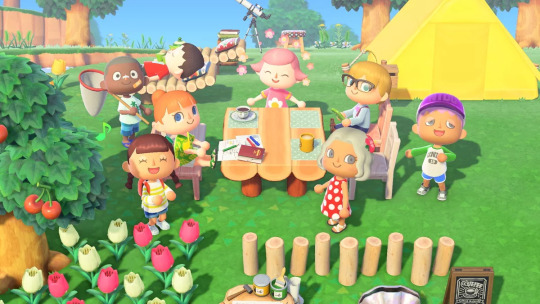
3. Animal Crossing: New Horizons – 2020 – Switch – ★★★★
This is probably the video game that I spent the most time with hours-wise this year. I’m not entirely sure why? It’s a nice evolution of New Leaf, in that the crafting, environment shaping, and general quality-of-life improvements made are quite nice. There’s clearly been some thought on how people play these games, and ways to make the experience less frustrating.
… and yet, they kept so much tedium in the game. Like yes, the schedule stretching is the point, I get it. As someone who for some reason decided not to play with the clock, I only just recently finished the fish, fossils, and insects for the museum. But there’s just so many weird, little things that just make it hard to keep coming back to it. It’s like… to what end? When I’ve unlocked everything, and basically seen the entirety of the item list at this point, and the holiday events all being the game meaningless collectathons…. Why? I’m not going to try completing the collection; the museum stuff is about my limit, really (and even the paintings I can probably pass on).
I guess even an idealized, digital representation of a quasi-domestic life has the spiritual emptiness of consumerism-for-consumerism sake. Thanks???

Hypnospace Outlaw – 2019 – Steam – ★★★★
I grew up on the internet of the early 00s. I had an AngelFire website, mostly consisting of shitty sprite webcomics and hosted Gundam pics. I remember when Google wasn’t really a thing and you would heavily rely on website compilation sites like the Anime Web Turnpike in order to find anything of value online. It was weird, it was wild. It was exciting!
The internet seemed so different back then. There was a ton of garbage online, but also, like… there was a sense of optimism to it. Folks were shitty, there was plenty of bad stuff online, but it felt so disconnected from the fabric of the physicality of real-life that it was at the same time a perfect escape.
I was young when I first got “online”, something like 12. I remember having this notion that the internet was going to be this great equalizer, that it had infinite potential to change how people behave and interact. Boy, huh.
Hypnospace Outlaw is essentially a splendid alternate universe GeoCities recreation, where you’re a volunteer moderator of a grouping of websites on HypnOS, an internet-analog you access while you are sleep. At the surface level, it’s mostly about poking around the weird alternate-historical version of the internet they created, full of kids feuding, bizarre historical divergences, and plenty of amazing bespoke weirdness. All of this is great; there’s an incredible amount of content that’s just great to poke at, listen to, and explore.
Below the surface, there’s also a rolling plotline about the ethics of this industry-owned platform, those who run it, and the way corporations handle new technology, new platforms, and emerging digital societies. There’s a late game turn that’s pretty damn affecting. And as someone who has moderator his share of internet forums in his time, trying to balance ‘do it for the community’ and what your ostensible ‘bosses’ require of you, it was kind of a weird throwback in more ways than one.
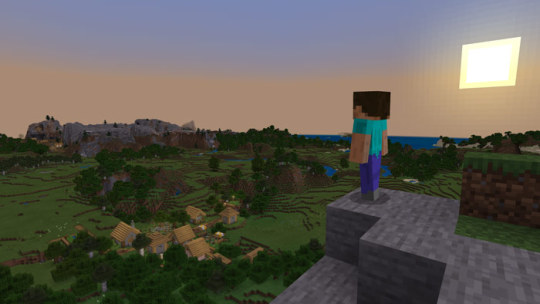
Minecraft – 2011 – PC – ★★★★★
Turns out, Minecraft is really as good still who knew??? Started playing a bunch more of it this year due to Giant Bomb deciding to do so, and yeah: still good!

2. Hades – 2020 – Steam – ★★★★★
I’ve said it before, and I’ll say it again— Supergiant makes damn good games. I’d been holding off on checking out Hades until its full release due to my tendency to burn out on games easily, and I’m glad I waited. Hades is a fantastic rogue-lite experience. The way it makes narrative progression part of the reiterative, randomized rogue-lite structure is just perfect.
It’s got all the usual Supergiant bullet points. Great characters, voice acting, narration, and music. In terms of gameplay, it’s probably their least ambitious game— playing something like a cousin to their original game, Bastion— but it’s also been polished to a mirror sheen. It just feels really damn good to play, over and over and over.
That being said, the second (final?) ending feels kind of…. Tacked on? It’s fine as a goal to go for while continuing to do the game’s relationship mechanics for additional story bits, but it ends up feeling kind of unfulfilling compared to the payoff of the first one.

1. Crusader Kings III – 2020 – Steam – ★★★★★
I never could get into Crusader Kings II. Despite my interest, the sheer mechanical heft and unintuitive interface made the game a wall that I just couldn’t get over. I’m sure if I’d dedicated myself I probably could have learned it, but… ehhhhhh.
Crusader Kings III, on the other hand, has a good tutorial, a cleaned-up UI, and a very helpful highlight and tooltip system that make it much easier to understand how to actually play the game through resources inside the game itself. And, as it turns out: I rather love this game.
I mean, conceptually it’s an easy sell, isn’t it? Historical politics is something I enjoy broadly. I liked Stellaris but wish it had more narrative, roleplaying elements. They outright say that “winning” isn’t really the point of the game. Instead, it’s more about emergent storytelling and playing with the different systems and seeing what you can do with it.
My current game has had me taking the Haesteinn dynasty from its Viking origins into England, forming a London-seated Northern Sea Empire that encompasses all of Britannia, Iceland, Holland, Norway, and Denmark. I am currently working on hegemonizing Norse religious control over enough Asatru holy sites to finally reform the religion, such that more unified feudalization can occur. To that end, my current ruler’s predecessor invaded West Francia and conquered the whole of its territory, substantially reducing the foothold of Catholicism in mainland Europe… which seems to have kicked the hornet’s nest, given the Crusade I’m going to need to contend with next time I boot up the game.
Of course, a complicating matter is that my current ruler— the Emperor of the North Sea, King of Ireland and the Danelaw, liege of the King of Denmark, was elected from the extended Haesteinn family via Thing, the Scandinavian council of his erstwhile vassals. Where the previous emperor, the one who manufactured the invasion of Francia, was quite religious and beloved for his adherence to the old ways, I discovered as I took over as his successor that he really, really is into just boning down across Europe. We’re talking constantly attempting to seduce neighboring Queens and Princesses. His vassals are not thrilled with this. They also don’t care for his propensity for torturing people to death, constantly.
I had no real say in this; attempting to stay on top of a dynasty is kind of like riding a bucking-bronco, so many things are only tenuously under your control that some weird shit can happen. This is especially true when you use the systems that make it easier to maintain the coherency of your domain. The Norse religion encouraging concubinage results in you having a lot of kids, which means there’s a lot of domain partition going on (someday, primogeniture, someday). Naturally, using Thing election reduces that, but also makes you sometimes end up having to play Emperor Stabbo-Fucko because they thought he was the best candidate at the time. Hell, I thought he was the best candidate at the time until I discovered just how many people he’d be laying with on the low. But you just have to roll with it.
The way the game forces you to play ball with character traits is great. Doing things that match with the character’s traits makes them lose stress. Doing things against their character increases stress. Too much stress can force you to make the character take up vices (which can make them suffer health or opinion maluses, as well as altering their aptitudes), or even die outright. And sometimes those vices and attitudes can be boons, given they open up opportunities for different character interactions.
Emperor Stab-and-Fuck-Kingdom is perhaps the most relaxed person alive, it turns out, because his sadism makes him really enjoy sacrificing infidels, which makes the gods happy. It also freaks the fuck out of all of his vassals, so they’re a good supplicant mix of both appreciative of my religious sentiments and also utterly terrified of my skull piles. Some especially brave vassals occasionally try to assassinate me, but my lovers keep jumping in front of the knife and saving my life mid-coitus. Iiiiiit happens! :D
The game can be incredibly fun to just watch, as it becomes emergently weird. Georgia right now is incredibly Jewish in game. I’m not sure how that happened; I guess someone made a random Jewish guy into a vassal, who somehow moved up enough in the world to make it a movement? The Byzantine princes elected a Coptic as Emperor, which over the course of the decade resulted in very accelerated balkanization as Byzantium just lost its shit. The Middle East and notional HRE haven’t really unified in a meaningful way, so I’m curious how things are going to go if/when the Mongols unify and roll-on in.
It’s one of those “Just one more thing” games that can completely devour time. I have more than a few times checked the clock mid-game to see that it’s 4AM and that I’ve totally ruined my sleep schedule in the process of play. Oooooops.
I highly recommend checking it out if you’re curious; the introductory, pre-release video series Paradox put out showing off the game does a pretty good job of showing the core gameplay loop and also how weird it can get.
9 notes
·
View notes
Text
Every Game I Played in 2019, Ranked
2019 sure was a year that happened where I happened to play some video games. Here’s the ones I played enough to form opinions, in a rough ranked order of preference.
It’s kind of weird that I’ve done this for five years now, but hey. I like to talk about things that I like / dislike. Hopefully you’ll empathize with my complaints, and give ones I enjoyed a try.
As a bonus, I also tweeted about the anime I watched and enjoyed this year.
2015 | 2016 | 2017 | 2018

Orm & Cheep: Narrow Squeaks – 1985 – ZX Spectrum – ★
How far would you go for a joke? For the sake of a joke, I spent an hour beating an incomprehensible, shitty ZX Spectrum Game about Orm & Cheep, an 80s British children show I only know about from a Trash Night video making fun of it.
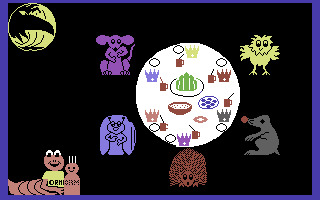
Orm & Cheep: Birthday Party – 1985 – ZX Spectrum – ★
… and also this one, though Birthday Party is marginally better than Narrow Squeaks. Marginally. Extremely marginally. Congratulations to Orm & Cheap: Birthday Party.

16. River City Girls – 2019 – Switch – ★★★
The style of River City Girls is great. I like a lot of what it’s doing in terms of look and sound. It’s just that… well, River City Ransom’s gameplay was interesting something-like 30 years ago. Gameplay wise, this game hasn’t evolved that much from OG RC Ransom. The combat certainly feels better, but as far as it controls… I can’t tell if it’s not taking advantage of modern controllers and just sticking too close to the original’s control scheme, or if side-scrolling beat-em-ups are themselves just so staid and dated these days that there’s not much to be done. I just wasn’t having much fun, and the RC Ransom progression of new techniques and stat boosting didn’t exactly make me want to keep going.
It’s a real shame because in terms of pure aesthetics and concept, the game is amazing. I just don’t actually enjoy playing it. Oh well!
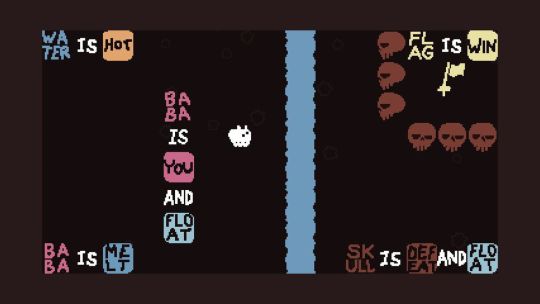
15. Baba is You – 2019 – Switch – ★★★
The core gameplay concept of Baba is You is fantastic. The way you manipulate nouns and verbs to construct phrases that operate as equations in a physical environment is super interesting. The early goings of the game were quite fun.
The problem I have with this game is that when you hit a wall in it, that wall can sometimes be impenetrable. I found that Baba is You is at times too subtle with its attempt to “teach” you tricks or onboard you into approaches to puzzles; it’s possible to come to solutions without taking away the lesson the designer intended, which can make later puzzles basically impossible.
The difficulty curve feels all over the place; I was extremely high on this game early on, but after getting completely blocked moving forward for hours on end, with the only real recourse being to either look stuff up or stare at past puzzles to try to figure out what apparently crucial lesson I missed despite coming to my own solutions, I ultimately decided to just do something else.

14. Cadence of Hyrule – 2019 – Switch – ★★★
Zelda has great music. Crypt of the Necrodancer has pretty good rhythm-game action. Combine them, and you get… well, it turns out you get a pretty OK procedurally generated Zelda-game with Necrodancer mechanics, I suppose. The appeal is easy to understand, though I’m personally not sure I care much for the final product.
I enjoyed the original Necrodancer well enough as a simple run-based, short-ish rhythm dungeon crawler. The brevity of each given “run” (stemming in part from my own inadequate skill, I suppose) worked well with the style of gameplay, in that it never really became much of a chore.
Meanwhile, I enjoy Zelda as an extended puzzle adventure game where there’s an innate unthinking flow to the actions. I’m not typically thinking much about the moment-to-moment about the actual mechanics of the action; the brain’s desires flow directly to the motion on the screen, as it were.
Combining the two results in a Necrodancer experience that’s way too long, and a Zelda experience that is way harder to control. Add the fact that the procedurally generated world isn’t that interesting and I’m just rather lukewarm on this. Meh!
youtube
13. Super Robot Wars T – 2019 – PS4 – ★★★
It’s fantastic that Super Robot Wars is finally getting proper, high-quality localizations again. It felt like a dream to finally be able to play this franchise again after being forced to stop after the DS era. Playing through the rather roughly translated, and somewhat monotonous SRW OG: Moon Dwellers was good because the OG games tended to have the highest production values and narrative quality (missing out on 2nd OG may have also helped). SRW V was my first foray into the more recent non-OG games, and so shined as something rather fresh to me.
Two years on, and two Super Robot Wars releases later, it’s plain to see that Super Robot Wars’ current annual release cadence is not great. It results in incredibly repetitive, monotonous games that rely heavily on asset reuse— both between games, and even within the same game. Part of the problem is that the derivativeness doesn’t feel additive. It’s not like SRW T is SRW V + SRW X + New Stuff; it’s more that SRW T is a reskinned SRW V, with some heavy series-asset reuse to boot. I think it’d be a bit more tolerable if it felt like these games were building on each other, but every single one feels exactly as slight and mechanically weak.
Super Robot Wars’ combat have not been particularly good from a tactical sense for a long time now. The original OG games were probably the last time the combat was particularly interesting for me, as it presented an actual challenge and difficulty curve. Nowadays, they are entirely fanservice cakewalks, even on the hardest modes. Hell, they’ve apparently decided that increasing the difficulty of the game means you don’t get to chase the special challenge goals, which actually can paradoxically make portions of the hard-mode actually easier than the normal. Bizarre!
I guess the idea is “well, folks are playing this to see the bits, so if it’s hard they won’t!” Which… I disagree? If the gameplay is deeply unsatisfying, why wouldn’t I just watch the damn series? Crossover shenanigans don’t mean much whey you don’t do much with it. Fanservice talking heads ain’t enough!
The addition of Cowboy Bebop and the return of GaoGaiGar and Gunbuster should have had me onboard. The series list for this game is fantastic. But what they do with it is so flat that about 30 chapters in, I just… stopped. It wasn’t worth it. I’d plainly seen all that it had to offer. Easy, slow, and repetitive gameplay isn’t appealing to me, even if I do get to see Spike Spiegel doing sky donuts to take out a Zaku.
Additionally: stop putting Nadesico in these games. The units are boring, the plot is boring. Stop devoting so much time to it! It sucks!!
youtube
12. Ape Out – 2019 – Switch – ★★★★
Ape Out is a game where you’re a big ol’ gorilla murdering guys with guns while dope ass percussive jazz drums play to the action. It’s cool, it’s short, it could honestly probably do with being somewhat shorter, but whatever. I enjoyed it.

BattleTech – 2018 – Steam – ★★★★
Despite being famously a “mecha guy”, BattleTech has never really been my thing. While I’m not opposed to mecha-as-tank-analog, it’s not my primary focus in the genre; I like my robots to be fast, really. I like mecha getting into melee and fucking shit up. Mecha for me is a power fantasy. That’s not really BattleTech / MechWarrior’s thing. That all being said, I quite enjoyed my time with BattleTech, the PC-game rendition of the tabletop thing. It’s a neat turn-based tactical robot combat RPG with an interesting overarching campaign structure… to a point.
The first issue I had is pacing. While the game is turn-based, the combat and movement plays out in real-time. And given how lumbering these robots are, this means that a single mission can take aaaages. Think 45 minutes to an hour for a single mission. It took me about 20-30 hours to get to the campaign’s halfway point, which is when the game really started to sour on me.
The second issue is one of variance. Let me run you through the fundamental loop of the game. You are a mercenary captain that has a ship of mechs and mech pilots, and you fly around from planet to planet taking on jobs. You need money to pay for your ship to keep going, as well as to pay your pilots. It’s expensive to outfit your mechs, and severe damage to them can both REALLY eat into your budget and also take weeks in-game to repair. Missions are rated based on difficulty, and you are expected generally to field a greater “tonnage” of mechs in excess to that difficulty. This all plays out pretty well.
The game starts with you possessing mostly lighter mechs, and as you progress, you’re presented more and more missions in the campaign that require increasingly beefier mechs with more armor and more guns. Whereas in the tabletop game there’s presumably a kind of “point” system by which players are given a limited amount of tonnage that they can field on any given mission (for purposes of balance), there’s no such limit in the game; as such, you’re encouraged to field the four-ish beefiest robots you have, as they’re the most likely to kill everything fast while coming out with the least damage.
How do you get these beefy mechs? Well, you don’t buy them; instead, you’re aiming to kill opposing pilots and leave their robots as much intact as possible so that you can salvage or steal them. It’s kind of amusing; your entire gameplan after a point becomes “how the fuck do I shake this robot around a bunch such that its pilot dies???” It makes sense in practice, but if you think about it for even a second it comes across rather silly. Given you need good mechs to progress, you don’t have much other choice other than just running tonnnsss of missions and hoping you eventually get enough mech fragments to reconstruct some of your own. But beefy-ness isn’t the whole story, as some of the robots you can get just plain suck, regardless of their tonnage. You’re basically rolling dice again and again hoping a robot worthy of stealing shows up so you can kill its friends, and try to kill its pilot as gently as possible. You go through this cycle four times, across the four different weight-classes, until you’ve got what you need in terms of a team of class-appropriate mechs.
The fundamental lack of variety in what you field combines with every single mission really being “how do I kneecap everyone” instead of the given mission objective to make the game quite samey. Mission types don’t vary much, and the environments don’t constrain you all that much, either; the only ones that are particularly interesting are moons and Mars-like planets where your mechs’ ability to regulate their heat become much more constrained, which can necessitate loadout changes.
I enjoyed the story enough for what it was, but honestly? After 30 hours, I was pretty much good. I had a good time with BattleTech, but I’d had my fill.

Mortal Kombat X – 2015 – Steam – ★★★★
In my ongoing adventure of playing the Mortal Kombat games for their goofy plot / story modes and nothing else, I played Mortal Kombat X. I’m not sure there’s much to talk about these other than “Hey I enjoy their dumb ongoing narrative; I wonder where they’ll go from here!”

11. Mortal Kombat XI – 2019 – Steam – ★★★★
Ditto. The plot for these games are getting sillier and sillier, and the ending of XI may be the most ridiculous yet. In a good way.
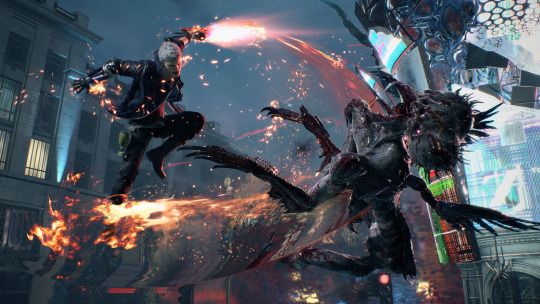
10. Devil May Cry V – 2019 – Steam – ★★★★
Character action games are heavily predicated on the question of “How do we spice the game up over time so that it stays interesting… without overwhelming the player?” Devil May Cry V’s answer is “well, we’ll slowly give them more characters with their own expanding skill sets, that’ll be neat!”
It is neat, but I’m not sure it was actually a good idea. The three protagonists all have extremely different move sets, meaning that the forced switches between them on a chapter-to-chapter basis results in you never really mastering any one of them. Each character has a ton of depth, but… take, for example, Nero, the “main” protagonist. He has a sub-mechanic involved with revving his motorcycle sword to boost damage. I never actually figured out how to get to work. Never really had to, because he had so many other mechanics that were also effective, and I never had much time with him alone to dial in the weird motorcycle thing.
DMCV also does probably my least favorite gameplay gimmick of “introduce new mechanics in a boss battle!” Like great, you gave me a whole new move set here, and are now going to rate me on my performance when you’ve never given me a chance to learn these skills? Oh wait, you’re giving me new mechanics in the final boss battle!?! Fuck off. That sucks!
Also, I think I’m an outlier, but I actually preferred playing as V, the control-three-characters-at-once-while-reading-a-book guy. Just felt like I dialed his move set in easier. Weird.

9. Untitled Goose Game – 2019 – Switch – ★★★★
I’m not going to pretend that this is a deep game, or an enduring game, or even necessarily a great game. But I had a lot of fun with it, I have a lot of good memories thinking about it, and I am glad that so many people out there are now wrestling with the fact that birds can be both terrible and also good. Untitled Goose Game carries a powerful message about avian kind. You would do well to learn from it.

8. Super Mario Maker 2 – 2019 – Switch – ★★★★
Mario Maker 2 is such an incremental upgrade to Mario Maker that it hardly feels like it earns that “2”. That being said: Mario Maker 1 is pretty darn good so it’s not like that’s all that bad. The additional mechanics and story mode are good, granted, but like… I had been wanting more than just Mario Maker 1.5.
As is, it was pretty easy to get bored with Mario Maker pretty quickly, given it was mostly a game I’d already played quite a bit before. The addition of the campaign held my interest for a fair amount of time, but I’m not exactly coming back to this all that often. Hopefully the content updates they seem to be rolling into it keep up.
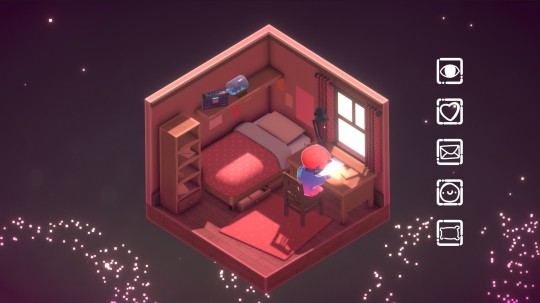
7. Kind Worlds: Lo-Fi Beats to Write To – 2019 – Steam – ★★★★
This is less a video game and more a sort of vague pen-pal application masquerading as a game, but man… the existence of this thing is neat. It’s just a program where folks write letters about their problems, and people send them stuff back. That’s it. It’s kind of a sweet thing to just exist.
I’m not a person with what would one term especially Heavy Problems, but just going through other folks letters and giving them an encouraging word is itself nice.
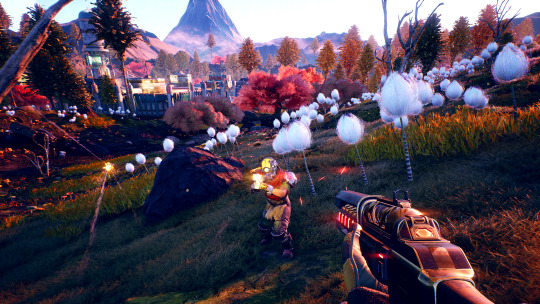
6. The Outer Worlds – 2019 – Epic Game Store – ★★★★
Having been deeply disappointed with the quality of Fallout 4, I was very happy to see Obsidian come back to do their own Fallout-a-like. The Outer Worlds isn’t perfect; I wish it had a bit more of a bite, the gunplay was… fine, the environment design was kind of dull, and the gameplay loop did not outlast the length of the game itself. But I had a fun enough time with it.
That said, I think the dearth of me having much to say here sort of speaks to how… rather unambitious the writing and design ended up being. There’s not a ton to say about it. It’s more responsive than a Fallout 4, to be sure, but even that caps out at a point. It doesn’t necessarily offer much in the way of RPG-style different “paths” to develop your character in terms of who they are or how they behave, beyond the sort-of four-way axis of “grouch to nice” and “corporatist to socialist.” The skill tree ends up being pretty flat, and you can basically become a master of everything by the end.
Shruggo.

5. Pokémon Sword – 2019 – Switch – ★★★★
Pokémon Sword/Shield is a bizarre thing— its design is constantly fighting against itself. There are tons of ease-of-use improvements– but it somehow has some of the worst online in the series. It gives you dozens of complex, half-explained systems— but also feels the need to hold your hand lest you get lost in its incredibly linear, dull story. It adds challenging Pokémon raid battles that you largely need to team up with other players to beat— but also has one of the most trivial progressions in the series. It has a huge and varied open “Wild Area” where you can catch hundreds of Pokémon before ever facing the first gym— but that wild area largely exists as a world unto its own separate from the traditional Pokémon “routes”. It doesn’t want to have a plot up until the very end when it decides that gee, I guess we have to, even if it makes no sense.
Let’s go into these in more detail.
Sword/Shield introduces a ton of gameplay improvements. Auto-saving, while problematic in places, is super useful. The ability to move Pokémon directly from the box to your party is great, and removes a lot of process headaches. Single hand controls are a godsend for both improved accessibility and general ease of use. Items are way easier to get, Pokemon are easier to raise, and this is probably the easiest game in the entire series to breed and raise “high tier” Pokemon for online battling.
On the other hand: despite your friend list being loaded into the game, you are forced to use a bizarre password system and request system that is super confusing and prone to issues. You cannot directly trade or battle or play with friends except through this, which occasionally results in headaches anytime someone uses the same four-digit password as you and your bud. The Max Raid battle system is super poorly explained in-game in terms of how you find and join others raids— I only divined it by a tweet someone made. They did away with the “GTS” trading system they had used for the past decade that allowed global Pokemon bartering, presumably in favor of encouraging more natural trades— but didn’t give any way to actually communicate with people in game what you want to trade for. It encourages more in-person interaction, but that’s once again playing into Game Freak’s obsession with the Japanese mode of gaming.
Sword/Shield perhaps has the most sheer amount of systems in any one of these games. It’s not necessarily all good, but in terms of “wow, you’re not babying us huh” it is at least interesting. There’s Pokemon that evolve based on absurd, never-explained conditions like “number of crits in a single battle”, “pass underneath this specific rock when they’re at low health”, “spin baby spin.” The wild area has tons of mechanical stuff that they let you explore without forcing your hand much, and they let you explore it freely without really railroading you. There’s a separate wild-area specific currency system based on raids / dens that you just stumble upon unprompted, really.
On the other hand, the core story progression of the game though… is perhaps the most infuriatingly patronizing thing I’ve experienced. Cutscenes happen every 15 seconds, often-times forcing your movement, and are almost of zero consequence beyond someone going HEY YOU SHOULD GO THAT WAY. The game is completely unwilling to let you get lost when going through the story. It’s constant, it’s unrelenting, it’s maddening. It literally made me mad.
Pokémon Raid battles are super interesting. The battles themselves aren’t necessarily hard, but the kinds of things they present— in terms of providing access to unique Pokémon, rare items, and the fact that they’re not as “rinse-and-repeat” as normal battles— gives the system and game increased longevity. It’s a pretty deep system, with meaningful rewards. A five-star battle is time consuming and you run the risk of failing, but if you pull it off you can get items like TRs, EXP candies, even bottle caps (super useful items that let you increase the baseline stat “DNA” of your Pokémon), and the captured Pokémon can have unique moves you’d normally have to breed and possess extremely high baseline stats. You can even get hidden secret abilities! Nice!
On the other hand: the core game progression is so piss easy and straight forward. The game’s leveling curve is all out of whack, in part because their introduction of a forced “always on” EXP share. In older games, you’d only get EXP from actively battling and beating a Pokemon in a fight, or having participated in a fight. Now, your whole team gets EXP just from being around, and you also get EXP from catching Pokemon, making curry, and all sorts of other small activities. All of this is fine or even good in the abstract as it makes raising stuff easier, but the game isn’t well balanced around it. Encounters don’t scale, which can result in you steamrolling the game if you engage with any of the game’s other systems prior to beating the game. I had to compensate by stretching my normal party of six into a party of 10, constantly swapping members out to keep the average level across the party down. Additionally, the only non-PVP reason to train and breed pokes, the Battle Tower, is so trivially easy this time that… why bother??
The wild area system is brilliant. A big criticism I’ve had with this series in the past is that the kinds of Pokemon any given player is bound to encounter and capture tend to be pretty similar. The limited amount of Pokemon that tend to be put on a traditional Pokemon route, and the limited means you have to encounter them (“hey I walk through the grass, we’ll see what pops up”) doesn’t trend towards players ending up with very different party compositions, just because there’s not a ton of options at any given point. The wild area completely tosses that out the window. As an open space, the types of things someone encounters will vary wildly— and it’s further varied by player-specific weather conditions that dynamically change the encounter tables. It completely opens up the kinds of Pokemon one can encounter early on, presenting hundreds of appropriately leveled options for players. It’s brilliant. The intermixing of both grass-only, overworld-visible, and raid-specific Pokemon also increases the range of encounters. It’s the accomplishment of the core Pokemon concept of “explore and find everything.” Finally.
On the other hand: the wild area is actually kind of boring to explore, visually speaking. It’s basically the Ocarina of Time field with sporadic patches of grass. There’s little actually diversity or mechanics to its exploration, especially when compared to the fact that… the game still has normal routes. They still behave as they always have, except that by the total remove of “Hidden Machine” mobility moves, the ability to explore geographically has been severely hampered. There’s no “gee, I can’t get there yet, guess I’ll have to come back later” except for a single mobility mechanic (the ability to go over the water, introduced very late in the game). It makes revisiting past areas mostly a box-checking exercise, and in general feels like an odd juxtaposition. They either should went all-in on the wild area or better merged the concepts together, because as is it feels… weird. Especially because the wild area could have done with being bigger and more diverse looking.
The game spends most of its time having no story at all, which is kind of boring. Juxtaposed with the railroading stuff where there’s still constant cutscenes with their mostly mediocre characters who don’t do all that much, it almost comes across as padding than anything. There are good characters (Piers and Marnie are the best, the gym leaders in general are good) but man do they try too hard to put Leon over.
But then at the end they introduce the story super quickly and it’s very dumb in a way that made me laugh out loud so congrats I guess.
All in all, I rather liked Sword/Shield. It’s no Sun/Moon— which innovated in tons of places and had an extremely charming story, cast, and progression— but the places that it innovates, and the ease-of-use improvements that they’ve put in the game, are great improvements to the baseline formula. While it’s caused a ton of drama online, the Pokédex and Pokémon Bank stuff are not huge impacts on my personal enjoyment of the game. It kind of stinks a bit, but the overall package is still quite good and fun.

The Legend of the Zelda: Breath of the Wild, Master Mode – 2017 – Switch – ★★★★★
Breath of the Wild was my favorite game the year it was released. The harder Master Mode is something that had interested me as something to check out for a replay, but I decided to wait until the shadow of my previous playthrough loomed somewhat less. Breath of the Wild is, after all, both a monumental game and also a monumentally large game. Going back to it for Master Mode would mean (by way of my own obsessive brain) 100%ing it all over again, which is extremely time consuming, even if I don’t go after the all the Koroks.
There was also this sort of reticence in my behind to confront the creeping suspicion I’ve had in my mind that some of the DLC additions have made the core game worse. Which, I would say… is probably somewhat the case. Certain DLC gear items extremely imbalance standard play and really fuck with the exploration of the game (specifically, Majora’s Mask basically making you not have to fight multiple enemy types). Still, I knew I could ignore those, and just focus down on the core experience of Master Mode: harder enemies, regenerating enemy health, and the introduction of floating platforms.
Turns out, BOTW is still fucking amazing, and while the additions Master Mode make aren’t essential, they do make for a fun second run of a fantastic game. The harder enemies make the early parts of that game WAY HARDER (making you really have to get good at using your bombs and stealth), and while that difficulty ramp doesn’t keep up throughout (which, honestly, the platforms are somewhat to blame as they make getting certain bits of higher-level loot earlier easier), it’s still just a great game to go back to.
Breath of the Wild remains my all-time favorite game. Hyped for BOTW2.
youtube
4. Sekiro: Shadows Die Twice – 2019 – Steam – ★★★★★
Sekiro is in a sense the purest expression of the Souls formula. Stripped away of the jolly co-op, the PVP, the stats, the equipment, and most customization to speak of, Sekiro asks the simple question: can you do this? Can you learn all the systems in this quite challenging game, and engage with it on its own terms?
In its mechanical simplicity, I found Sekiro to be my favorite game of that lineage, as it has allowed them to really polish the gameplay by its singular focus. It just feels amazing to stealth around and backstab dudes, parry everything, and triumph in nail-biting sword duels. While you do gain new skills and equipment (in the form of the ninja tools), they are just supplementing the fundamental systems of the game, rather than acting as diverging ones. So really, most of your time is spent not learning wholly new methods of combat, but instead improving your mastery of the core one.
And the feel of mastering that combat is incredible. By the end you feel unstoppable; normal enemies that would have been challenges early on are nothing. Even a lot of the bosses become trivial as-time goes on, bar the few ‘mastery test’ bosses interleaved throughout the progression. This isn’t some “hey I got more EXP and now over-level for everything!” thing, either; this is me, the human holding the controller getting skilled enough to become a Sekiro master. It’s an amazing feeling.
I beat every single boss in the game, including the hidden ones, and enjoyed the hell out of it.

3. Bloodstained: Ritual of the Night – 2019 – Steam – ★★★★★
I’m very much on the record as being a huge IGAvania partisan. I fuckin’ love the core loop of that permutation of the Metroidvania formula. Koji Igarashi no longer being able to make Castlevanias hurt me. A lot. Over a decade of time spanned between the last IGAvania game, Order of Ecclesia, and the release of Bloodstained. I was a bit worried.
Thank god Bloodstained is really, really, really good.
Bloodstained is extremely “one of those.” You move about a 2D interconnected world, collect items and abilities until you find the stuff that let you move forward in a new area. It’s kind of an eclectic hybrid of IGA’s past titles. The castle design feels very Aria of Sorrow. The shard mechanics feel close to Aria/Dawn of Sorrow’s soul system. The weapons feel very Symphony of the Night meets Portrait of Ruin. The overall mechanics of movement feel most akin to Order of Ecclesia. All in all: a good mix.
The game is massive. There’s so many weird one-off mechanics (something I appreciate), bizarre callbacks, goofs. There’s an in-depth alchemy system (mostly used for cooking, which is funny). The shard system is a bit boring in places— some shards are extremely simple and forgettable mechanically— but the shard leveling system is kind of hilarious in how broken it can become. The familiar system from SOTN is back and has been essentially perfected by making it a dedicated slot so you can just hang with a fairy or sword pal.
I wish the game had more enemy diversity, and the story left something to be desired. Many shards just aren’t very interesting. But the game is just so dang fun. The core gameplay loop is just so compelling, and the game just feels so dang good. I’m glad they took all the time to polish the gameplay feel because hooooooooooo boy.
Looking forward to those DLC characters for some additional playthroughs.
youtube
2. Outer Wilds – 2019 – Epic Game Store – ★★★★★
“Space exploration”, “cosmology”, “archeology”, and “sociology.” While these are certainly not the only fields that dominate much of my attention, they are some big ones. The Outer Wilds is a space exploration game where you explore the structure of a strange but exquisitely constructed solar system, and dig through the remains of a mysterious vanished alien species. Also, you’re stuck in a Majora’s Mask-like apocalyptic time loop ‘cuz the sun keeps exploding. Should probably find out why that’s happening.
I went into this game completely blind, entirely based on the way Austin Walker was raving about it on twitter. Austin’s interests in heady space shit is pretty similar to my own, and turns out? Worked out quite well for me. I blindly explored this solar system for about twenty hours over the course of a couple weeks, and came away from the experience misty eyed at the ending. Outer Wilds is fantastic.
It’s a surprisingly touching and cozy for a game that mostly about you going off into space on your own, all alone. And that’s because you’re not, really. Outer Wilds is less about the science of exploration and archeology and the meaning of it, why it matters even in the darkest moments. Why do we explore? Why does science matter, divorced from the parasite of industry and markets? What value does it give to us, to future generations?
The game is built on the notion that even as we individually wander, explore, and discover, we’re all together collectively building on something that may outlive us, even outlive our species, the pursuit of a collective knowledge that transcends personal enrichment and individual accomplishments.
You are but one a few alien explorers, each on their own adventure. As you adventure, you catch their signals as you cruise across space. The things you learn and do are further built on the relics and messages left behind by the Nomai, the species that came before. This sense of a personal and emotional connection in the act of discovery is the heart of this game. We’re not standing on the shoulders of giants; we’re holding hands with those before us and those after us to build a bridge to a future that we may not live to see.
It’s a positive message of hope in the face of oblivion.
youtube
1. Fire Emblem: Three Houses – 2019 – Switch – ★★★★★
I’ve been really on-and-off on Fire Emblem over the years. I first got in on the franchise with Awakening, which I rather liked for its anime-ass sensibilities— though not without criticism. I found the combat kind of obnoxious in its tendency to get muddied down in the Oops You Done Fucked Up, Time To Reset junk. It was too anime-ass in some places, not the least of which being its incredibly one-note characters who had little bearing on ongoing events so as to support the permadeath system without too much wasted effort on the developers’ part. Fates, the follow-up on Awakening, only amped up these criticisms, becoming convoluted, stupid, and kind of obnoxious to play.
I had hopes that Three Houses would be an improvement. Initial impressions made it seem way more serious, way more grounded, with a lot of improved systems. Turns out: it was better than I could have dared of expected or hoped. Three Houses isn’t improvement, or even innovation; it’s a revolution.
Three Houses is great. It’s long, it’s got so many different systems going on that I hardly know where to begin with describing it, but… it’s great. It’s the platonic ideal of what I’d like out of a Fire Emblem. Things feel like they matter. The setting feels weighty, the plot is actually good, and the characters are absolutely marvelous.
No, it’s not perfect— its handling of representation could DEFINITELY be better. Some of the narrative is hokey as hell in places. Certain routes seem to have gotten more attention than others. The class-based specialization systems could do with more depth such that so many characters don’t end up mostly identically specialized to each other.
But… I found the combat extremely enjoyable. The charge-based rewind mechanic removed the feel-bad gotchas of unanticipated troop appearances and bad rolls etc. The characters are fun, and they’re kept relevant all the whole way through via creative framing of events. The ability to roam an actual physical space via the monastery made the world feel more alive, and made everything feel more real.
The writing was actually interesting and nuanced, exploring things like faith, race, social classes, feudal politics, and romance. While the three routes are largely similar, it’s interesting just how different the underlying messages of each of them ends up being. I appreciate that in this game where you otherwise spend most of your time hanging around with nobles in a church ends just short of you rolling out the guillotines by the end.
This is a tactical RPG in 2019 that I have put something like 150+ hours into, having beaten only two of the four routes. I was, and still am, deeply invested in everything that is. I’ll probably go back to the other two routes when the final DLC is out next year.
SAKURAI, PUT EDELGARD IN SMASH
#GAME OF THE YEAR#2019#GOTY#nonfiction#thinkpiece#fire emblem: three houses#outer wilds#bloodstained#sekiro#pokemon sword/shield
4 notes
·
View notes
Text
Every Game I Played in 2018, Ranked
I played many video games in 2018. As is tradition, I have ranked and written about every single one of them. Click through the link below to view the list.
2015 | 2016 | 2017

The Crew – 2014 – Steam – ★★
The Crew is bad. Look: I like open world racing games in theory. They appeal to me less in “whoah I can go fast and race dudes on the road!!!” and more in “whoah I can drive a long time while ignoring the rules of the road and also be able to go to work in the morning”. I enjoy the naked act of driving more than the whole 2 Fast 2 Furious fantasy of actually racing. I just want to drive. It’s why I’ve always found the Forza Horizon games mostly too small, and the Continental Truck Simulators mostly too constrained. The Crew’s promise of a Super Deformed scale America is appealing as a result. Do I want to go on a pointless drive across the US while occasionally jumping off things? Yes. Yes I do.
Instead of being that, the Crew is a revenge-driven street race simulator that just happens to take place in the United States. And that realization of the United States kind of sucks? I guess it’s not surprising given they really had to go for quantity over quality, but boy is literally everything about this game completely unappealing to me. You’d think if your entire game was predicated on “enjoying a romp across a comical realization of America” you’d bother to make it actually fun to drive around, but no. In order to support a Diablo-style car part loot system (no, really) they had to make the game just control bad at the start so you have something to work for. I’m not going to grind to make the game enjoyable to play. And no, I’m not going to try to fidget in the Hall of Configurable Knobs to make the cars not be ass. That’s your job Ubisoft.

16. Jurassic World: Evolution – 2018 – Steam – ★★
I am very disappointed by Jurassic World: Evolution. I really enjoyed Jurassic Park: Operation Genesis back in the day. It wasn’t all that complex of a park builder, and as a management sim it lacked in depth, but the base “hey, you’re somehow making Jurassic Park work!” underdog appeal of these sorts of games mixed with the simple joy of dinosaurs being rad as hell worked. Jurassic World: Evolution just… doesn’t meaningfully expand from Operation Genesis, and ultimately takes several steps back.
It has a fairly similar gameplay loop of “get dinosaur fossils, extract DNA from them, create the dinosaurs, put them in an enclosure, get tourist dollars, repeat”, but it completely lacks meaningful gameplay decisions. You can choose what goes into an enclosure, what the size of the enclosure is, and how that enclosure is viewed, but it has almost no real gameplay impact. Systems like tourist access, amenity availability, security coverage, and even habitat quality have actually been simplified since Operation Genesis. There’s no room for creativity, no opportunity for specialization, and the dinosaur AI is too rudimentary to support a meaningful ecology simulation.
Much of the challenge in Evolution stems from randomly-generated quests given by one of the three “sectors” of the park’s management— the research division, the entertainment division, and the security division. These quests are optional in the sense that you don’t have to do them to make money, but they’re key to getting necessary research upgrades needed to achieve higher-park ratings, as well as to continue through the game’s multi-island progression. These quests aren’t just arbitrary— they’re also frequently very, very stupid. One of the first security quests is to deliberately let a dinosaur loose in order to see that you could stop it afterwards. Which, uh, seems rather like it’s defeating the point? The quests feel like the only way they could find to make you explore all the unnecessary and ultimately meaningless buildings and paper-thin systems in the game was to literally railroad you into using them, rather than exploring them organically. Rather than dinosaurs escaping because keeping dinosaurs in a park is a losing proposition / you can’t predict nature / weather, it instead has you knock your own sandcastle over in return for the tools to make a better one next time. It’s daft.
Ultimately though, the greatest sin of Jurassic World: Evolution is that it found a way to make a Jurassic Park management simulation boring. I’m sure some of that stems from license-holder constraints, as well as time constraints arising from need to get it out juuuust before the latest movie hit, but boy is this game half-baked. A real shame. Maybe the continual support they’re putting into it is making it better, but I’m going to need to hear a lot of good news before I bother to give it a look.

VA-11 HALL-A – 2016 – Steam – ★★
VA-11 HALL-A is probably good, it’s just not for me. I dig the 80s-anime-cyberpunk aesthetic of the game, and I can get down with the premise of its non-traditional, drink-dispersal-based-narrative. The way they handle world building is super cool, and I am completely down with all the non-traditional, non-human characters they put front and center.
The method by which it does its story-telling, Visual Novel talking heads interspersed with uninteresting drink mixing, just isn’t my thing. Visual Novels to me are essentially a chore. If I’m a half step away from reading a book, I’d prefer to just… read a book. The addition of music and portraits doesn’t engross me any more than a novel already does, and the interaction requirements ultimately just distract from the flow of the narrative. There’s not even a Phoenix Wright level of interactivity to at least force me to try to puzzle through the story and challenge my understanding.
Furthermore, somewhat contradictory to what some might do, I read books in a constant state of motion. I’m constantly switching between various seating configurations across every surface in my home as I read a book. I can’t do that with a visual novel that’s on my computer, and having to look up drink recipes mid-conversation just serves to drag what minimal investment I have to the narrative I’m already fighting with to a screaming halt.

Owlboy – 2016 – Steam – ★★★
I bought Owlboy largely on the selling point that it’s a Metroid-style platformer with a really unusual method of movement and interaction. This is partly true. You do indeed move around the game in a pretty strange way, as a mute owlboy who carries around friends with guns. Unfortunately, the claim that the game is a Metroidvania seem to be pretty inaccurate. The game is extremely linear (early on anyway), and the trickiness of the motion prevented me from getting into any of that flow I so desperately crave.
Ultimately, the game just didn’t grab me, really. So I put it down. Forever. There are so many new games constantly coming out these days that if one doesn’t click, I don’t see much reason for me to push on in the hopes that I like it.

Night in the Woods – 2017 – Steam – ★★★
Night in the Woods is another game that just oozes class and style. It’s really remarkable how well it comes together as a cohesive thing. Its story of friendship and the sort of incidental bonds that result in friendship resonate well, but it struggles with the problem that every single character in the game is some form of ~twee goth kid~.
I’ve got nothing against ~twee goth kids~, they’re more than fine. I’ve dated ~twee goth kids~. They’re great. The issue is more that every single character has basically the same voice, just dialed into different degrees of manic or depressive. It’s the reverse problem of someone struggling to develop their authorial voice: everyone here acts and speaks literally the same. It just comes across kind of flat, and ultimately not my cup of tea.

Total War: Warhammer 2 – 2017 – Steam – ★★★
I don’t think I like the Total War games that much? I like the combat-level strategy and all the neat stuff you can do with customizing your armies and what not, but the strategy-level world-map stuff? Don’t care for it. A lot of that antipathy stems from how completely back-breaking it is if you mess up on the tactical level and get stream-rolled. Over-extended yourself at some point in the campaign? Oops, that was ten plus hours wasted without recourse. There’s no real come-back mechanic in place. As someone new to the game, not knowing the repercussions of triggering certain in-game events means that there’s a 0% chance I’ll be prepared for whatever nonsense that may be thrown my way. After two abortive attempts at a campaign where my lizard dudes suddenly get rolled out of nowhere by sudden hordes out of nowhere, I think I’m good.

15. Bloodstained: Curse of the Moon – 2018 – Steam – ★★★
I am a huge Castlevania fan. Love the franchise. I can talk for days about Dracula and his many permutations, and will do so at the drop of a hat. I backed the Bloodstained Kickstarter from that love. But here’s the thing; I don’t have a lot of affection for any Castlevania prior to, say, Rondo of Blood. Curse of the Moon is a send up of Castlevanias that just don’t appeal that much to me anymore.
Castlevania for me is about atmosphere, exploration, and combat depth. Curse of the Moon is, at its core, “just a platformer”. It has neat systems— and it has meaningful replay value in how it goes through permutations on how one can approach using (or not using) multiple characters. It looks cool and the soundtrack is great, but ultimately, I’m much more looking forward to the Metroidvania / IGAvania-style real-ass-deal coming soon. Here’s hoping they pull it off.

Nioh: Complete Edition – 2017 – Steam – ★★★★
It’s fascinating seeing how studios replicate the Souls-style gameplay loop, and what they choose to keep or change. Most either hew too close (and make a worse version of a game I could already play) or lose sight of what makes those games truly fun: Metroidvania-style exploration mixed with deliberate, lethal combat. Nioh differentiates itself by layering Japanese mythology and Warring States sightseeing on top of high-quality combat and exploration, but it’s an experience that is ultimately far less varied than the ones created by From Software.
Nioh’s combat feels better than From’s, with stance-based variations of moves, customizable styles, unlockable skills, and a really interesting active-reload inspired stamina system. The varied use of Youkai and shitty bandits for the enemies is great, as it gives you good diversity of encounters… to a point. The game is way too long, and the enemy and location design are not diverse enough to sustain that length.
The game uses a mission-based approach as opposed to a Souls-style open world, and a lot of the mission areas feel very same-y; everything starts feeling like a cave after a while. By the half-way point of the game (somewhere around 30 hours) I’d encountered every single enemy type, and I was done. The promise of eventually getting to sword fight Oda Nobunaga at some point just wasn’t enough to keep me going, as attractive as that is.
All in all, Nioh feels like it’s ¾ of the way there to a truly great game. With more budget and more time, and perhaps more aggressive editors and more inspired level designers, it’d honestly rate with some of the Souls-title greats. As is, it’s fun— it just out-lives its welcome well before the conclusion.
youtube
14. Lumines: Remastered – 2018 – Steam / Switch – ★★★★
There are really two types of puzzle games: ones where you’re forced to think tactically to solve them, and ones where you’re forced to feel tactically to solve them. Lumines, a synesthesia-simulator rhythm-puzzler, falls into the latter camp. You don’t so much make calculated decisions so much as you strap in and try to flow your way through it. It’s like when Tetris games go into the high-speed phase where you’re barely hanging on, except it’s all the time.
Lumines holds up remarkably well after all these years. The Remastered version staples on a number of extra modes, but they’re frankly pretty ignorable. The core experience remains a stellar out-of-body-experience time-eater. It’s the kind of game where I eventually need to pause because I haven’t blinked in minutes.
I’ve never once come close to beating it, but that doesn’t really matter; Lumines is absolutely more about the ride than it is about any destination. Every time I get better, but it’s really more about prolonging the experience as long as possible. Also: hearing Shinin’ again.
Load times are a bit bad, though.
youtube
13. Burnout Paradise: Remastered – 2018 – Origin – ★★★★
This is my shit as far as racing goes. Burnout Paradise isn’t so much mindless as it is flow-first. The landscape is a facsimile of a town but everything has been theme park smoothed out to create an effort-less, maximum-velocity blitz-out. You choose your own path, which, if you’re doing things right, is the path with the least amount of turns (and thus, the least amount of braking).
The “Remastered” aspect of this release doesn’t bring anything the table beyond having the DLC finally available on PC and 16:9+ support. Strangely, EA basically snuck the game out on PC with barely a mention. The game, with its heavy online -billboard integration, is damn empty. For a while there I was somehow the fastest time on multiple roads, despite not even trying. EA released this remaster to die. Weird!
Still, the game is still great fun, particularly if you’re listening to something else in the background. I’m always desperate for the rare “podcast game”, and the fact that the soundtrack in the game is by and large terrible (except for the oddly satisfying juxtaposition of “Girlfriend” blasting as you do donuts) helps there.

12. Stellaris: Apocalypse / Stellaris: Distant Stars / Stellaris: MegaCorp – 2018 – Steam - ★★★★
Stellaris is as ever a welcome escape. It’s one of those think-free, pure flow games where time just melts away and the numbers just keep going up. The biggest change with Apocalypse was the removal of all non-hyperlane based FTL, alongside improvements to the war system. It’s a major improvement. The addition of chokepoints allows one to think strategically on a galactic scale. Distant Stars adds a whole bunch of new story stuff, which is always appreciated– the game desperately needed more divergence in the different “plotlines” you tended encounter again and again between each playthrough. The increased variety starts to make the game feel more akin to the kind of insanity that I expect exists in the more complex Paradox titles.
MegaCorp, the most recent expansion, completely changes how the population and tile system works, as well as totally replacing the in-game economy. The final form it’s taken is much more engaging with more depth, but it’s also wayyyyyy more micro-management intensive. Now you balance a dozen resources rather than just one; the amount you consume, what buildings produce it, how to balance population / employment such those jobs are filled to produce those resources, so on and so on… it’s a much slower game.
I recently had a game where I led an empire of technocratic, party-animal crabs. They wanted nothing more than to drink it up with everyone. Unfortunately, to my galactic North was a really nasty and pissed off group of xenophobic mushrooms, who’d love nothing more than to dump barrels of their genocide-spores all over my colonies. Grody. They were much stronger than my crabs militarily, but thankfully, the only path they had to me not passing through another equally-belligerent empire was through a single choke-point system on the galactic arm. I plopped a ginormous, heavily weaponized fortress far bigger than any fleet they could field at the time down in that sucker. After a few centuries, I managed to build enough military power to conquer them instead. The fungoids were sent to reverse alcoholics anonymous to get them with the program.
Paradox games are at their best when they’re not just strategy games, but also these sorts of bespoke-narrative-generators, where there’s so many potential vectors for story telling intersecting at once that the end result is something completely unique and fascinating.

Wolfenstein: The New Order – 2014 – Steam – ★★★★
Wolfenstein is a flawed game. The shooting isn’t particularly good, and the combat flows poorly. Too many enemies fall into the camp of “extreme bullet sponge”, and you have inadequate tools to deal with these sponges without just throwing endless bullets at them for a while. The game attempts to encourage DOOM-style “push forward” combat while having encounter design that all too frequently relies on you either running away to hide and dig up bullets / health, or plunking at enemies from behind cover. Several bosses outright rely on you going through a loop of “shoot enemy, run back to weapon recharge station, shoot enemy once (draining the weapon completely), run back to weapon recharge station…” which is boring as shit.
Oooon the other hand, Wolfenstein also has an unexpectedly strong narrative and creative vision, and boooyyy is it fun to brutalize the FUCK out of Nazis. When the shooting works and you’re just absolutely cutting Nazis the fuck up with dual-wielded shrapnel firing shotguns, it feels real damn nice. The game is dark without being oppressive, depressive, or meaninglessly grimdark. It strikes a good balance. The overall flow of the game is a bit wonky; levels seem poorly stitched together at times and could do with more transitions. And better transitions, really. Man does game like to incapacitate you outside of your control to move you between levels. BJ is knocked out or grabbed or stabbed outside of your control fifteen times or something? It’s a bit ridiculous. The start-and-stop of combat could do with a lot more “stop” put in there. The quiet moments there are great, so I’d liked to have seen more of them.
I enjoyed stabbing Nazis. Would stab again.

11. Dead Cells – 2018 – Steam – ★★★★
People describe Dead Cells as a “Metroidvania”, but I think that’s incorrect. While it has the trappings of one in being a 2D combat-platformer with multiple exits and progression-enabling abilities, it’s really more a tight-controlling run-based combat platformer that evokes Metroidvanias past. There’s really minimal exploration to it, and ultimately it has much more in common with Rogue Legacy than, say, Castlevania: Symphony of the Night. Which, as someone who really likes the exploration and gradual growth of progression-enabling abilities in Metroid and Castlevania, is kind of a bummer really.
Thankfully for Dead Cells, it controls good. Like, really good. Dead Cells has REALLY satisfying combat mechanics, which are both furthered— and hampered— by the randomized weapon system. The randomized nature of weapons forces you to adapt and explore multiple play-styles, which really is the thing that gives the game legs (alongside the fact that you’re continuously unlocking more and more weapon variations and abilities). This is great, up until the point where you come to realize that there’s not that much variation across the weapon set— and that the run-based nature of the game means you’re going to be fighting a lot of the same boring glow-zombies again and again.
Castlevania kept things interesting through the sheer variety in enemies you encountered. Sure, early on there’s a lot of skeletons and bats and ensouled-suits-of-armor wandering around. But as you get deeper into the castle, you start encountering some really weird, deep pulls. Ghostly Dancers. Killer Clowns throwing playing cards. Owl demon princes. Dead Cells is big on having you memorize how each enemy moves in order to achieve that so-called “perfect” run, and so has to keep the enemy variation low so you can actually learn by muscle memory how each enemy does their thing. But to me, that’s pretty boring.
I was able to reach the final boss on my third-ever-run, which didn’t bode well in terms of Dead Cells’ overall longevity, for me anyway. I could keep grinding over and over until the dice comes up perfect such that my loadout is perfect for beating that boss, but… why? I’ve seen pretty much everything it has to offer. I’ve unlocked all the abilities, gone to every area, beat every other boss. The final boss is also such a cheese-fest that, really, am I getting anything spending 20-40 minutes each run just to give it another shot? Nah. The paper-thin semblance of a plot that lurks there is also not particularly enticing either.

10. Dragon Ball FighterZ – 2018 – Steam - ★★★★
I’ve said it before, and I’ll say it again: God, I wish I was good at fighting games. Dragon Ball FighterZ makes that feeling all the worse, as it really is an exceptionally good fighting game combined with an exceptionally good IP. I love me some Dragon Ball, and I’m not sure anyone could do a Dragon Ball fighting game better than this.
FighterZ is something of a culmination of a number of events in fighting games. In Guilty Gear Xrd, ArcSys perfected a 3D animation style that allowed them to present what looked like high-definition anime-styled 2D sprites, which could then “break” dimensions and also minds. DBFZ borrows this technology, and it is crazy how anime-accurate it looks. The lack of a proper showing in the tag-based, Marvel vs Capcom-style fighting games also opened up a spot for DBFZ to stake its claim, mimicking that style and presentation in an earnest, bombastic way that puts Capcom’s own Marvel vs Capcom: Infinite to shame.
The single-player mode kind of sucks, and the netcode has been, in my experience, pretty bad. But even so, the good feel, easy to learn techniques, great call-backs, and absolutely gorgeous visuals still make DBFZ the single traditional fighting game I’ve been interested in this year.

9. Donut County – 2018 – Steam – ★★★★
In loose terms, Donut County is kind-of a reverse Katamari Damacy. Instead of rolling everything into a ever-bigger ball, you instead drop stuff into an ever-bigger hole. The game has a lot in common with Katamari’s spirit, being a charming sort-of puzzler. Donut County is much more narrative focused than Katamari, and is pretty short. But what it does with its limited mechanic over the course of its length is pretty interesting and enjoyable. The cast and story are cute, and I had a great time with it.

Wolfenstein II: The New Colossus – 2017 – Steam – ★★★★
Wolfenstein II is a much better game than Wolfenstein I. It let’s you get into that DOOM-style murder-porn flow of combat way easier than its predecessor, and combat is much less of a chore. It’s still not perfect, but it’s a vast step forward.
The narrative is still fantastic. Wolfenstein II is littered with absolutely bonkers and amazing scenes and twists. I did not expect to stab the kinds of nazis I stabbed in the ways I stabbed them. The replacement of the knife with a big ol’ hatchet works really well with the game’s escalation of the nazi murder. Wolfenstein 2 also has incredible heart; it’s incredibly forlorn at times.
Enjoyed stabbing nazis. Would still continue stabbing.

Tacoma – 2017 – Steam – ★★★★
I’ve enjoyed me more than a few walk-o-audio-log-o-simulator. Tacoma is sort of a high-falutin’ space Gone Home, in a future where corporations rule everything (imagine that) and there’s advanced AI and holograms. It’s cyberpunk as hell. A lot of themes it explores with regards to artificial intelligences align a lot with what I personally enjoy in that area.
The way it handles “audio logs” is certainly an evolution from Gone Home’s literal cassette-tapes. Here, you recover holographic recordings of people, and can listen to their conversations as they flow and move through the environment. It’s really neat, as sometimes it requires you to listen to the same log-multiple times from different areas in order to get the “whole story” due to events occurring in multiple places in the same “recording” space. I just kind of wish there was… more? In terms of length it feels about on-par with Gone Home, but Gone Home also had a lot more implicit narrative going on (giving you more to detective and think about in the background). The story for Tacoma eventually just rushes its way along to a pretty abrupt conclusion; Gone Home allowed itself to breathe a bit and cover more time (as improbable as the bread-crumb trail nature of it may have been), whereas Tacoma by the nature of its narrative compressed it down into basically a few days and change.
youtube
Super Robot Wars V – 2017 – PS4 – ★★★★
Oh hey, an English-translated Super Robot Wars game for the PS4 that actually has a pretty good translation! And the cast list is not half bad! Too bad that the core plot is pretty droll (it’s pretty Space Battleship Yamato central) and it spends WAY, WAY too much time on a number of series I don’t like (if the Cross Ange anime is even 25% as annoying, pandering, and awful as it appears in this game, it will still be the most insufferable thing in human history).
Still, Super Robot Wars is fun, and I enjoyed this one. The tactical-points system allowing you to freely acquire any skill for any pilot is kind of broken, which combined with certain units just being stupidly overpowered (Hi Mazinger Zero!) results in some rather one-sided affairs. These games continue to struggle with difficulty curves. They’re just way too easy. I managed to beat every single level while getting every SR point and the true hard ending with minimal difficulty, beyond some bullshit stages where you really need to know the enemy spawn locations beforehand.
Mazinger Zero killing bosses with a single Final Breast Nova never stopped being hilarious though.

8. Splatoon 2: Octo Expansion – 2018 – Switch – ★★★★
I rather liked Splatoon 2 as a sort of gradual evolution of the Splatoon formula, though I wished it had more single player content in it to take advantage of the phenomenal writing and world building. Octo Expansion is exactly that: a mission-based expansion to the core game that takes advantage of little-explored aspects of the core mechanics, adds a bunch of higher-difficulty challenges, and puts in a whole heap of additional story and Splatoon-ass weirdness.
It doesn’t exactly re-invent the wheel or make that meaningful of an impact to the fundamental Splatoon formula, but that’s more than fine. Splatoon 2 just needed more single player content, and this is that. Though, admittedly, it might actually be too much of that. I found myself getting a bit wore down by the sheer number of stages presented. In the end, I didn’t bother trying to 100% it, and instead just mainlined my way out when I had my fill. That’s more than fine.
Open-world Splatoon ala Breath of the Wild when?

7. God of War – 2018 – PS4 – ★★★★
I do not like the old God of War games. Kratos’ extended murdercation across the Greek pantheon was too damn try-hard edgy for my tastes, and the gameplay was just not for me. I much preferred the Shinji Mikami take on the character action game (Bayonetta et. al) for its focus on tight, precise combat rather than button-mashing bludgeonathons. The new God of War is still pretty far from that, but what it is? Rather good. It’s like a weird mixture of Dark Souls-style deliberate combat with the old God of War combat, which ends up being a pretty good combination.
The story-telling is generally good. Kratos’ characterization, and his developing and changing relationship with his son in particular, are the core of what it makes it work. The Norse mythology aspect of it is pretty mediocre, actually. It loosely traces the mythology, but it definitely comes at it with its own story in mind, and pretty heavily alters the characterization to make it work. The original God of War games were like that too, but as I said: didn’t like those either. Everything about the narrative is as subtle as a can of soup.
It’s an enjoyable adventure, but it wasn’t as revelatory for me as it was for others.

6. Hollow Knight – 2018 – Switch – ★★★★★
There’s been a lot of attempts to create new takes on Dark Souls at this point, huh. Some of these attempts are fairly blatant; there’s been more of a few attempts now from other studios to make what essentially amounts to “Dark Souls but _______” or “Bootleg-Ass Dark Souls”. This is fine (remember when first-person shooters were all called Doom-clones?) though perhaps a bit boring compared to more interesting explorations of what made Dark Souls good. Was it the Metroid-ish exploration? The aesthetic? The challenging and brutal combat? Potential lost progress adding “real stakes” to death?
Hollow Knight’s answer to these questions is “yes”. Hollow Knight is weird in that it’s both extremely derivative of what made Dark Souls, well, Dark Souls, while also forging its own very Metroidvania-inspired path. Hollow Knight really is just Dark Souls + Super Metroid + Bugs (insects, not gameplay). It’s got Metroid-style item-unlock driven progression. It’s got an initially interminable story built around a dead kingdom, absent gods, and an extensive, largely unstated history. Combat is finnicky and brutal. And yes, if you fuck up bad enough, you can really fuck yourself over. Also: everything is a bug!
When it works, it really works. The game has a fantastic aesthetic, and the exploration mechanics feel really good. Where the game struggles, I think is in the fact that it is entirely too long (by the time I was done, having beaten the “real final boss”, there was absolutely no fucking way I was going to do any of the DLC stuff) and that the combat actually kind of stinks. It’s fine, it’s serviceable, it has the challenge one would want, but there’s just something about it that doesn’t feel particularly snappy or dynamic to me. As I get “good” at Dark Souls, I start feeling like a fucking savant given how challenging it was early on. With Hollow Knight, I only felt like I could ever become just “passable”. Dark Souls’ deliberateness and open spaces meant you could take things at your own pace, while Hollow Knight being 2D by necessity makes it more claustrophobic, and requires you to be responsible on its own terms. I never got there.
I greatly enjoyed my time with Hollow Knight, but I think it may have been better served if it didn’t feel the need to hew so close to its inspirations. The corpse-run mechanic is functional, but it actually punishes exploration. The story is so Souls-like that it’s outright comical. It’s extremely well produced, but I wonder what a Hollow Knight 2, more confident in itself and more willing to do its own thing, would be like. Hmmm.
youtube
Super Robot Wars: Original Generations: The Moon Dwellers – 2016 – PS4 – ★★★★★
Good lord do I still love Super Robot Wars. They’re sort of just a hyper-tuned version of all the shit I like about mecha series: all the power-fantasy robot fighting and drama, almost none of the anime-paced nothing-happening-extremely-slowly. The ones that pull from anime series tend to be something of an all-the-hits take on sometimes actually forgettable series, and often they just go out of their way to improve on the source material where it suffers. That all being said, the Original Generations series is all Banpresto-original IP, and it’s typically better than the anime it pulls on so hey.
Moon Dwellers is a bit of an odd duck mechanically; it doesn’t add anything meaningful to the baseline formula that the OG games have been rocking for awhile now (twinning up mechs, combination attacks, extremely mild mech and pilot customization (nothing to the extreme degree that they’ve been doing with the non-OG ones), and the occasional ridiculous maximum break), and the actual foes and environments you fight in are actually kind of lousy. Almost every fight is either in open space or in a city scape, and the enemy variety of the game blows. If I never have to fight a Lamalice again in my life, I’ll be happy. The Moon Dwellers suffers from a pretty bad Asia-region English translation, but I’m just glad it exists.
This all being said: the actual mecha you control in the game are the best in the franchise (maybe period), and certainly the best animated. The plot that’s there is good (SRW J’s plot was good, ergo…), and I’m intrigued to see where they go from here. A retelling of Alpha 3 seems in the cards, but with something like five different Ingram clones in the Steel Dragon Group at this point, there’s a lot of directions they could take that plot. A lot of the more recent original plotlines have been pretty flat and/or setting specific where I’m not sure they can be as easily crammed into the OG’s particular take on Earth, either.

5. Katamari Damacy Reroll – 2018 – Switch – ★★★★★
Katamari Damacy is a fantastic game. Katamari Damacy Reroll is the same fantastic game, but on modern platforms with remastered graphics.
Here are the issues with Katamari Damacy Reroll:
It’s not We <3 Katamari. As a result, it lacks the myriad of gameplay improvements that were folded into the sequel (control improvements, making collisions not as back-breaking, easier to climb objects, improved King of All Cosmos dialog, cousin availability, improved speedrolling, etc).
There is no confirmation that they will do the Reroll treatment for We <3 Katamari. They should.
For whatever reason, it’s only partially localized? They brought over most of English text, but for whatever reason all of the audio is the Japanese audio, they didn’t update any of the Japanese video subtitles (which results in the King of All Cosmos being referred to in English by his Japanese name on occasion, which is odd and kind of half-assed). They did fix some of the weird issues with the old localization though (people have their actual names rather than half-translated stuff).
The Steam release doesn’t let you customize the resolution / Windowing of the game until you complete the tutorial. Y’all could have just have a launcher. Most people do that.
Anyway, Katamari is one of the greatest games of all time and it still is.

4. Hitman 2 – 2018 – Steam – ★★★★★
Hitman 2 is a better version of Hitman. I quite liked Hitman when I played it last year, and this is a better version of that. Turns out, what they needed to do with more Hitman was, well, more Hitman. In terms of gameplay, the only really significant differences are some substantial improvements to the UI, the addition of tall grass to hide in, and briefcases. But it’s more Hitman.
Hitman has always been about the levels, the targets, and the strange ways they give you to sneak around and murder them. It’s about, well, feeding everyone to a drug lord’s meat-eating Hippo, or murdering everyone with fish, or pushing them off a building with a giant fan. Hitman doesn’t need new mechanics at this point other than those that flesh out the world itself; it’s pretty much a perfect encapsulation of what it needs to be already.

Hexcells / Hexcells Plus / Hexcells Infinite – 2014 – Steam – ★★★★★
Hexcells is a perfect puzzle game. It is defined by its simplicity and mathematical brilliance. It is the “Ah, Real Shit?” of Picross. A Hexcells puzzle is like engaging in a cat-and-mouse game with its creator. The best ones feel like a weird conversation, even a joke. Somehow they managed to insert irony into the placement of numbers, and that’s nuts.
I could blab on about Hexcells, but frankly, there’s not a lot to say. It’s a game where you use clues about numbers to fill in numbers. You solve it not by guessing, but by careful mathematical analysis and elimination. It slowly layers on more mechanics as time goes on, and the puzzles become much narrower in how you can solve them. Uncovering these golden, beautiful paths is the key to the game. It is the beautiful game.
Picross is dead. Hexcells is life.

3. Super Smash Brothers Ultimate – 2018 – Switch – ★★★★★
Super Smash Bros Ultimate is good. It is a largely additive take to Smash 4, but it’s also a phenomenal realization of human effort that Sakurai and his team managed to cram that many characters in while still maintaining any semblance of balance. It’s incredible. While it took a number of subtractions in order to get there (removing some of the side-modes and features), the much more focused experience means that for pure platform-fighter shenanigans, it’s great. I enjoy punching my friends online. I have a number of minor quibbles about how Nintendo handles their online and what not (imagine that!) but overall, the experience is extremely good.
I find the Spirits system a bit pointless really; with so many spirits interchangeable, the collect-them-all aspect of it becomes the only really motivator (other than identical-series synchronicity). That being said, I’ve been rather enjoying World of Light as a time-filler thing. It’s not particularly deep, but the way they approached interpreting characters both here and in Ultimate’s classic mode has been cute. I really enjoyed it.

2. Subnautica – 2018 – Steam – ★★★★★
Subnautica is a 3D Metroidvania with the trappings of an exploration game. I’ve seen many people compare it to a water-world take on Rust, but as someone who has always bounced off those games from a dearth of a meaningful progression / end-goal, Subnautica truly does feel much more in-line with an open world adventure than those griefing simulators.
Like a survival game you accrue the means that allow you to survive and make do with your sparse living conditions, but the survival aspect of the game fades to the background after a few hours— self-sufficiency isn’t particularly hard when you’re surrounded by sushi. The game becomes a series of escalating, specialized crafting to enable you to explore more of the map, find other, rarer crafting materials, and eventually create the means to escape. I’m pretty mild on survival games in general, but I do like me both some Metroidvanias and scuba diving games, so I loved me some Subnautica.
Subnautica is a game you definitely want to go in blind. The act of stumbling your way through to the end is almost the entire experience. The stumbling and formation of concepts is key; the game doesn’t even have a map, and it’s the most brilliant decision they could have made despite the labyrinthine, free-flowing interconnected nature of its environment. Half seeing some kind of mushroom hellscape early in the game and then trying to find it again a dozen hours later provoked a real unique sense of place and discovery.
Building a submarine, filling it through supplies, and then spending in-game days piloting it slowly through a monster-filled, underwater cave is one of the coolest gaming experiences I’ve ever had. The ending craft challenge is banal to the point of meaningless, but overall the game has some tremendous flow, and some seriously good atmospherics. The story is really good, too.

Magic the Gathering / Magic: Arena / Magic: Online – Various – ★★★★★
Magic is, well, Magic. It’s good. This past year has seen a streak of fantastic sets of cards. Ixalan wrapped up somewhat disappointingly (the tribes were merely OK in their in-card execution, even if the flavor was great), Dominaria was fantastic, and the coreset made its triumphant return. Guilds of Ravnica was a perfectly fine Ravnica set, and there was a heap of Masters sets that I basically never touched. Battlebond was neat.
Magic: Arena really is the big deal thing for Magic this year though. Finally, there’s a good free-to-play solution for Magic, in the vein of Hearthstone. While I’ve never really had much of an issue with Magic Online even with its many obvious flaws (not worth recounting here), it was always going to struggle with an accessibility problem— both in terms of cost-of-entry and sheer polish. As the gordian knot that is Magic Online’s internal code will never be cut, the introduction of a new-player friendly alternative in Arena was necessary. I’ve rather enjoyed playing it, too.
That being said, I do still find myself going back to Magic Online, if only because of the sheer density of cards and formats on the platform. It seems like this arrangement may continue for some time.
youtube
1. Return of the Obra Dinn – 2018 – Steam – ★★★★★
Return of the Obra Dinn is the greatest detective video game of all time.
Now, depending on your background, that may sound like quite a vote of confidence, or an eye-rolling goof. See, there’s actually not much in the way of good detective video games. The field is awash with loads of Phoenix Wrights and Nancy Drews, games more about crime-solving than actually being a detective. The solution is a path you walk down and, while you do need to make logical jumps here and there, the permutations are limited, and the amount of genuine deduction you actually need do is fairly limited.
Return of the Obra Dinn, however, is all about the detectivery. You use a magical watch to replay the fates of the crew of the Obra Dinn, and attempt to both determine who-was-killed-by-whom, as well as who the hell who-and-whom actually is. The game only gives you the nod of approval every three fates you actually complete, and beyond that gives you little help beyond a crew manifest, a map of the vessel, and some drawings. This game is completely devoid of hand holding. Patience is absolutely required.
Some amount of speculation is also required, though. It’s not a “pure” puzzle game like Picross or Hexcells where there’s an obvious logical solution that can always be solved via mathematical beauty alone. Sometimes you’re just going to have to speculate, say, which of the two dudes working on the ship’s hull is the carpenter and which is his lackey. At times, you’ll just need to build a set of assumptions and let the game confirm (or deny) them. The game acknowledges this outright, telling you to suppose and see where it takes you. I went through multiple chapters convinced that someone suffered a specific fate, until I really dug down and found out that they had, in fact, died a completely way in the background. Oops!
If you have the patience, Obra Dinn will reward your detective skills well and make you feel like the smartest human being alive. It is the game I’ve thought about the most since playing it, and it is my favorite game this year.
#GAME OF THE YEAR#2018#nonfiction#think piece#god of war#smash bros#subnautica#magic: the gathering#hexcells#hitman 2#katamari#super robot wars#return of the obra dinn
5 notes
·
View notes
Link
After considerable effort, @chorocojo and I were able to create a definitive guide to the Bigfoot of North America.
27 notes
·
View notes
Text
What I Thought Of Every Single Game I Played In 2017
2017 was a weird year for me. In terms of my personal life, it's been something of a holding pattern; I'm a year older, but I've not accomplished nearly as much as I'd liked to. I've had a lot of good times, and I've done my best, but I probably haven't made an entirely meaningful use of my lingering youth.
But on the other hand: I got to play a whole bunch of video games! 2017 was a good year for video games. It had to be a good year for something, I suppose, and if the rest of the world was going to be getting it nasty this year, video games might as well be the thing that gets its due.
This write-up is an overview of what I thought about every single game I played this year. Only games that released this year qualified for a numbered “place”, as interpreted through my own rules. Here we go!
[2015] | [2016]

19. Fire Emblem Heroes – Android – ★★ – 2017
As a latecomer to the Fire Emblem games, this did nothing for me. I don't have a great amount of affection for the characters in the abstract, three lines of dialog and a couple cut-ins of them stabbing a guy don't even qualify as “fanservice”, and the narrative that is there is just plain bad. It's admirable that they managed to reduce their permadeath-driven tactical RPG to an experience that works on phones, but I have zero interest in throwing myself into gachapon hell in the hopes of a “dream team.” Besides, the second orb I cracked open had a five-star Camilla in it, so my experience was guaranteed to be a down-hill one.
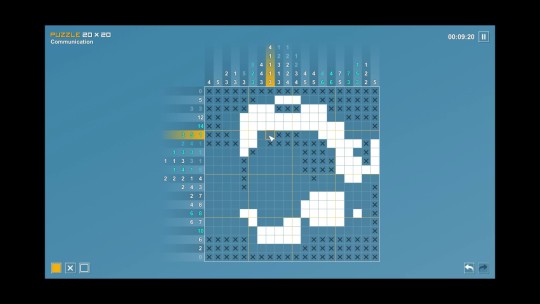
18. Pictopix – Steam – ★★ – 2017
Pictopix is a fascinating lesson that not all Picross games are alike. It's not just a matter of creating puzzles that are secretly pixelized art: there is a flow to good nonogram design that is apparently quite hard to achieve. Where I get a lot of enjoyment from the Picross E- and Picross S- titles, I didn't care for this one, despite being on a platform well suited for a picross-a-like experience. I'm not sure I can even articulate just what rubbed me wrong about it (though the shoddy controls didn't help); the puzzles just felt clunky in a way that other takes on this style of puzzle did not.
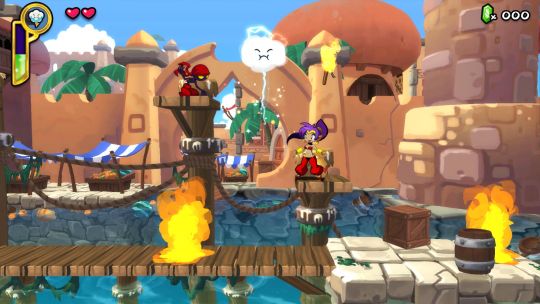
Shantae: Half-Genie Hero – Steam – ★★ – 2016
I accidentally backed this game on Kickstarter a few years ago. I thought an artist I was a fan of was attached to this project, when they just did some contracted promotional material for the Kickstarter. It's on me for reading into that, I suppose. In any case, I backed this game, it came out last year, and I couldn't honestly be bothered to actually play it until this year.
After having finally done so: I'm not sure why people like these games? They feel like baby's first platformer; it's well-produced, but threadbare in terms of mechanical complexity. There's a vague Metroidvania-aspect to re-exploring levels you've already completed, but it lacks the simple mechanical joy that the best of those have. The characters don't really do anything for me either; I presume if you've been following these since the mid-90s you get something from their interactions, because personally I just find it kind of lame? The art is fantastic, and the game looks good in motion, but overall, it's just not for me.
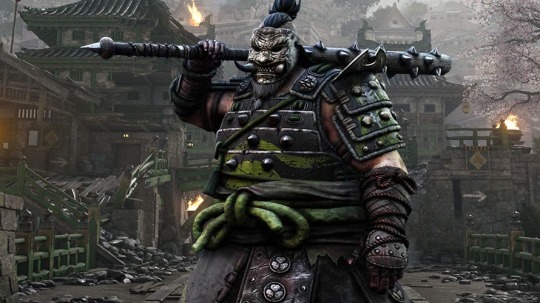
17. For Honor – Steam – ★★★ – 2017
Until I started making this list, I had completely forgot that For Honor even existed. Remember this game? It's the one where you play as an assortment of medieval warriors assembled from across the globe to stab each other in 4-vs-4 3 rd person capture-the-point combat. It was OK, but the experience overall fell flat— largely because of an abundance of flaws peripheral to the core gameplay.
The basic combat and mechanics felt and worked well; the simple axis-based block-or-attack combat system enabled some truly awesome duels that really felt like you were in a melee. But while the combat worked quite well, there wasn't a whole lot going on around it to justify the overall experience. The campaign was functional, but it was clearly an afterthought, bereft of even characters. The multiplayer was fun, but severely hampered by a poor progression / unlock system, as well as bad matchmaking and server issues.
In another year, perhaps For Honor would have stood out more. If the game had received post-release support in the way Ubisoft's more Clancyesque titles, perhaps it'd have had longer legs. As is, I spent enough time with it to know that it was maybe worth coming back to once they had hammered out their online issues— something that never really happened. And then the rest of 2017 happened and put it in its proper place. Oops!

16. Picross S – Switch – ★★★ – 2017
Where Pictopix disappointed, Picross S is functional, acceptable Picross. It's far from the best Picross offering in this line (I think I had the most fun with Picross E3, and not just because of its dumb name), but it is Picross on the Nintendo Switch, which is basically all I was really wanting out of it. The loss of touch screen interactions from the 3DS release is bizarre (the Switch has a touch-screen my dudes!), but I can live with it.

15. Shovel Knight: Specter of Torment – Switch – ★★★ – 2017
It's been interesting to watch Yacht Club take the baseline premise of Shovel Knight— a retro-styled platformer shouting its Mega Man inspirations via megaphone to anyone who'll listen— and alter their execution with these different DLCs. Where the original Shovel Knight was a relatively straight-forward platformer (with Ducktales-inspired down-stab action), and Plague of Shadows was something of an odd build-your-own-shooter, Specter of Torment focuses instead on aerial combo-attacks. These changes really alter the gameplay; where the others could be a bit mindless at times (particularly Plague of Shadows, which was fairly easy given the number of projectiles you could throw across the whole screen), Specter of Torment is considerably more demanding of one's attention; you have to be more deliberate with your actions relying than relying on flow to get you through.
The design of the levels doesn't feel entirely there; while they certainly have been more redesigned than Plague of Shadows' were to fit the different style of movement, it just wasn't that fun to play through. Rooms were either too easy or too frustrating, with little in the way of a middle ground. The boss fights were trivially easy (which is dire in a game aping a series that largely relied on the quality of its emblematic show-downs). The plot was… fine? It certainly was a Shovel Knight prequel alright, that's for sure. At this point, I must imagine Yacht Club and I are both on the page on wanting see them work on something else at this point. They've proven themselves to be extremely competent developers, but it's time to put Shovel Knight to rest; they've gotten about as much blood as they can out of that particular stone.
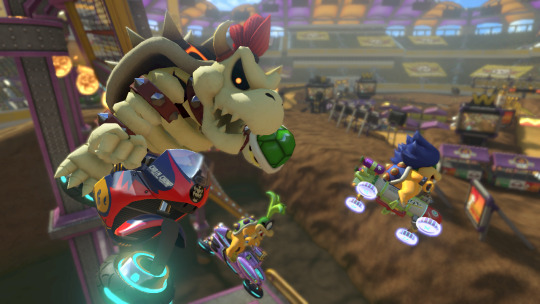
14. Mario Kart 8 DX – Switch – ★★★★ – 2017-ish
OK, seriously Nintendo— when are you going to make a new F-Zero? Don't you give me this bullshit about “Why would you want a new F-Zero when we've already done it before!” when you keep making new Mario Karts with little different beyond the platform you put it on. All Mario Kart 8 DX did was pack-in all the DLC and add a true battle mode— which is great and all, don't get me wrong. It's just a sign that your excuses suck and you need to fund a new Captain Falcon vehicle-vehicle ASAP.
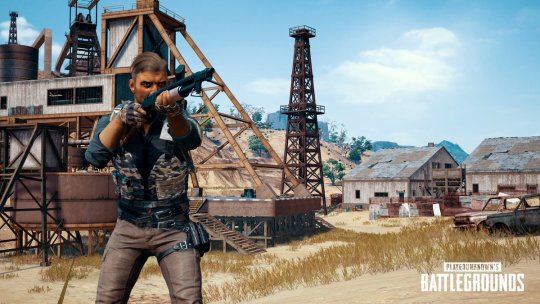
13. Player Unknown's Battlegrounds – Steam – ★★★★ –– 2017
I want to like Plunkbat more than I do, but I don't. What's there that's good is great; the open-world mix of random-luck and skill-based shooting (especially with friends!) is a real hoot, particularly when one is either taking it entirely too seriously or entirely not seriously at all.
But something about the game just feels… incomplete? Despite leaving early access, it really has a lot of work that it should be still getting. The physics is jank (the vehicles annoy me to no end), there's still absolutely 0 tutorializing for new players, and the problem with persistent hacking and aimbotting has been dire as of late. There's also something to the notion that a lot of the skill in the game comes down less to polished learning of the mechanics and their interactions and more a sort of base memorization of Plunkbat Best Practices. That's not innately a bad thing, but I personally find these sorts of experiences better when they're focused more towards tactical mastery than strategic mastery. Both are important in Plunkbat, but I prefer mastering the former over the latter. The game seems to disagree. I feel like the quality of my gear should be less important than how good I am at using what I find. That is not the case. Oh well.
I'm looking forward to putting more time into this with buds in the future, but I've fallen off the wagon as far as general enthusiasm goes. Eh!
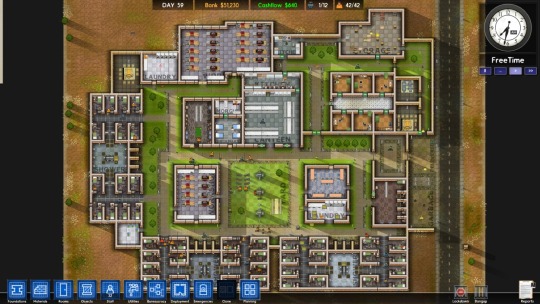
Prison Architect – Steam – ★★★★ – 2015
Prison Architect is sort of a highly-specialized, more accessible Dwarf Fortress. Much of the appeal of Dwarf Fortress is the immersive unpredictability of managing emergent personalities trying to go about their tasks, and ultimately, it's so complex that an ASCII-based rendering is the only way to handle it all. Prison Architect constrains the variability by its very nature (the things people do in a prison are typically well-regulated, and there's not a lot of agency within those bounds), resulting in an experience that is nowhere as impenetrable as Dwarf Fortress— but also nowhere as appealing.
There's just not as much going on when you get down to it; while there's certainly variability in prisoner personality and actions, there are just so fewer variables in terms of what someone can do and interact with. Plus, given your funding regimen and in-take are totally under your control, the actual form your prison takes doesn't need to vary; you're not incentivized to innovate beyond a desire to keep things interesting. You can just your layouts entirely towards efficiency and nothing else, and even then, there's no real end-game to it beyond making numbers get bigger.

Mini Metro – Android – ★★★★– 2015
Mini Metro is a slight mobile puzzle experience, but it is quite engrossing while it lasts. The pairing of simple mechanics and style works very well on the phone. You make subway lines connecting points. It looks like a subway map. It's pretty good.

Total War: Warhammer – Steam – ★★★★ – 2016
I've always been vaguely interested in the Total War games— just never enough to go out of my way to actually, y'know, play them. Warhammer Fantasy has never been my thing, but I like fantasy things in general, and the idea of applying battle tactics to lines of zombies was appealing enough for me to give this a look. Overall, it turns out I enjoy the tactical depth of Total War!
I'm not sure how I feel about the strategic-layer in the few factions I played—it's a bit micromanage-y, and any faction managing to sneak its way to the back-end of your empire becomes a real chore-- but the tactical level is very good. The interplay of artillery, cavalry, and troops-of-the-line is realistic enough to where you can apply real-world know-how and be rewarded for it. The types of troops are massively varied, both inside and outside of the factions. I was mostly drawn to this game by the monster-y factions, so those were the ones I played most.
I'm looking forward to checking out Total War: Warhammer II... eventually?
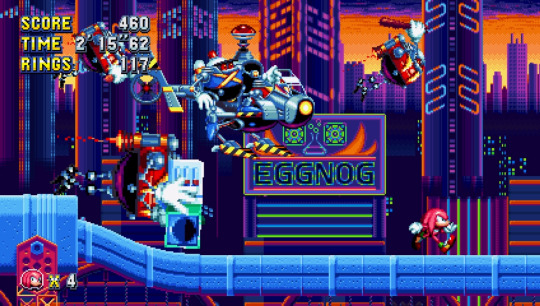
12. Sonic Mania – Switch – ★★★★ – 2017
Sonic is bad. If you add up the total of what Sonic has been over the last two decades and average it out over the amount of games he has had the misfortune to appear in, the average Sonic is hardly deserving of the fawning devotion he receives. Those first few mainline Sonics were good, no question—but that was over two decades ago. SEGA has never succeeded in recreating the feel of those games—even when they have ostensibly tried.
Thankfully for them (and us), there are those that can succeed. Sonic Mania, created by long-time Sonic fans and hackers, perfectly captures the feel of those first three games almost too well. It's basically Sonic 1-3+K+CD, warts and all. The Sonic CD-based stages in particular carry on Sonic CD's design of being too long and really fucking annoying, which is rather indicative of the ethos of Whitehead towards recreating the feel of the older titles. I'm very curious to see if they'll be given permission to do a Sonic Mania II, where they'll perhaps have a chance to innovate more and burn off those warts. I'm not sure if they would, but I certainly hope they do. Sonic deserves better than, well, Sonic.
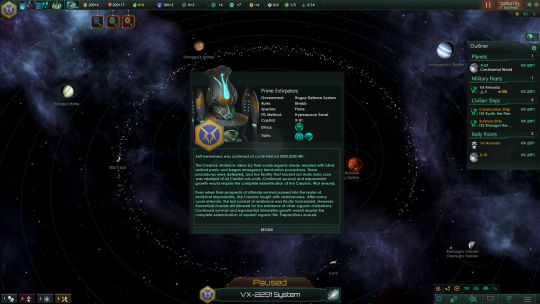
Stellaris: Utopia & Stellaris: Synthetic Dawn – Steam – ★★★★– 2017
This is technically a 2017 release, but it's so miniscule an addition to the existing Stellaris that it's not worthy of a numbered ranking. Stellaris in 2017 is a lot like Stellaris in 2016, but better. The addition of end-game specializations, new government-types, and the ability to play as both hive minds and robots are extremely good, but there's still a lot of room for improvement. That's the Paradox model, I suppose; they'll continue iterating and adding onto Stellaris over the next half decade until it finally achieves some near-ideal state—or the engine buckles under all they're trying to do with it. One of the two.
My favorite Stellaris moment this year must be the creation of "The Borth Problem". The Borth are a race of space Hyper-Platypuses, whose traits were specially selected by their creator (me) to be absolutely trash. They're short-lived, xenophobic pacifists who hate being around each other almost as much as they hate being around everyone else. I force them to spawn as one of the empires in every game I play-- not because they're particularly threatening, but because watching them repeatedly balkanize every two months under the strain of their own ineptitude and malfeasance is extremely good. Occasionally some fool attempts to annex Borth planets, which is a tragedy in and of itself.
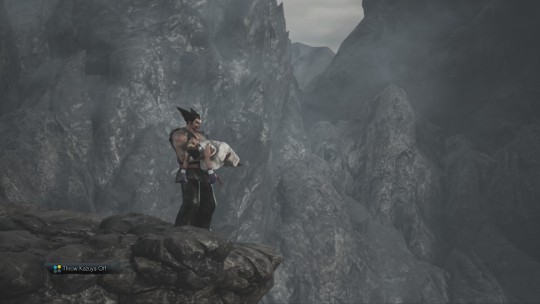
11. Tekken 7 – Steam – ★★★★ – 2017
God am I terrible at fighting games. I've just never put in the time to get any good, and I'm way too prone to mashing out moves I think are cool than learning combos or hit-strings. God do I love fighting games though— and Tekken 7 is a good one. It is a Tekken game through-and-through, but the additions they've made to the cast have been good, and the limb-specific combat system continues to hold up after all these years.
To be completely honest? I've been playing mostly as Eliza—whose special strings are just Street Fighter entry strings. She's basically Ryu if he was in a bustier (and a sleepy Dracula). It's allowed me to get past the hump of learning how to pull-off her specials, though it's done little to actually get me good at stringing combos together. It's still a lot of fun though.

10. Puyo-Puyo Tetris – Switch – ★★★★ – 2017
IT'S PUYO PUYO AND TETRIS, WHAT ELSE DO YOU WANT FROM ME?
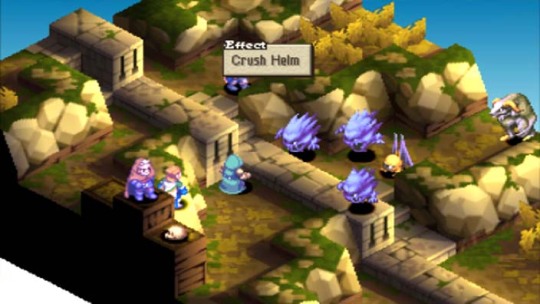
Final Fantasy Tactics: War of the Lions – PSP – ★★★★ – 2007
Coming to Final Fantasy Tactics two decades on from its initial release on the PlayStation, one can still understand the appeal. The tactical RPG system has phenomenal mechanical depth, supporting wide-ranging customization and gameplay specialization. There's lots of weird systems to learn and exploit. The setting is austere and grounded in a way that few RPGs are; the story it tells is ultimately yet another Japanese tale of man-killing-god, but the way that it's presented is more about fighting back again the abuse of systems by society, and the futility of one man trying to change the world.
At the same time, two decades have passed since Final Fantastic Tactics came out, and it honestly has not aged superbly well. The controls are bizarre, its job system is rather annoying in practice, it suffers from the usual problem games with permadeath carry where the second a character joins the party and becomes non-essential, their relevance to the story ends. The story which was apparently once so astounding seems almost quaint now; “Organized religion… may be bad!” is far from a hot take in these days, and there have since been hundreds of other games (JRPGs, even) playing in the same sandbox.
As someone introduced to the Ivalice setting of Final Fantasy through Final Fantasy XII, it's also somewhat strange looking back at this series and trying to conceive of them as some connected timeline. A lot of what I liked about Final Fantasy XII was its diverse races and their cosmopolitan associations and interactions. Tactics has even less than none of that. It goes out of its way say with a ringing finality “AND EVERYTHING NOT HUMAN OR DEMON WENT EXTINCT, THE END.” Pour one out for my Ban'gaa homies, I guess??
I had fun with Final Fantasy Tactics, but I suspect I may have had a miserable time if I didn't have a friend warning me of points-of-no-return and making sure I didn't build myself into an unwinnable state. Also: exposing me to the utterly broken arithmetic / mathematics magic system, good lord.
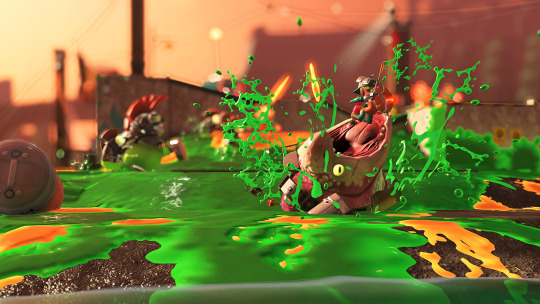
9. Splatoon 2 – Switch – ★★★★ – 2017
Splatoon was a good game; Splatoon 2 is that same game, on a different platform.
The additions made to Splatoon 2 are really quite minor; there's some slightly different weapons, and the campaign is denser, but all in all it's just the same good game. The only meaningful addition to Splatoon 2 is Salmon Run, Nintendo's take on the cooperative Horde mode. And you know what? Salmon Run fucking rules. My best multiplayer experiences this year were playing Salmon Run with my boys on Discord. If it were more reliably available, I'd probably have played it more!
youtube

8. What Remains of Edith Finch – Steam – ★★★★ – 2017
The latest in the Walking Simulator genre, What Remains of Edith Finch is low on the interactivity, but high on the graphical fidelity, atmosphere, and emotional heft. Sometimes that emotional heft veers into the realm to over-sentimental schmaltz (the ending engendered some real roll-eye), but it doesn't diminish the overall experience. What interactivity that is there is quite good, and it all-in-all made for a great evening experience. I like these sorts of evening-games where you can plop down for 4 hours and just have a nice, self-contained emotional experience.
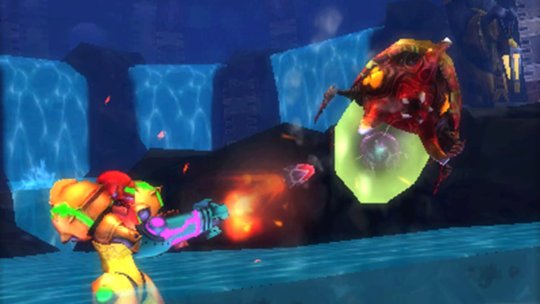
7. Metroid: Samus Returns – 3DS – ★★★★ – 2017
Maaan, it's good to see Samus in a properly ass good video game again. Other M was bullshit that I wasn't down with at all; this is some proper Metroid-ass Metroid. While there's perhaps still a bit too much Metroid 2 in there (the game is remarkably linear for a “Metroidvania” and the area design is a bit one-note – befitting its Gameboy origins), Metroid: Samus Returns is a very excellent proof of concept that yes, you can make a good Metroid in 2017.
It's also proof that even if we can no longer trust the franchise to Sakamoto's hands without him ruining everything and throwing a tantrum about Prime, others are capable of doing what's necessary to ensure that Samus remains a galactic badass and not Sakamoto's weaponized nadeshiko. Uugh.
As an aside: The references back to the Prime Trilogy, as well as the REALLY WELL-HIDDEN sequel-hook, are extremely good and appreciated. I am pumped to see what Mercury Stream (or someone else!) does with Metroid moving forward. Is that sequel hook actually a Metroid Prime 4 hook? That'd be cool as hell.

6. SteamWorld Dig 2 – Switch – ★★★★ – 2017
SteamWorld Dig was a relaxing, though ultimately rather forgettable take of what would happen if you crossed Metroidvania with Mr. Driller. SteamWorld Dig 2 would be the same, if it wasn't for the fact that it's just so god damned well-polished. Everything about it from the core gameplay feel, the movement, the digging speed, the music— they're just so damn well executed. The game world is just a delight to be in.
The story and ending are disappointing (as legally required of every SteamWorld game) but that's not really the point; this is absolutely a game where it's absolutely about the journey rather than the destination. When your journey revolves around such a fundamentally satisfying gameplay loop, the greatest sin it has is ending in the first place.
youtube

HITMAN – Steam – ★★★★★ – 2016
HITMAN is good! IO Interactive has created the ultimate encapsulation of the Hitman formula. The game is built to encourage replay and iteration on the game's limited number of maps. This is great, because replaying missions to achieve the perfect murder is a real joy. HITMAN is a game about perfecting the art of playing it: learning the systems, the maps, and the routines of people to the point where you see the clockwork that everyone else is beholden to— so that you can slide between the cogs like a bald, sardonic time-ghost. The game is grimly hilarious and cool in equal measures. I can't wait to see what they do with Season 2.

Stardew Valley – Steam – ★★★★★ – 2016
Stardew Valley is a celebration of the routine. While so many games are about providing novel experiences and spectacles to keep our interest, Stardew Valley enables you to a build a routine, iterating and adapting as the world twists and turns around it. It's about riding a slowly swelling wave while maintaining flow; your farm and experience gets more and more complicated as the seasons go on, but it's always at your own pace; there's no real stakes beyond a desire to prosper and discover. It's charming and addicting in equal measures.
I'm glad they stopped development on it to focus on porting it to new platforms, because I'm pretty sure they'd have honest to god killed people with it. It turns out the cup-and-ball game from that Next Generation episode is actually a game about pleasing your peepaws' ghost by growing corn and hooking up with the goth chick down the lane. You're welcome, peepaw.

Valkyria Chronicles – Steam – ★★★★★ – 2016
Man, SEGA used to make brilliant RPGs back in the day, huh? I really liked Skies of Arcadia, and this is another RPG in that vein from that era. You wouldn't think “fantasy World War II European Front through the lens of Japanese RPG developers” would work, but… it does! They manage to evoke some genuine ethos, and their depiction of the brutality and horror of war, the in-grained senselessness of inherited discriminatory beliefs, are actually pretty OK. You'd think “We're going to depict ANIME FANTASY HOLOCAUST” would be the Worst Thing Ever, but they manage to thread that line enough to make it work… mostly.
Perhaps the craziest thing about Valkyria Chronicles though is that they somehow managed to make a tactical JRPG about trench / tank warfare not only work, but work well. While it's kind of breakable in areas and has balance issues, it managed to hold my interest through the dozens of hours without getting bored. I wasn't invested enough to do much in the way of the extra / repeatable missions, but I thoroughly enjoyed the combat for what I played.
That all said, Valkyria Chronicles could have done with less anime all around. If you turned that anime dial down a good 20%, this would have been a vastly superior work— perhaps even an all-time great. Unfortunately, its tendency towards Anime-ass composition and design, and some frankly juvenile characterization means it will forever carry that stigma of “it is very anime” that prevents it from penetrating into less anime-immune audiences. Still, for those willing to give it a shot and endure some really ham-fisted anime-as-all-hell ruminations on peace, Valkyria Chronicles is a real gem.
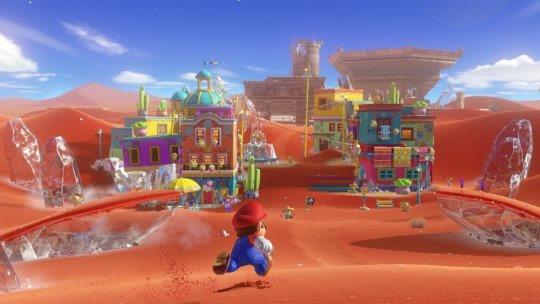
5. Super Mario Odyssey – Switch – ★★★★★ – 2017
The single thing that has defined Mario since the halcyon ape-threatening days to his hat-tossing present has been his movement. Over the years, the movements available to “Jump Man” have become more varied and complex, but they still harken back to what set him apart in the beginning: it's all about the jump. Mario Odyssey, while ostensibly about his more obvious hat-trick, is in reality just another stage of the gradual, ever-evolving repertoire of Mario's jump. He just… jumps so damn good y'all. It feels real damn good to run around and jump on shit as Mario. The hat even makes it so he can basically jump in the air, it's ridiculous.
Mario's new ups are made even better Mario Odyssey's excellent collections of worlds for him to mark with his kicks. The sheer variety and volume of unique platforming experiences is great, and it's ultimately up to you how deep you're willing to take it. Mario is something of a casual completionist's nightmare, given just how many stars there are to find. But for those willing to take a step back, the game allows you to engage it just as much you'd want. You could work on polishing your platforming skills to where you easily master the Darker Side of the Moon, you could just play enough of the game after “beating” it to get your fill, or you could just play what's needed to get to the credits. If you're a complete mad-person, you could try even collecting all those stars. All are valid end-points, and no matter what the experience is a complete and quality one.
Some one-off thoughts:
The new enemy designs in the game are so good. A particular shout-out to the Oni Thwomp!
THERE IS A BOSS WHOSE NAME IS “Brigadier Mollosque-Lanceur III, Dauphin of Bubblaine”, FUCK
Steam Garden's God Hand surf rock theme music is so good
The entire end-game sequence leading into the post-game zone was one of the most surreal things ever
NEW DONK CITY
youtube
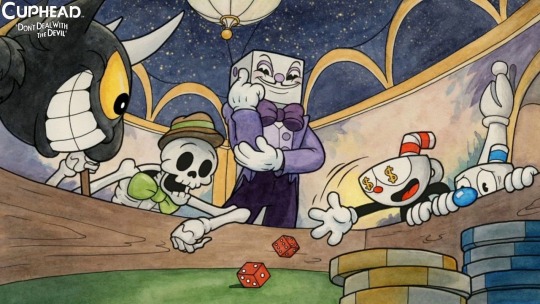
4. Cuphead – Steam – ★★★★★ – 2017
Cuphead is a magic trick. At first glance, it seems impossible, like an actual sorcerer has walked in and done something impossible. “There's no way anyone could recreate the style of Fleischer-era cartoons and make a genuinely good video game!” Like any magic trick, once you look at it long enough the magic goes away, and you see it for what it is. You see the sleight of hand, the smoke and mirrors required to resurrect a nearly century-old style and make it work in what should be a wholly incompatible medium. But the skills required to pull that trick off, and that such a small studio accomplished it, is itself a feat worthy of a wizard with a sizeable beard. It's not perfect, but it's as damn close as any person could ever expect to see, really. The game looks, sounds, and plays damn good.
It's been funny following the discourse around Cuphead's gameplay, particularly the reaction to its difficulty. It's nowhere near as hard as people make it out to be; it's got a lot in common with bullet-hell shooters like the Touhou games, to be sure, but the difficulty about those games, like Cuphead, are more about learning how to play them right than anything particular crazy about most of the challenges they put in front of you. Once you learn how to precisely move the character, you can basically relinquish yourself to the flow state and soldier through pretty much everything (within reason). Cuphead's real trick in this regard is that the types of things going on screen look so fucking cool that it can pull you out of the flow through sheer wow-factor. It's a game that is harder because it looks so good. Unreal.
youtube
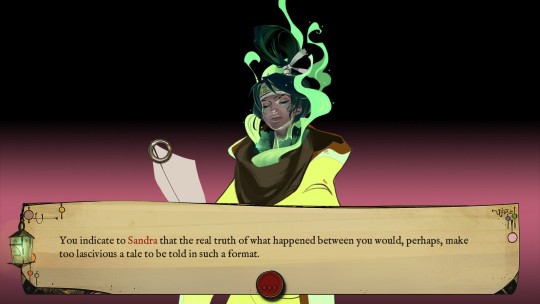
3. Pyre – Steam – ★★★★★ – 2017
The cruel hands of mother nature have evolved Supergiant Games into the perfect predator of my species. Their approach to writing characters, stories, and music is such that whenever they release one of their games, they burrow a tendril into my brain and maneuver my zombified body into a hole so they can lay eggs in my chest cavity. I'd feel more broken up about how they play me like an acoustic guitar if they weren't so, y'know, good at playing acoustic guitars.
Ostensibly, Pyre is NBA Jam meets Oregon Trail meets a Visual Novel, but it's so much more than that. It's the archeology of uncovering the history of a world through half-heard conversations and vaguely-written reminiscences. It's the trepidation of holding the fate of friends in your hands and knowing that you can't save them all in the end, and still having to choose. It's the struggle for glorious revolution, even though the odds of a bloodless one is low. It's all these things. You plot the end of an empire with a pipe-smoking treeman in between games of mystic slamball with a mustachioed dog. Everything about how it carries itself and presents its world resonated deeply with me and held me enraptured to the very end.
youtube

2. NieR: Automata – Steam – ★★★★★ – 2017
I've spent a lot of the last year thinking about Nier: Automata. At this point, I'm not even sure what to say about it. Do I talk about the questions it raises about humanity and what we may leave behind? Do I talk about its astounding visual and audio design? Do I go on a long aside on Yoko Taro's writing and directorial style? They're all valid things to talk about, but they're also all meaningless. They're only important in how they made me feel over the course of my journey with Nier. Intrigued, lost, depressed, uplifted. Nier: Automata invoked all these emotions in me in turn.
In the end, I'm left somewhat in awe of the experience. Not because Nier is a perfect game; it's a very flawed one. But it's a game that's really made me feel and think. Yoko Taro weaves the threads of narrative, emotion, and atmosphere with the deftest of hands. So what if the loom he was forced to work with wasn't a particularly good one? Nier: Automata is one of the most complete explorations of the nature of humanity and how impossible it is to grasp. I imagine I will carry thoughts of it with me forever.
youtube

1. The Legend of Zelda: Breath of the Wild – Switch – ★★★★★★ – 2017
Breath of the Wild is my favorite video game of all time. Thanks, Nintendo.
youtube
#game of the year#2017#nonfiction#think piece#breath of the wild#nier#pyre#cuphead#mario odyssey#valkyria chronicles#final fantasy tactics#hitman#steamworld dig 2#stardew valley#Stellaris
15 notes
·
View notes
Text
The Ongoing Narrative Evolution of Attack on Titan
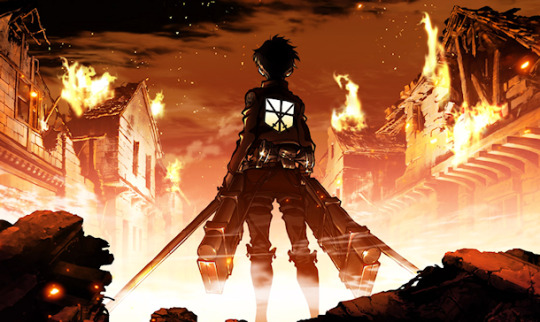
Hajime Isayama’s Attack on Titan (or Shingeki no Kyojin, if you’d like) is, at first blush, little more than a particularly smart and stylish take on the usual apocalyptic-horror formula: existentially-terrifying monsters in a world already lost, with a heap of unanswered questions. This conceit is ubiquitous these days; it’s at the core of hundreds of zombie and zombie-like apocalypse narratives scattered across a dozen different mediums.
How did world get into this mess? How does one survive in a world like this? Is it possible for society to survive in a situation like this? These questions form the backbone of fiction like Attack on Titan— internally within the narrative itself and externally in how the audience engages with it. One of the fundamental weaknesses of most zombie-like narratives is an inability to move past this core conceit and answer any of the questions. Few even try— as to do so might undermine much of the fundamental appeal of the narrative: the life-of-death tension and unknowable nature of the mystery.
Attempting to evolve the narrative past the status quo (no matter how unstable that status quo may logically be) runs the risk of alienating an audience who became engaged with the work because of that status quo in the first place. Oftentimes, the questions raised are far more interesting than the answers, and authors sometimes have no actual answer in mind when they ask these broad-sweeping questions in the first place. At the same time, maintaining a status quo indefinitely is boring; it’s at the core of why zombie fiction is so same-y and garbage.
One of the things that’s most remarkable to me about Attack on Titan is how it is not only willing to abandon the initial status quo, but continually evolve and develop the concept of the narrative while not betraying the themes and events it began with. It’s natural in a way that most apocalyptic monster stories aren’t. It continually raises more nuanced, challenging questions while answering older ones, and each new status quos raised is as perilous as the one that preceded it— just more complicated and nuanced.
Very little of what I’m talking about here is particularly revelatory if you’ve been keeping up with Attack on Titan, and if you haven’t been this discussion is going to amount to little more than the world’s strangest Cliffs Notes. I just want to nail down just how much Attack on Titan has been successfully evolving its themes while staying engaging, largely for my own satisfaction having just recently caught up. Spoilers for Attack on Titan through Chapter 98 after the break.
Much of Attack on Titan’s initial appeal came from its basic aesthetics. The imagery of sword-wielding techno-spider-men fighting giant naked man-eating men is at the core of why the anime was instantaneously popular, and why the manga blew up in the first place. But it’s fascinating how quickly it moved past being just that. In a way, Attack on Titan has undergone a continuous, evolutionary process— resulting in increasingly complex thematic phases that we can point to.
The initial premise was the simplest. The last remnant of humanity lives in a walled city that keeps horrible man-eating giants out. Life sucks. Then the titans breached the walls! The lead character, Eren, becomes an orphaned refugee after a titan eats his mother right in front of him, and enlists in the scout legion to try to get his home back, and get his revenge. But things suddenly turned in just a single volume’s time, when by a titan eats Eren… and inexplicably he transforms into an intelligent, sentient titan who wrestles the bad ones!
The immediate reaction by many to this twist was rather negative— which isn’t that surprising. After all, it seemingly undoes the base premise of the series, and forces another greater suspension of disbelief just after people had come to terms with Attack on Titan’s definition of “reality.” Isayama sold them a bill of goods that promised nasty naked boys eating spidermen; a sudden twist towards what first glance seemed to be rank power fantasy of “I AM THE NAKED GIANT BOY NOW, I SHALL DESTROY THE GRAVEYARD SMASH” was something of a ‘betrayal’ of the darker themes that had brought them in in the first place. But those who gave this course change a chance discovered that rather than the narrative becoming simpler, it was WAY MORE COMPLICATED. Before Eren became a titan, we had no idea what the titans were, or where they came from. After he became a titan, we had even less of an idea, as the evidence we now had was so fragmentary and seemingly contractor as to defy most speculation. The general question of the setting (“How?”) became an outright mystery (“What!?”). What was the connection between humans and titans, and how the hell did Eren manage to turn into one and back again?
This turn also really kicked off what’s been a central aspect of Attack on Titan ever since: politics. The revelation of Eren’s ability was an incredibly political one; what was to be done with him, and what was the motivation of those now wanting him dead? The revelation that there was in fact a deeper connection between titans and humans suddenly brokered a great deal more suspicion in the actions of both the humans and the titans.
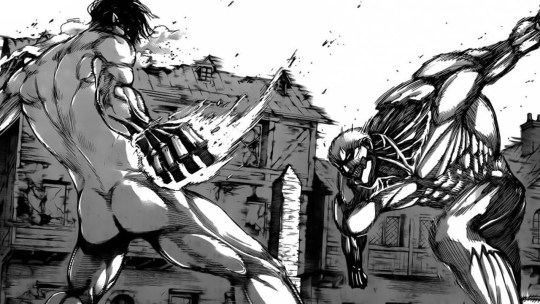
This paid off with the next major twist, when an expedition attempting to make use of Eren’s abilities was attacked by another titan that seemed to be under human control; others had the same ability as Eren! The narrative shifted from being “man vs monsters” to “man vs man, contextually monsters” as the titans took a role less as primary threat and more a backdrop for the conflict. That these “manned titans” seemed to be behind the deliberate compromising of the wall years previously resulted in a massive shift in the overall tone and nature of the mystery. The existential question was now less “Why is the world like this?” and more “Why would someone do this?” and “Who did this?”
The conflict was no longer us vs an inhuman them; who the enemy was no longer as clear. Who could Eren, and us by extension, trust? Those in charge seemed awfully like they knew way more than they let on, and it turned out that several of Eren’s compatriots from his training were the titan-changer sleeper agents, and were those who caused his family and thousands of others to die. But even stranger, these titan-changers in their midst impossibly came from some place outside the walls— which contradicted all we knew about the outside world.
But we had little time to dwell on this, as Eren and the scouting legion… initiated a coup de ’tat!? The government was quite clearly complicit in the state of things, willing to throw away millions of lives to maintain the precarious status quo and keep their hold on power. To do so, they attempted to seize Eren, triggering the coup. This finally moved the conflict to one purely “man vs man”, with the titans becoming little more than raison d'être. The coup ultimately culminated with the crowning of a new, more cooperative monarch, and the revelation that the nation’s isolation and regressive state was foisted upon it by its former rulers. We also began to learn more of the true nature of the titans: that they are created, that the power to become a titan can be transferred, and that it all somehow ties into the overthrown royal bloodline.
It seemed like oh so soon, we would be able to answer the ultimate mystery of the world. Eren gained his titan power thanks to a serum his father had given him right after the first wall collapsed, he seemingly having come from some place outside the walls just like the titan-changers. All the scouting legion needed to do now was take back the wall that had fallen all those years ago, and pull from its ruins the lost secrets of Eren’s father. Unfortunately, the titan-changers too knew of this goal, and it culminated in a pitched battle of titan versus titan and man versus titan, against those who had destroyed the wall.
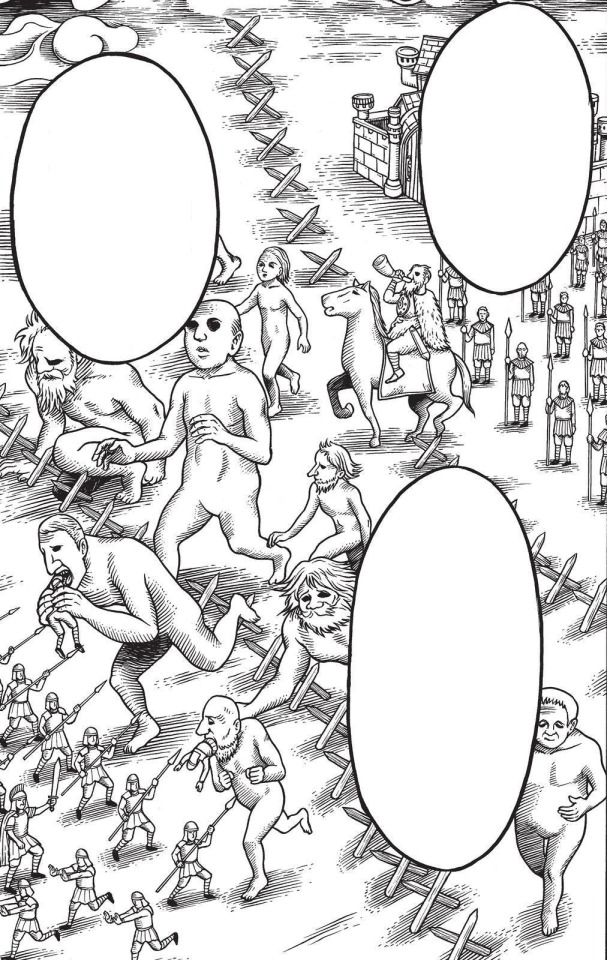
The victory, at tremendous cost, brought the greatest revelations and shifts in the narrative of all: the conflict had always been one of man vs man. The walled nation that they thought was the last bastion of humanity? Little more than a single isolated kingdom, whose citizenry was of a seemingly cursed bloodline with the ability to transform into mindless titans— as well as to inherit the ability to become an intelligent titan. The titans hadn’t destroyed the rest of the world; they were amid an industrial revolution! The titans on the island were little more than dissidents from a beleaguered ethnic minority, transformed into monsters and released there as a last cruel insult to a nation that once ruled the world.
And now we truly see that nation at large. Those once oppressed by the titans now use them as weapons in World War I-era armed conflict, turning non-citizens kept in ghettoes into living weapons in an exploitative military machine. It’s far beyond the simple cruelty of man fighting monsters; true horror always belongs to the cruelty of mankind alone. Eren and his homeland don’t need to kill all the titans, or even defeat some narrowly-defined enemy; the world is their enemy. By their very birth, they are hated, used, and discarded. And how do you fight that? You can’t spiderman that away.
It seems their answer is to repay it in kind. Eren has infiltrated the home of those titan-changers who had once infiltrated his own. To what end? We don’t know yet. But I’m really fascinated to find out; it’s a total inversion of the concept we started with, and it took a hell of a ride to get here and have it feel like a natural extension.
19 notes
·
View notes
Text
My Hero Academia’s hero and villain are not very good

My Hero Academia, Kohei Horikoshi’s shounen manga take on Western super hero comics, has been running nearly three years now. I am something of a binge-reader when it comes to media; I don’t care for the drawn-out schedule that comes from following serialized releases. But My Hero Academia (alongside One Piece, Berserk, and One Punch Man) is one of the few that I actively follow. Lately though, I’ve been wondering why.
It’s not that the comic has taken a particularly egregious downturn in quality or pacing – it’s been fairly consistent all in all. The current arc about the class becoming intern sidekicks has been interesting, and it’s been moving at a rather brisk pace. The issue I’m struggling with is more fundamental. It’s a problem My Hero Academia has had since the beginning, and it’s done little to ameliorate over time.
The main protagonist and antagonist of My Hero Academia are just not very good.
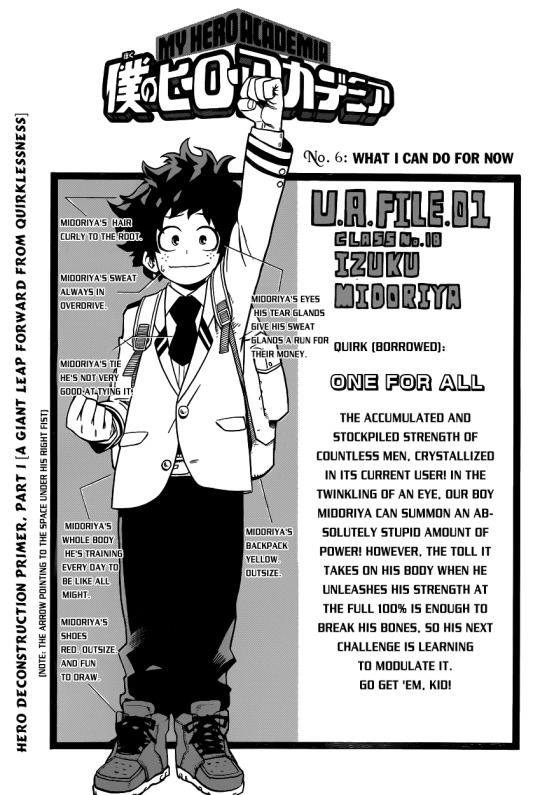
The lead of My Hero Academia, Izuku Midoriya, isn’t a bad character per se. The angle of an ordinary kid born into a society of supermen finding himself entrusted with power by his world’s urhero is a pretty good one. It’s an underdog story with tons of good karma built in as Midoriya is forced to struggle to surpass those who had mocked his lack of abilities. It’s also good for hitting those power-fantasy notes that are so crucial to making the shounen genre work. He’s earnest and likeable. It’s easy to root for Midoriya and put yourself in his shoes as he is manages to pull himself to the front of the pack by sheer heart and willpower alone. These are all good attributes for a protagonist in a heroic work!
But as time has gone on and as his powers have developed, he has ceased to be the underdog. Where he was once only keeping up with his classmates’ inborn genius by hard work and determination, now he’s not only the most driven but also the most talented. Midoriya’s climbed what should have been the first foothill on his journey to the top, and we’ve found that there is actually nothing else on the horizon— the foothill was the mountain. Midoriya’s journey of growth being essentially complete is dire, because it’s all Midoriya actually has: It turns out he’s REALLY boring.
Midoriya’s character revolves entirely around his desire to become a hero and imitate the super hero paragon, All Might. That’s it. This is literally all there is to him. He has no other interests. No particular ambitions beyond the dream to be The Best Hero. The only real struggles remaining for him are narrative happenstance and the gradual power-ups that are practically prescribed at this point. There’s nothing else to his story.
Here’s an example: In order to convince All Might’s former side kick to give him an internship, Midoriya has to make him laugh. This isn’t going to be easy; the sidekick is a straight-laced nerd, AND he has the ability to see the future. This concept has a lot of good goof-potential. You could conceive Midoriya in all his earnestness constructing an elaborate comedic scenario that, while perhaps falling on its face, would at least show off his good qualities. Maybe he’d screw up and it’d result in the kind of unplanned comedic pratfall that would be easy for the sidekick to laugh at.
Instead, what does Midoriya actually do? He does a bad impression of All Might of course, because “I want to be like All Might!” is his entire character! It pisses off the sidekick so much that the whole laughing angle is completely abandoned, and instead a scenario is contrived where Midoriya has to steal the approval stamp from the future-seeing sidekicks hand. Ultimately? He gets the internship because he didn’t damage any of the All Might memorabilia in the room. Midoriya’s All Might-mania would be a funny gag if it wasn’t the crux of who he is.
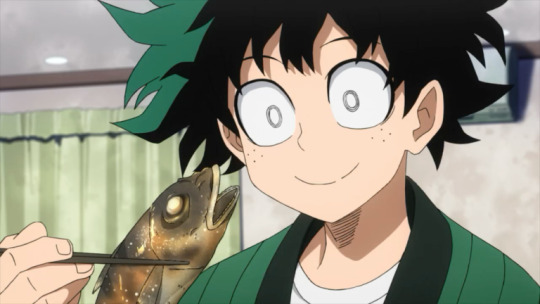
The only other aspects to Midoriya’s character beyond his hero-crush is his very typical shounen budding romance with Ochako Uraraka (that has not and will not ever be developed until the very end of the story, as is the staid shounen manga way), his willingness to occasionally break the rules in order to save lives (and then let McGruff the Crime Dog unironically say that he should have let his friend be murdered in front of him), and a mostly one-sided rivalry with his childhood bully Katsuki Bakugo. Only the rivalry actually feels that impactful to the story, and that has more to do with Katsuki’s personal arc than Midoriya’s.
The issue isn’t that Midoriya doesn’t have any major flaws necessarily – though that certainly doesn’t help – it’s more that there’s not much else to his personal story at this point beyond the narrative events unfolding before him. He fundamentally lacks agency and meaningful personal struggles. Things happen, and he reacts to them; his arc is essentially complete. It’s a foregone conclusion. His single-mindedness makes the story flat in a way that it really need not be.
Narratives revolving around villains doing nefarious things tend to lead to reactionary heroes, but the best heroes are ones who are more than just the mask—they’re also people. Peter Parker has a day job, has to deal with people trying to constantly hunt him down and kill him, and has to fight to balance his romantic dalliances with the responsibilities of being Spider-Man. Bruce Banner may fight the occasional radiation monster, but the Hulk’s story is more about his struggle with his own inner demons than him punching real ones. Hell even Superman, the poster Generic Nice Boy, tries to have a personal life beyond the cape and liven up his Fortress of Solitude.
There’s more to good stories than Good Man Beats Up Bad Guy. While personal struggles can be completely ancillary to the action at hand, they can also be far more challenging for the hero to surmount and far more engaging. Even if the are trivial, that doesn’t make them unimportant. Diversions may not matter much to the ongoing “plot” always, but they give the characters character. Something as inconsequential as the heroes going out to get Italian food can be huge as far as characterization goes; it speaks volumes to the interests of the characters, it humanizes them, and makes their situation more relatable.
The tragic thing is that there are major characters in My Hero Academia who would make for far better protagonist material than the actual lead if the story had been built differently. The frog-girl Tsuyu Asui is a good example. She’s been raising her siblings on her own while going to hero school due to her parents being constantly away at work. Her powers seemingly have low potential (she does whatever a frog can do), but she rises to the top by being smart with them. She wants to become a hero to help people— but seemingly doesn’t have too much of an interest in getting into the bad-guy fighting side of things. Throughout the story, she’s also wrestled with the whole legality / morality of saving people without a license, which frankly the most under explored aspect of the narrative by far given how weird and complicated the subject matter is. These are all interesting angles that easily have been built out to create a different, more engaging My Hero Academia.

Not having an engaging protagonist for your narrative puts a greater onus of the villain being interesting. For My Hero Academia, this is a BIG problem. If the hero Izuku Midoriya is uninteresting, the main villain Tomura Shigaraki is outright lame.
As is the super hero convention, Shigaraki is dark mirror of Midoriya— where Midoriya is a child who looks up to heroes and wants to grow up to be like All Might, Shigaraki is a man child who never grew up, doesn’t like heroes, and wants to murder All Might. And just like Midoriya that’s literally all there is to him. He has some kind of tragic past due to heroes not saving him when his parents died, but even that’s paper thin. Ultimately, he’s just a petulant kid who never grew up; he occasionally sends mutants his spooky adopted dad made for him to punch trucks. Because that’ll show ‘em.
The narrative openly acknowledges the fact that he doesn’t have any particular beliefs beyond disliking heroes. Other villains with actual raisons d’etre confront him about it, and he no joke throws a tantrum over the fact that they have views. Like Midoriya, the single-note nature of the character comes across as borderline comical. (Also: his character design looks stupid.)
Villains, like protagonists, need motivations to be compelling. That motivation can be as small as being a crazy mofo or just plain greedy, but it should at least be understandable. Shigaraki isn’t a revolutionary— he’s a child with a gun. An inordinate amount of power has been thrust into his hands for no particular reason. That doesn’t actually make him feel like that great of a threat to society as a whole; it just makes him a deadly nuisance if anything. Earthquakes are unpredictable and can hurt a lot of people but that doesn’t make them particularly compelling villains.
Villains need to be likeable. Not necessarily as a people— far from it in most cases, really. But they need to have some trait that is inherently admirable to make them work as the foil for the protagonist. In X-Men, Magneto is a fantastic villain because he’s ultimately a flawed idealist; his charisma and the fact that his views sometimes seem attractive is what makes him so compelling. He’s complex. Single-mindedness too can be admirable if it’s portrayed well. Kira Yoshikage, despite being an outright serial killer still has admirable traits in just how ruthlessly efficient he is at maintaining his “ordinary life”. That doesn’t make him less reprehensible— if anything those traits are what makes him so potent a threat, far more than his murderous tendencies.
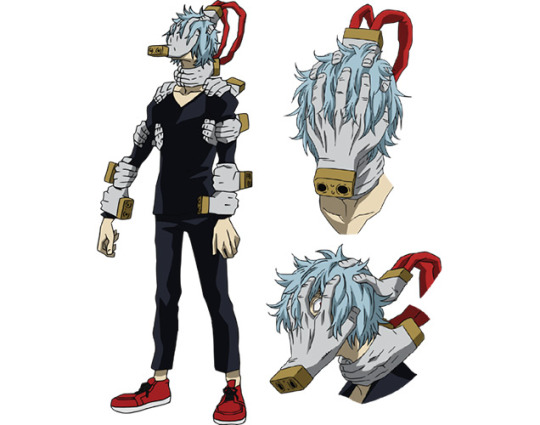
Totally uncharismatic antagonists can work as small-bit villains – but there’s a limited lifetime for which their existence is tolerable. Past that point, their continued position as a central part of the narrative just becomes annoying, if not totally implausible. How are we the audience supposed to believe that Shigaraki can amass followers and inspire loyalty in them when we cannot muster the slightest bit of admiration for him ourselves? He’s not even shitty enough for it to be played up for comical effect!
This situation is all the more crazy when you remember that My Hero Academia serializes alongside One Piece. One Piece’s Oda Eiichiro has writing good bad guys down to a science. His bad guys range across the whole spectrum, from the immeasurably bad at their job to the point where you’re actively rooting for them (who the hell doesn’t like Buggy the Clown?) to the dark-mirror of the lead that you just love to hate (Blackbeard you monstrous son of a bitch), to a whole heap of over-zealous enforcers of law and order (go to hell Akainu). Oda’s a master at manipulating the audience’s feelings and creating characters that work in both short and large doses. Characters with short-lived appeal are dealt with appropriately, while those more sweeping interest and unexplored complexities are kept around for years. Oda will occasionally even turn past arc’s main-villains into bit-players in ongoing ones. Knowing when and how to subvert expectations like this speaks a lot to Oda’s abilities at constructing characters and narratives.
The sad thing is that I just can’t see Kohei pivoting with My Hero Academia. The trajectory My Hero Academia is on looks to be the one it’ll stick to for the future. The foregone conclusion of Midoriya’s journey is in plain sight; while I’m sure the ongoing story will take some amount of twists and turns, there’s not a lot of mystery left in how Midoriya fits into it. Shigaraki taking his place as the main villain is outright uninteresting and unappealing at this point. While the actual writing of characters and the flow of the chapters is good, the broader sweep of the work viewed from a weekly-perspective now leaves something to be desired.
I suppose there’s nothing left for me to do at this point than to let it fall to the wayside and just read at my own pace when more of the material is built up. Actively following a work as it releases requires considerably more personal investment, and I’m not sure I can muster that for this story anymore.
Oh well!
#think piece#nonfiction#writing#my hero academia#midoriya izuku#shigaraki tomura#super heroes#manga#anime#media
43 notes
·
View notes

